If you would like a printed copy of any of our back issues, then they can be purchased on Farm Marketplace. You can also download the PDFs or read online from links below.
-
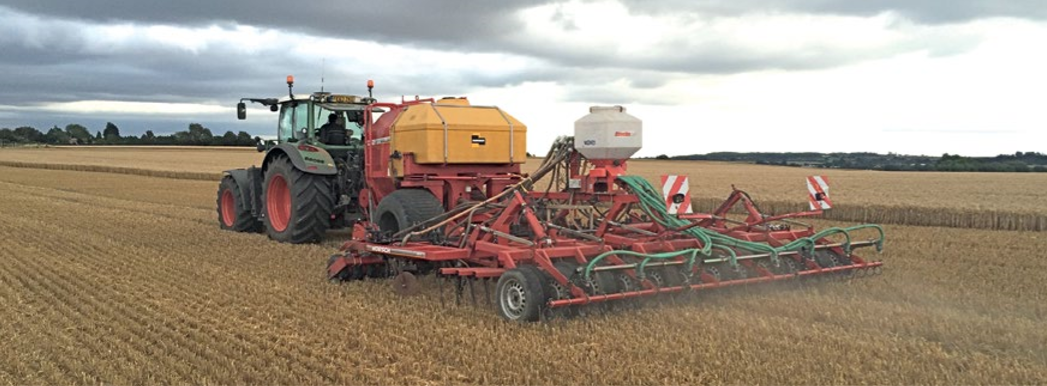
How To Start Drilling For £8K
Clive Bailye’s seed drill of choice is his 6m John Deere 750A , which has been used exclusively for 3-4 seasons. Last year, with an increased acreage, the founder and publisher of this Direct Driller magazine thought a second seed drill was necessary. Having just the one machine was a risk and in a difficult season would mean drilling was delayed. He looked around and found a good condition Horsch CO6 tine drill advertised in Germany.
Words and pictures by Mike Donovan
After delivery he rebuilt the coulters to a narrow profile so as to reduce soil disturbance. He says the tine drill is very useful driling after straw crops such as osr and also through the straw on second crop cereals.
Buying the drill from a German farmer was not particularly complicated, and provided him with a higher spec machine than Horsh sell in the UK. The seed dart tyres are much wider, and the machine is fitted with blockage monitors as well as full width front packers and also a liquid fert application system.
A sheaf of photos were taken, and Clive then asked for some of specific parts to show wear. The deal was done at under £5,000 which Clive says is the market value of these machines which are too large for small farmers to buy. Original owners like to buy new and sell when the machine is still in good condition.
Narrow tines with wear tiles
@Clive knew he wanted to make changes, substituting the Horsch tines and coulters for something far narrower, and has ended up getting his own design of tine made, which has a wear tile made from Ferobide, far harder than tungsten. The drill is on the farm primarily for osr and 2nd crop cereals drilled into chopped straw and the 25cm spacing is okay for these crops.
Comments on Clive’s on-line forum, TFF, said the drill many not be so good with beans, as the slot is a mere 12mm wide. And in barley the spacing may well be too wide as it needs to be thick. Clive points out that the seed pipe can actually be a bit wider than 12mm as it is in the shadow of the point. It would be good to have the option of using it for beans.

Above left: The cheap CO6 is being calibrated ready for its first outing

Above right: The adapted Horsch is being filled by the home built drill logistics trailer with seed and liquid starter fert.
Getting around the German instructions
The Horsch came, of course, with a control box and instructions in German. More on-line discussion revealed that English instructions were available on the Horsch website, and another explained that Horsch was sourcing some of these parts from Agton in Canada anyway. Zealman from New Zealand explained that the button marked with callipers should be held down for around 5 seconds. The menu is where you adjust the tramline sequence, valve layout and row numbers.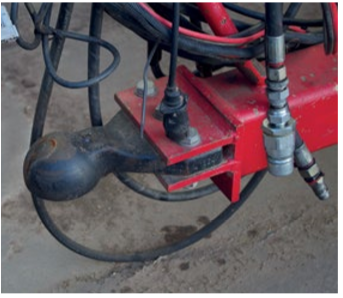
Ball hitch is a continental standard and provides a positive connection between tractor and drill

The Stocks Wizard has a rotor modified for Avadex which otherwise leaks everywhere
A Stocks Wizard is on the back of the drill and used for Avadex. Here again the knowledge of actual farmers is helpful. Alistair Nelson warned that the rotor and the surrounding shroud need to be changed, and he got good advice “from Rick at Stocks”. Clive has the same setup on the 750A and says that the Avadex leaks everywhere unless the modification is made. The drill was acquired and modified in 2016 and the results have been excellent.
The machine went through the residue without many problems and having the second drill has meant more timely planting. Clive has shown that moving into No-Till is not the expensive exercise so many farmers think it might be. The total cost, after modifications which included replacing all tines and coulters, was under £8,000.
Author Mike Donovan writes: we have featured a number of home made direct drills in @Practical Farm Ideas, and are always interested in seeing more. Please contact mike editor@farmideas.co.uk or 07778877514.
-

Artificial intelligence is speeding up the development of the next generation of Biostimulants
Written by Syngenta
- Syngenta Crop Protection and TraitSeq announce a pioneering collaboration which could help farmers transition to more sustainable practices.
Syngenta and the pioneering artificial intelligence (AI) company TraitSeq are combining forces to use the full power of AI for the development of innovative, high-performance biostimulants.
Syngenta, a world leader in developing the next generation of biologicals products for agricultural use, will use its extensive knowledge of crop biology to complement TraitSeq’s proprietary AI methods to identify highly specific indicators of a plant’s cellular state called biomarkers. When activated, these biomarkers can indicate how well a plant is responding to efforts to boost its health or to block the effects of external, abiotic stressors.
Biostimulants are products applied to plants, seeds or the root environment that enhance natural plant processes, leading to an improved nutrient use efficiency, increased tolerance to abiotic stress or better crop quality. Biostimulants are a vital and growing component of sustainable agriculture, yet their performance can vary depending on environmental factors such as temperature and local climate.
Syngenta has extensive data across different branches of science – such as genomics, proteomics, metabolomics, and phenomics. Using TraitSeq’s sophisticated proprietary platform, scientists from both teams hope to leverage AI to analyze complex biological big data, to uncover the intricate molecular interactions that impact a crop’s ability to utilize available nutrients in the soil. Once specific biomarkers can be identified, scientists hope to be able to quickly and accurately assess the efficacy of a new biostimulant in enhancing plant health.
The development of such biostimulants also fits in Syngenta’s efforts to support farmers transition to regenerative practices and its commitment to sustainability. Syngenta’s recently launched Portfolio Sustainability Framework (PSF) rates Syngenta’s products for sustainability and stakeholder alignments into 3 tiers. New products are also included with the aim to shift the portfolio towards the top tier.
Camilla Corsi, Head Crop Protection Research & Development, said: “At Syngenta, we are accelerating the pace at which we innovate, to deliver solutions farmers urgently need. Technologies such as TraitSeq’s AI-driven platform enable us to revolutionize our research, attain important data-driven insights, so that we can develop the next-generation of sustainable solutions faster – while further strengthening our pipeline of innovative agricultural technologies.”
Dr. Joshua Colmer, CEO of TraitSeq, said: “This partnership highlights how TraitSeq’s versatile platform can transform agricultural input development by uncovering predictive biomarkers that directly link molecular insights to biostimulant performance. By equipping Syngenta’s innovation pipeline with these capabilities, we aim to optimise and accelerate the development of new biological solutions, which will support farmers in adopting more sustainable agricultural practices.”
Biostimulants offer an important solution to farmers seeking to improve the sustainability of their farming operations while addressing challenges arising from an increasingly constrained toolbox of available agricultural technologies and evolving consumer demands.
About TraitSeq Ltd
TraitSeq Ltd is an agri-biotechnology company specialising in applying proprietary machine learning approaches to omics data analysis for agriculture. A spin-out from the Earlham Institute, TraitSeq’s platform combines omics data with other data types to predict complex phenotypic traits. This provides agritech companies with actionable insights to accelerate and optimise chemical and biological crop input development, plant gene editing, and complex trait development in agricultural crops and animals.
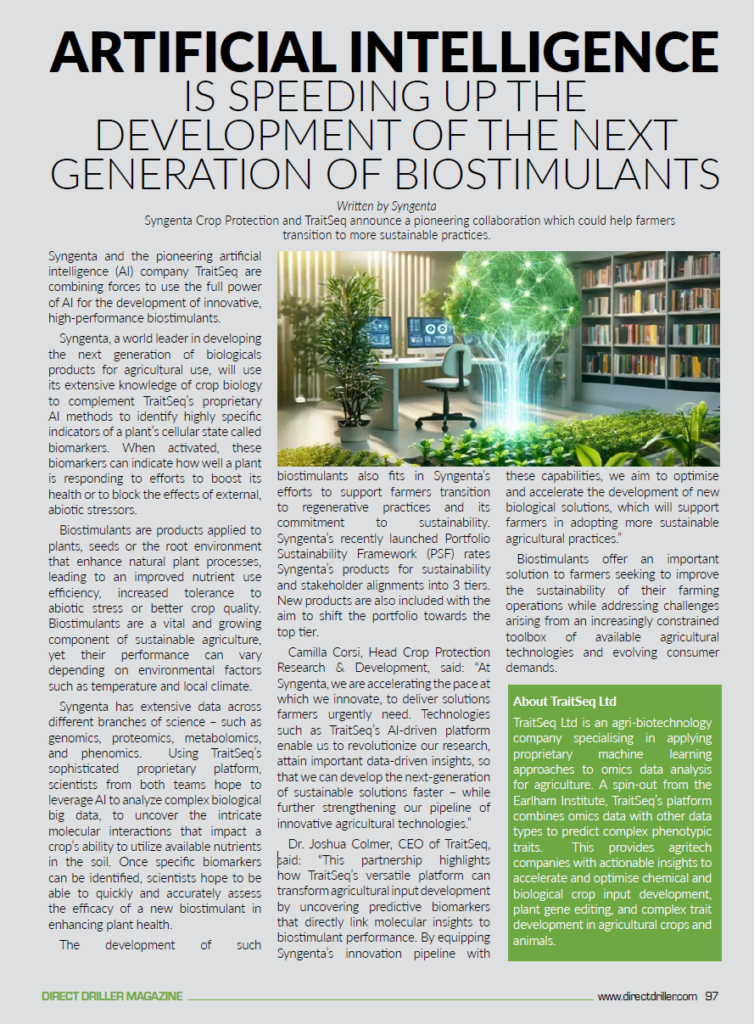
-

New sequenced genome sheds light on weed resistance
Written by the Earlham Institute
Genomic advances reveal how similar weeds can dominate wheat fields that are geographically separated by over 5,000 miles.
Two new Alopecurus genomes have been sequenced, providing important additions to the growing body of community resources for weed genomics.
Access to the genomes for blackgrass and orange foxtail, sometimes called shortawn foxtail, will help researchers address what makes these weeds such exceptional survivors in modern agricultural systems.
The sequencing of the orange foxtail genome, which was carried out at the Earlham Institute, generated 11.7 million PacBio HiFi reads – nearly 230 Gb of data – corresponding to a haploid genome coverage of 32.9x.
Both blackgrass (Alopecurus myosuroides) and orange foxtail (Alopecurus aequalis) are native to many regions across the Northern Hemisphere.
Blackgrass has become the predominant agricultural weed in Western European winter wheat and barley, whereas orange foxtail has emerged as the dominant agricultural weed for similar crops in parts of China and Japan.
Both are grass weeds that grow in grass crops. They frequently out-compete cereal crops.
Changes in cropping practices have not been effective in controlling the weeds, and both have evolved resistance to multiple herbicides.
With both weeds presenting a major threat to crop yields and food security, a better understanding of the genetic drivers of their resistances and resiliencies are essential to generate effective strategies for control. Filling this knowledge gap requires high-quality genomic resources.
In December 2023, an annotated blackgrass genome was published by Rothamsted, Clemson University, and Bayer scientists. The blackgrass seeds were from a population collected in 2017 from the Broadbalk long-term experiment that had never been treated with herbicides and so remained susceptible to chemical control.
Comparing this population with resistant populations from other UK fields enabled these researchers to identify genetic mechanisms correlated with resistance.
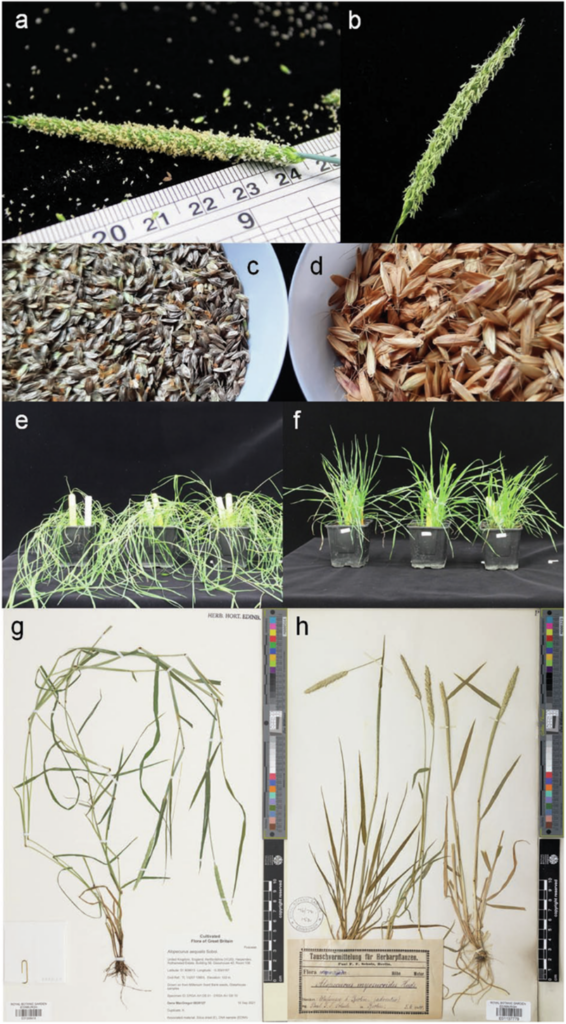
Now, one year later, an annotated orange foxtail genome has been published. For this genome, Rothamsted researchers collaborated with partners at the Earlham Institute and the European Reference Genome Atlas (ERGA) initiative, which ultimately aims to provide reference genomes for all European species.
The orange foxtail plants sequenced were from seeds held by Kew’s Millennium Seed Bank from a UK-collected population.
As orange foxtail is not present in the UK’s agroecosystem, it is unlikely they have ever been exposed to herbicides.

As with the Broadbalk seeds, this genome is an important reference as it will not have been influenced by the strong selective pressures that have shaped some weed populations.
The orange foxtail genome at 2.83 Gb is smaller than the blackgrass genome (3.572 Gb) and contained just over 33,750 protein-coding genes. The genome is assembled into a total of seven chromosome-level scaffolds, and most are complete with telomere sequences on one or both ends.
The sequencing, assembly, and analysis of the orange foxtail grass were carried out by teams in both the Earlham Institute’s Faculty and its National Bioscience Research Infrastructure in Transformative Genomics, both supported by BBSRC.
Dr Jon Wright, study author and Bioinformatician at the Earlham Institute, said: “Genomic resources are increasingly important to enable breeders and producers, who are under growing pressure to develop new and sustainable approaches to manage weeds, pests, and disease.
“To understand how these weeds compete with the plants we want to cultivate, and look inside the box of tricks they use to frustrate farmers, we absolutely need to have high-quality genomes.
“We’ve been able to start exploring the evolutionary story of these weeds, particularly their development of herbicide resistance. This could be used to develop effective herbicides or other strategies to better control these weeds.”
Dr Dana MacGregor, author and Weed Molecular Biologist at Rothamsted Research, said: “With these platinum-quality genomes in hand, we can shrink the continental-scale geographic isolation and 7.4 million years of divergence between these two species to ask whether similarities between these two species are the result of parallel evolution or have a common origin.
“When we compared the orange foxtail and blackgrass genomes with barley – a crop they grow in – we were surprised to find that the orange foxtail genome structure is more like barley than blackgrass.
“Such genomic rearrangements highlight areas of functional conservation or divergence that drive adaptations to specific environments or ecological niches.”
The genome for the orange foxtail was sequenced by the Technical Genomics group, assembled by Dr Wright, and annotated by the Core Bioinformatics group – all based at the Earlham Institute.
Naomi Irish, Senior Research Assistant in the Technical Genomics Group at the Earlham Institute, said: “The orange foxtail is quite exceptional amongst eukaryotic genome assemblies. We normally see very good assemblies with a contig N50 of between 20-30Mb. Our orange foxtail has a huge contig N50 of 374.7Mb.
“Assembling the genome – from growing the plants, doing the DNA extraction, through to sequencing and annotation – involves a lot of people and expertise. We’re uniquely set up to bring everyone and everything together for these kinds of projects to give us such great coverage.
“The read length, particularly for a plant, was particularly impressive and only made possible thanks to careful coordination and collaboration.”
ERGA contributes to the Earth BioGenome Project (EBP). This ambitious initiative aims to sequence all eukaryotic life on earth – generating reference quality genome assemblies for approximately 1.9 million described eukaryotes.
About the Earlham Institute
The Earlham Institute is a hub of life science research, training, and innovation focused on understanding the natural world through the lens of genomics.
Embracing the full breadth of life on Earth, our scientists specialise in developing and testing the latest tools and approaches needed to decode living systems and make predictions about biology.
The Earlham Institute is based within the Norwich Research Park and is one of eight institutes that receive strategic funding from BBSRC, as well as support from other research funders.
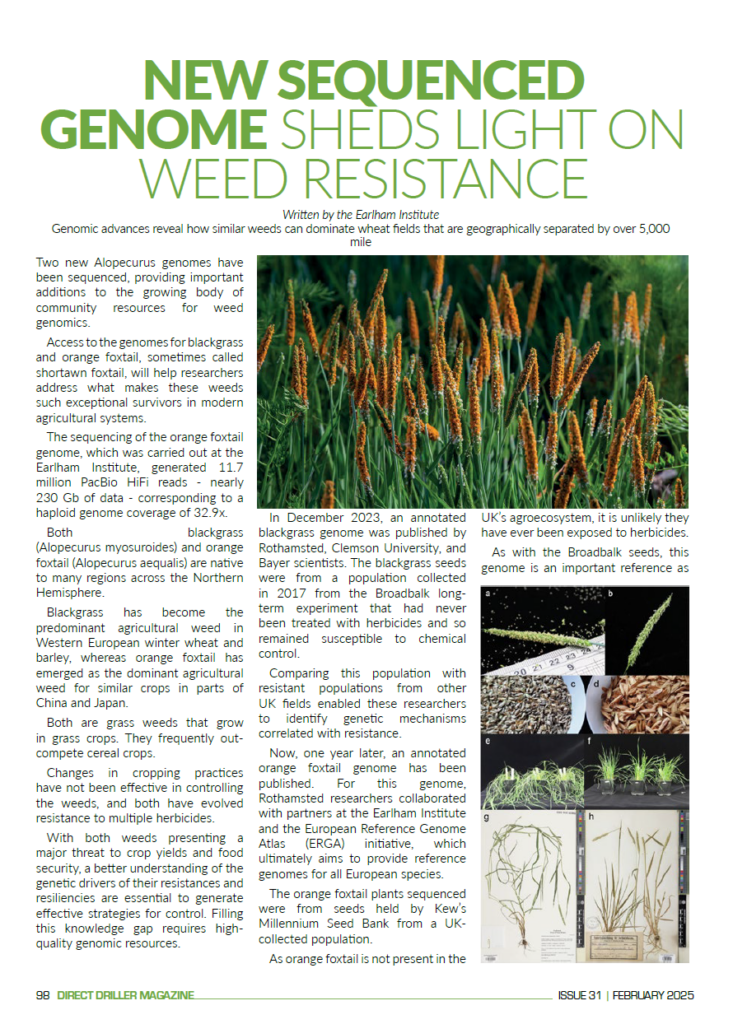
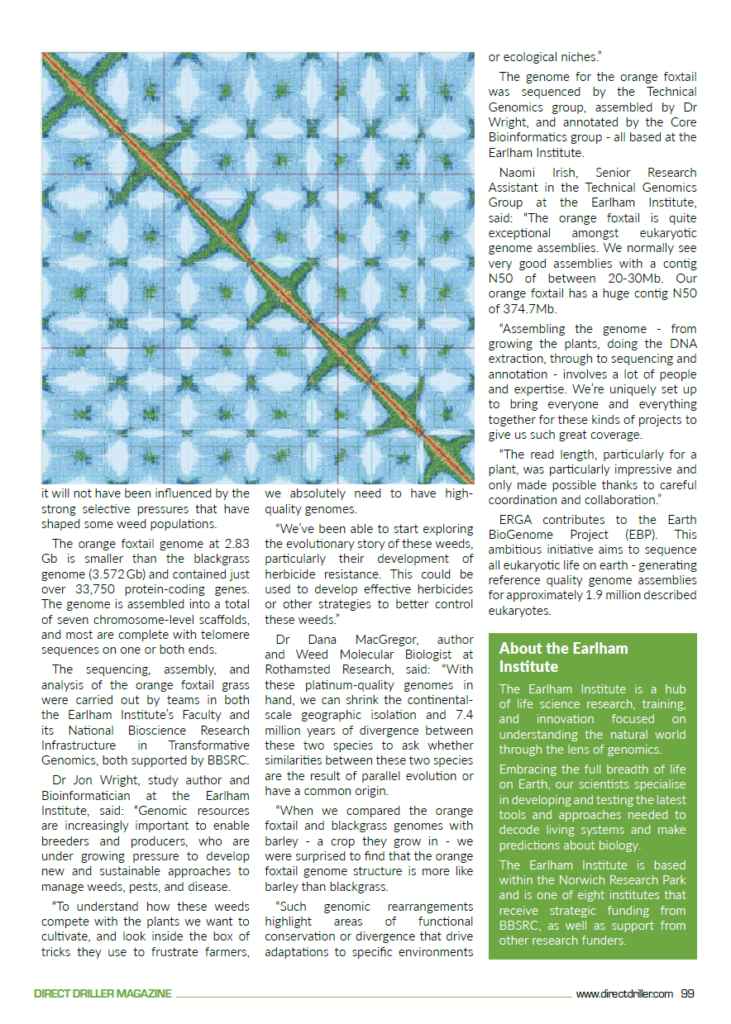
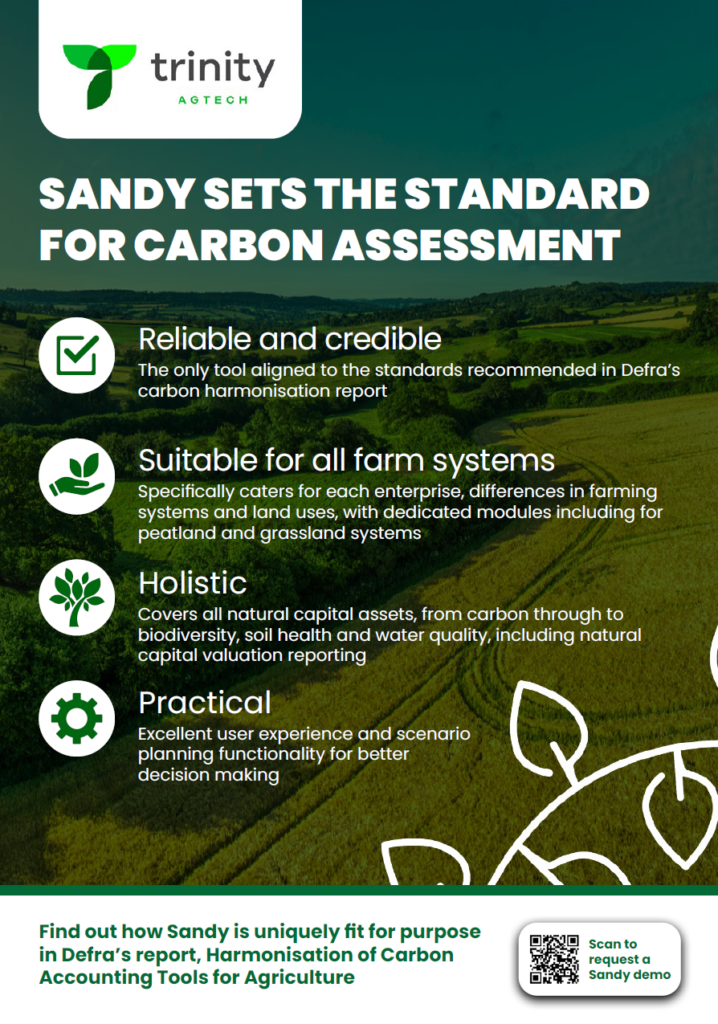
-

What the public think of farming?
I had already written this into based on the IHT announcement and the subsequent farming protests and events organised around the country. But having listened to the brilliant Tom Martin talking on stage at the BASE conference I gave it a little update – as his ideas on communication are spot on and really show us to how to connect more with consumers (our ultimate customers).
But protests don’t necessarily endear you to the public – the train drivers strikes being an example of where this damaged their public support. As an someone involved in the organisation of some of the events, you need to consider what the public think of farming overall.
Public Awareness and Support
The widespread protests have undeniably brought significant attention to the challenges faced by the farming community. Media coverage has been extensive, with major outlets highlighting the concerns and struggles of farmers (possible with the exception of the BBC where coverage has not been extensive). I think, based on looking at our socials, this heightened visibility has fostered a sense of empathy among the public, many of whom were previously unaware of the intricacies of agricultural operations and the financial burdens associated with them.
A public poll conducted shortly after the protests indicated substantial support for farmers, with a majority believing that agricultural estates should be exempt from the proposed inheritance tax changes. I think this sentiment stems from a recognition of the essential role farmers play in ensuring food security and maintaining the rural economy. The public’s growing awareness has translated into a broader appreciation for the hard work and dedication inherent in farming. But does this mean they are more likely to buy UK grown products?
Perception of the Inheritance Tax Reforms
I have yet met a farmer who thinks those buying land to avoid IHT think they should not get taxed. So the policy itself isn’t the issue. But the government’s proposal to impose a 20% inheritance tax on farms valued over £1-3 million (depending on your marital status) has been met with universal disdain. Some segments of the public view it as a necessary measure to address fiscal challenges, but a significant portion perceives it as an undue burden on family-run farms. All organisations, NFU, CLA, TFF, Reform Party, Conservative Party and farmers across the country have been vocal in its opposition, generally arguing that the these changes could impact up to 75% of commercial family farms, potentially forcing them to sell land to meet tax obligations. These are not the demographic that the government said they were targeting.
This perspective resonates with many people who value the tradition of family-owned farms and fear that such policies might lead to the corporatisation of agriculture, thereby eroding local communities and traditions. But there seems to be a big urban / rural divide. The public discourse suggests a growing concern that the reforms could inadvertently favour large agribusinesses over smaller, family-run operations.
Beyond the immediate issue of inheritance tax, the protests certainly have shed light on a range of challenges confronting the farming sector. Farmers have expressed feelings of neglect and misunderstanding by urban policymakers, citing issues such as recent weather, fluctuating market prices, and changes from BPS to SFI post-Brexit. Generally, I think these grievances have struck a chord with the public, many of whom are beginning to grasp the multifaceted pressures faced by those in agriculture. We have the likes of Clarkson’s Farm and others for highlighting these issues over the past 3 years. It’s not the first time the public are hearing this.
I do see that the narrative is shifting towards a more inclusive understanding of the agricultural sector’s pivotal role in the nation’s well-being.
The Path Forward
In this instance, the collective voice of the farming community, amplified by public support, has initiated a critical dialogue about the future of agriculture in the UK. A unified farming community has spoken and the public (and government) have heard 1000s of voices as opposed to just the few.
Tom Martin said a very similar thing on stage. If lots of us take on the responsibility to talk to the public about what we are doing, our collective voice grows and I’ve seen the impact of that over the past 3 months.
Think about who you communicate with, be it online, in parish magazines, in the pub, in local schools and do a little bit more. Because if we all do a bit more the public will know a lot more about farming.


-
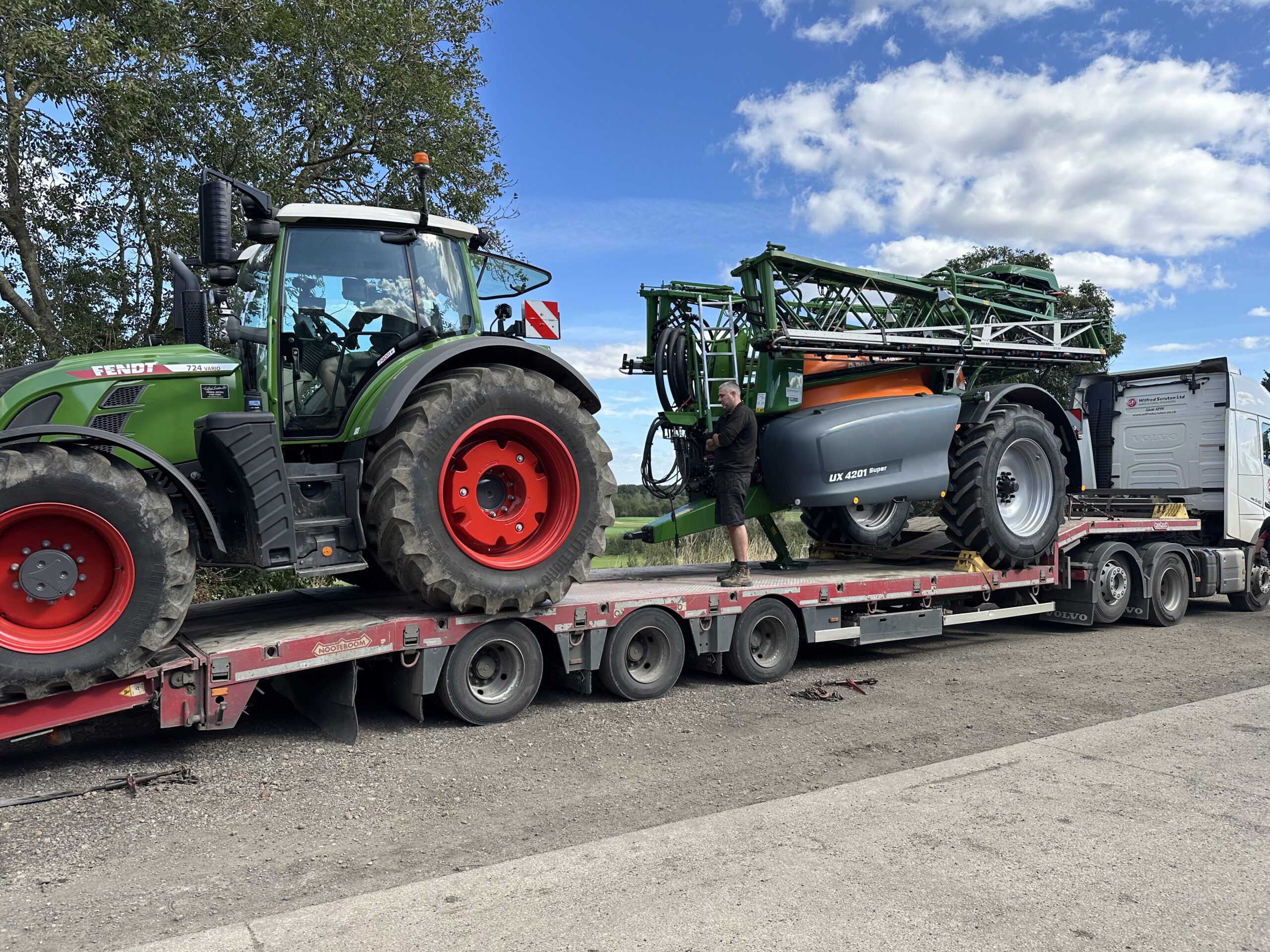
Farmer Focus – Phil Rowbottom
Jan 2025
It’s been a while since I last wrote a Farmer focus article in Direct Driller magazine.
Harvest 24’ Seems like a long time ago, yet we’re now closer to the next harvest than we were the last.
2024 On the farm was a year to forget for many reasons, even before the Autumn Budget announcement. We are now into our fourth season Direct Drilling on the farm, still adapting and continuing to learn as we go.
The biggest single change is that for the first time in 50 years, we are not growing any oil seed rape. The continued battle to establish and nurture this crop through to harvest, has made it un-viable to grow as a break crop, the risk simply does not match the reward.
More on that shortly, let’s get back to last summer for a minute, at least it was a bit warmer and less gloomy then!
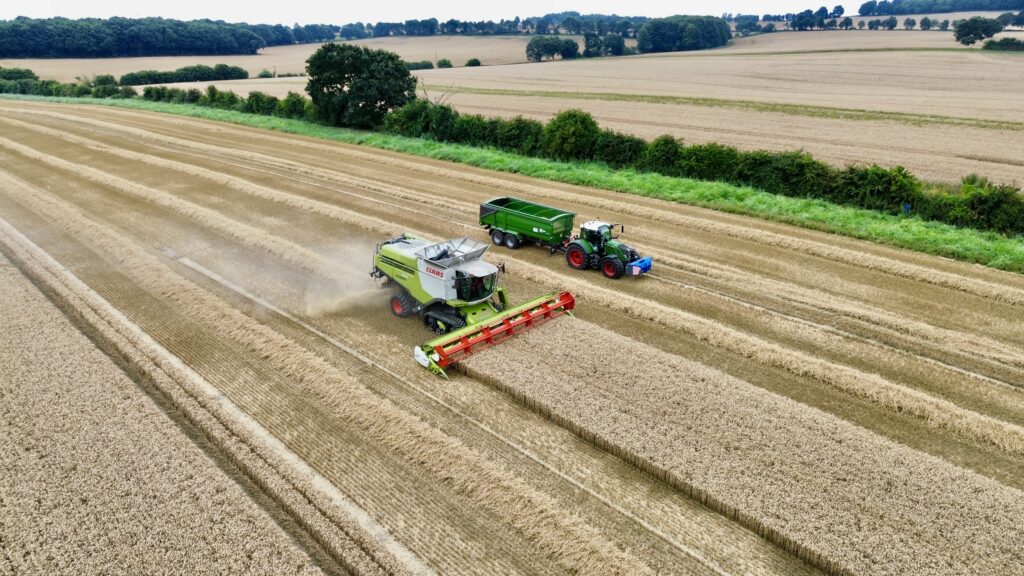
Wheat yields were far from anything to shout about following the wet winter of 2023/24.
Milling wheats were very average, between 7 and 8 tons to the Ha, with the feed wheats doing marginally better at 9 tons to the Ha.
With continued poor grain prices through 2024, much of the 2023 harvest was still in the grain store at harvest.
Autumn drilling was relatively straightforward this time compared to the year before, even though the summer cover crop between harvest and drilling did not meet expectations, it still maintained a green cover year round and will have ecological benefits to both soil health and wildlife as we’ve seen before, with Grey Partridge back on the farm in the last couple of years and owl populations seemingly increasing too.
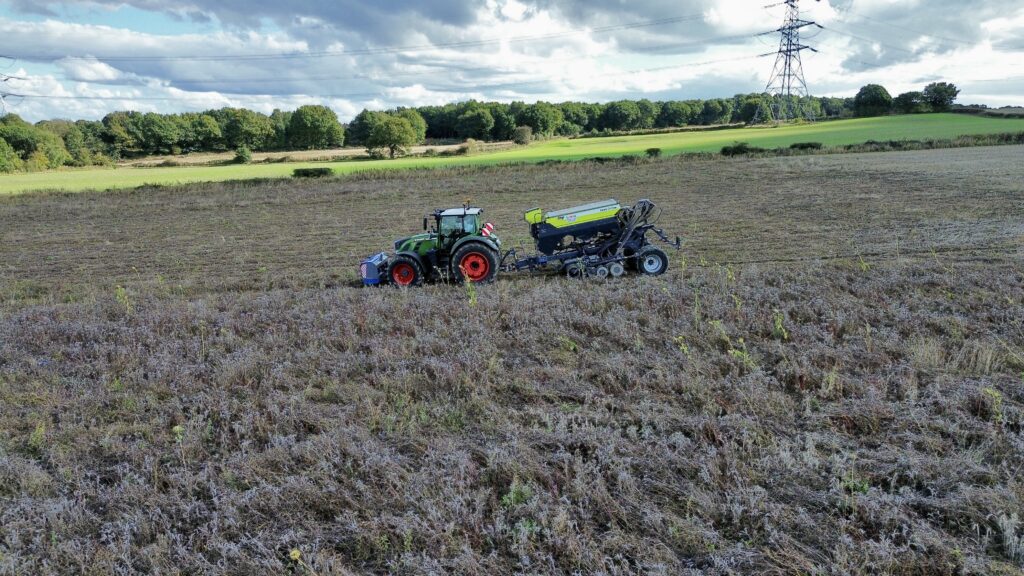
With the removal of OSR as the break crop, spring oats will follow an SFI over winter cover crop, to be followed by spring oats, the financial benefits alone from this SFI option vs OSR is frankly a no brainer commercially. It has also opened the door to an additional storage opportunity with one of our merchant clients wanting a 1000 ton of oats to be stored here, which will replace some of the lost OSR storage.
Winter wheats are all in, we’ve only had to re-drill one piece due to ryegrass, a decision that was made very quickly after emergence at the start of November.
We took a decision on wheats to go for the most vigorous varieties, irrespective of milling or feed wheat. Champion is a new variety along with Goldfinch, a milling wheat that is BYDV resistant and Dawson, an old favorite back for another year.
Having walked the farm over the last day or two, it looks in rude health compared to this time last year, with significantly less water damage than last winter, the later sown wheat in November actually looks the best of all.
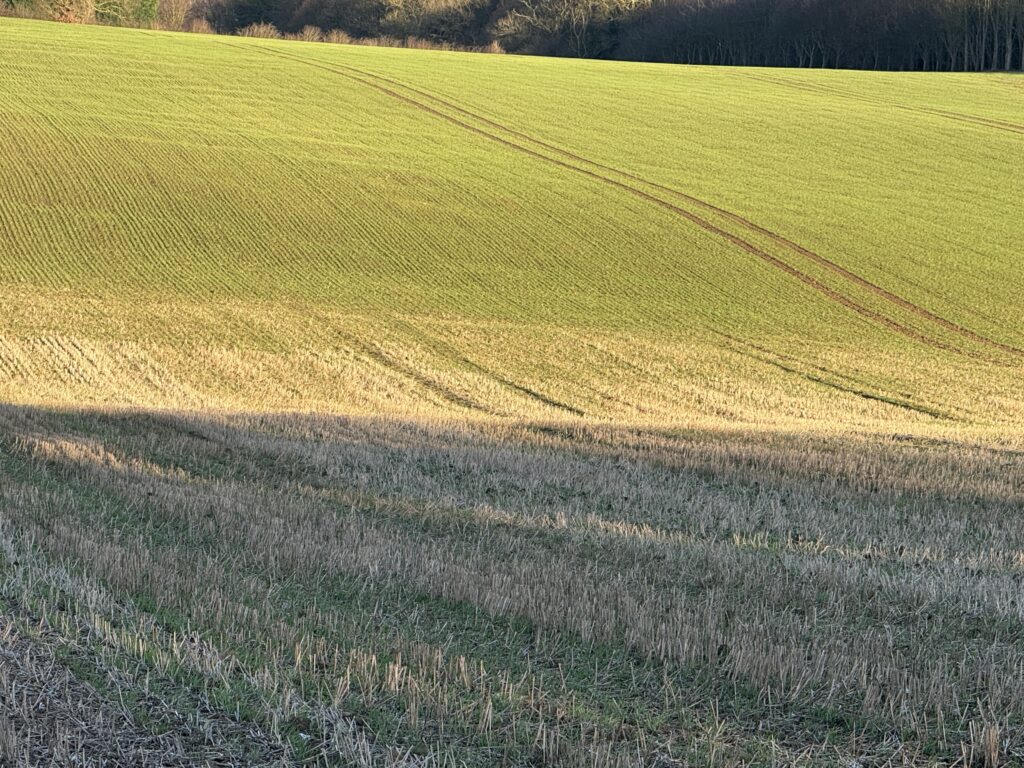
We trialled leaving stubbles taller this year to reduce the matting effect of chopped straw, which seems to have worked this time at least.
Providing we don’t have too much more rain and the temperatures climb as forecast, I expect to be spraying off cover crops by the first week in March with a view to be drilling oats very soon after.
We continue to test soil health annually, this time with SOYL, every HA sampled to allow a more accurate account of soil mapping to enable us to utilise variable rate application, from drilling, chemical and fertiliser application, the purchase of a new Amazone Sprayer, with individual nozzle control has made this even more critical to not only input cost reduction, but to enable better environmental outcomes.
The Sky Drill still proves to be very successful, Sky UK visiting the farm with other farmers lead us to hosting Fredric Tomas and a number of other farmers at the end of last year.
It’s difficult to write this without touching on the IHT changes announced last Budget.
As a farmer and business owner, who diversified nearly 30 years ago, with family working within that business, it’s very difficult to see a positive outcome for any of it presently. We’ll keep fighting on until the government listens and hopefully sees some sense in altering the proposed policy, until then we’ll just keep on going as we always do.
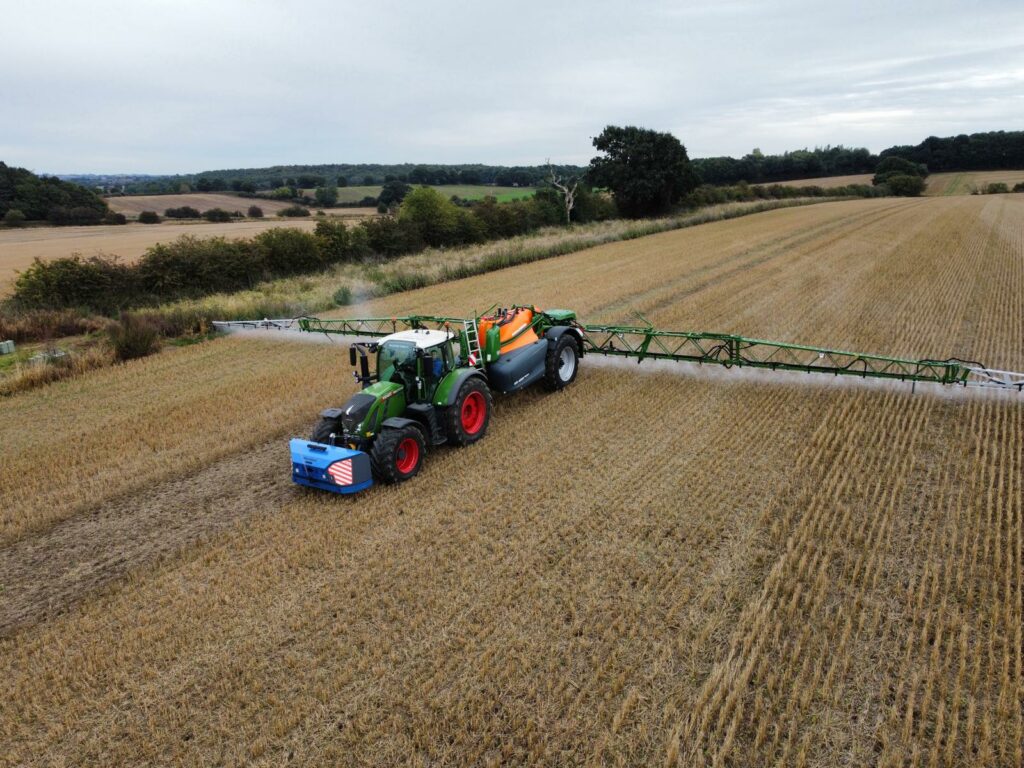
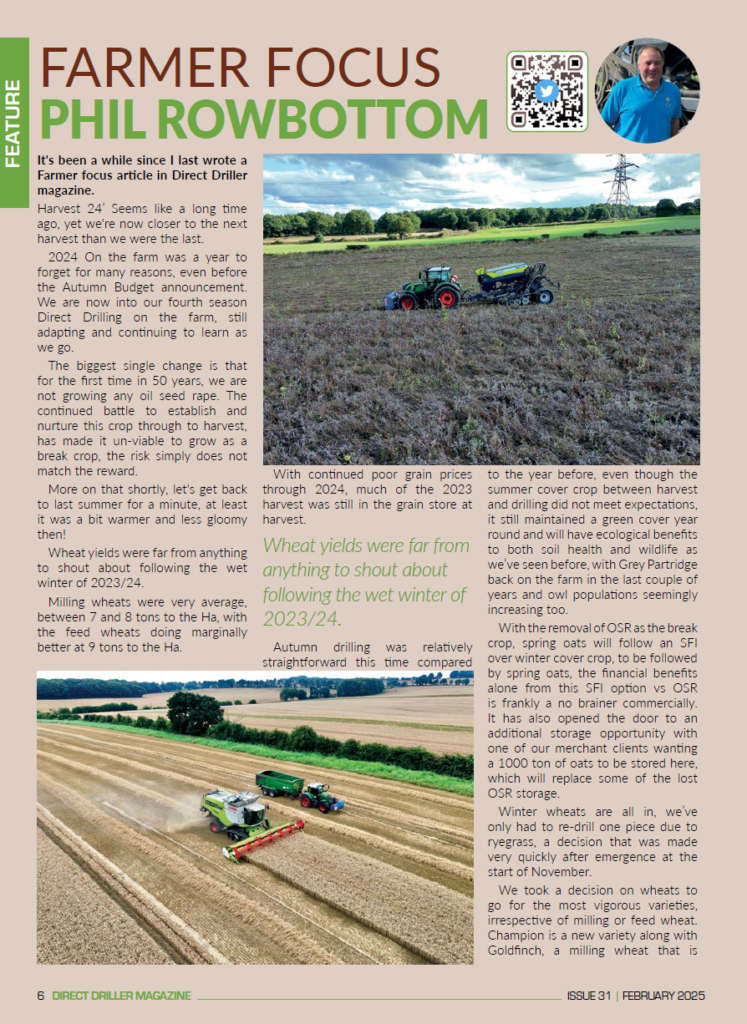
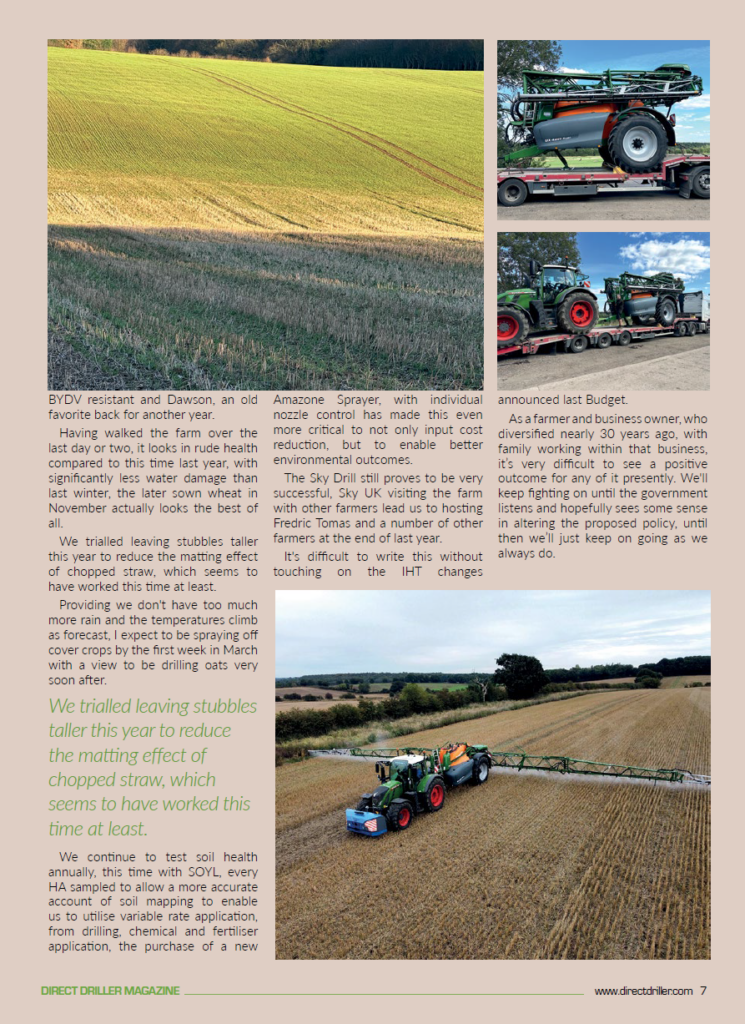
-
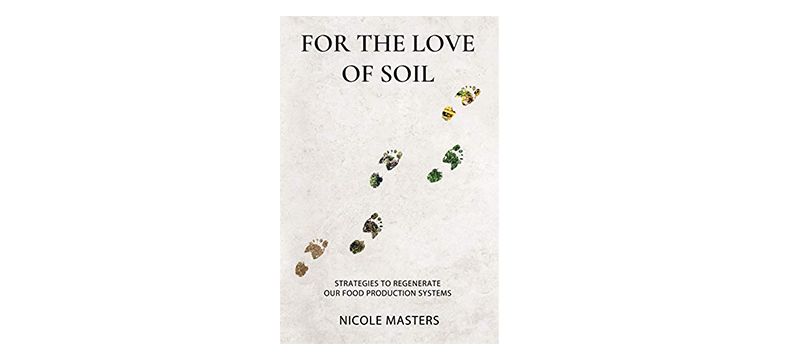
For The Love of Soil…
For a generation, farmers have taken for granted their most valuable resource, often considering it to be simply ‘dirt’. The focus has been on force-feeding the crop and beating the soil into submission, driven by an ethos of yield over profit, with little respect for the aftermath. Inputs for many have typically increased since the 1940’s, as at that time, fertiliser was seen to be the easy solution to maximise crop returns; consequently, the supply and demand situation was then able to keep pace and crop rotations became shorter to satisfy the ever-increasing markets. However, all the while soil was still treated as an abused medium and consequently, this once robust and resilient resource has suffered – until now.
The farming solution has been to counteract this shortfall with greater chemical inputs. This counter-intuitive response has led to increased disease pressure, forcing perpetual reliance on agronomy to maintain healthy plants. STOP!
Back up and look at what’s happening; this is not a sustainable system and it will ultimately lead us down a path that we cannot come back from. You only need to look outside at the hedges and verges for inspiration. Their eco-systems are self-sustaining, resilient and productive; despite a lack of farm inputs – they have predominantly been left unassisted, and now have a naturally evolved durability.
A simple experiment you could try for yourself is to take a spade out to the centre of your field and compare the soil to what’s in your hedgerows. I guarantee the colour will be different, as will the smell. When you look at the soil texture, the hedgerow will be superior; you may also notice that there is a lot more life living in the more natural sample. This should tell you that things can and should be done, in a better, more sustainable way.
A productive soil will naturally cycle nutrients, water and air whilst supporting both biological and crop life optimally; unfortunately, excessive inputs and soil disturbances tend to upset this already finely-tuned environment – who are we to think that we know better?
There’s already a legitimate way that soils provide nutrition to their inhabitants, via biological exchange – subject to demand and conditions and complex reactions that both lock up and release elements within the soil’s profile. This trading of resources is often instigated by living organisms and is dependent on having healthy soil. When soil is degraded, natural resources are scarcer, leading to diminished Bio’ activity and, following this, less active soil will frequently require artificial intervention which in turn will throttle natural demand, thus perpetuating a more self-destructive cycle.
For example, since its conception, the Nutrient Management Guide (RB209), has advocated that farmers apply Potassium, subject to the estimated offtake of a crop and the results given by a standard soil analysis. However, I would suggest that these guidance tables should also be considering the Total K assets that the soil has to offer and not just those measured by standard lab extraction, using a chemical solution. The Total K that is held onto by the soil, will be way above what’s measured conventionally.
I’m not suggesting that Potash is bad for the soil, simply that things need to be more in balance, for the system to work effectively. Wouldn’t it be great to spend less on fertiliser and work with the soil, as opposed to against it? After all, too much of anything can still be a bad thing. One solution would be, to utilise the soil’s capacity to cycle nutrients; or by supposedly satisfying a deficiency via chemical inputs, the natural ability of soil can be made redundant by switching off this valuable support mechanism.
Since time began, KSM (Potassium solubilising microbes), have been a part of the earth’s ecology. These microbial miners can break the connection that bonds Potassium to other elements in the soil, thus making it more ‘available’ to a crop. Locked-up nutrition is so for a reason; once again too much of anything can be a bad thing, so communication is key between plant and microbe; that will instigate the necessary reciprocal exchange of elements beneficial to both parties. A generation of excess has created a deficiency of these bacterial benefactors; as a farmer – a conscientious farmer, the responsibility is yours to rectify this to benefit the grower, the soil and the crop.
It is possible with plant analysis to identify excesses and deficiencies, thus providing a valuable planning tool. There are multiple benefits to Potassium that include turgidity, health, quality and many others. Some are major, others minor, but frequently of equal importance. These KSM can be applied by a sprayer during the growing season, directly to the crop and soil, whereby they set about the task of freeing Potash for the crop to use. Another added bonus is that, with the increased microbial activity, comes a more vibrant rhizosphere, which encourages better soil conditions and structure, leading to better quality air-water efficiency, soil resilience, along with improved plant rooting.
Research has shown that KSM will actively support a crop’s demand for Potash. They produce organic acids and enzymes that help solubilise the fixed potassium into exchangeable form and make it assimilable by plants. They are activated on application and multiply by utilising the food source and or the exudates of the roots.
For the love of soil, please look back at what’s been done and learn from the lessons of the past, to build a better future.
For more information contact info@soilfertilityservices.co.uk
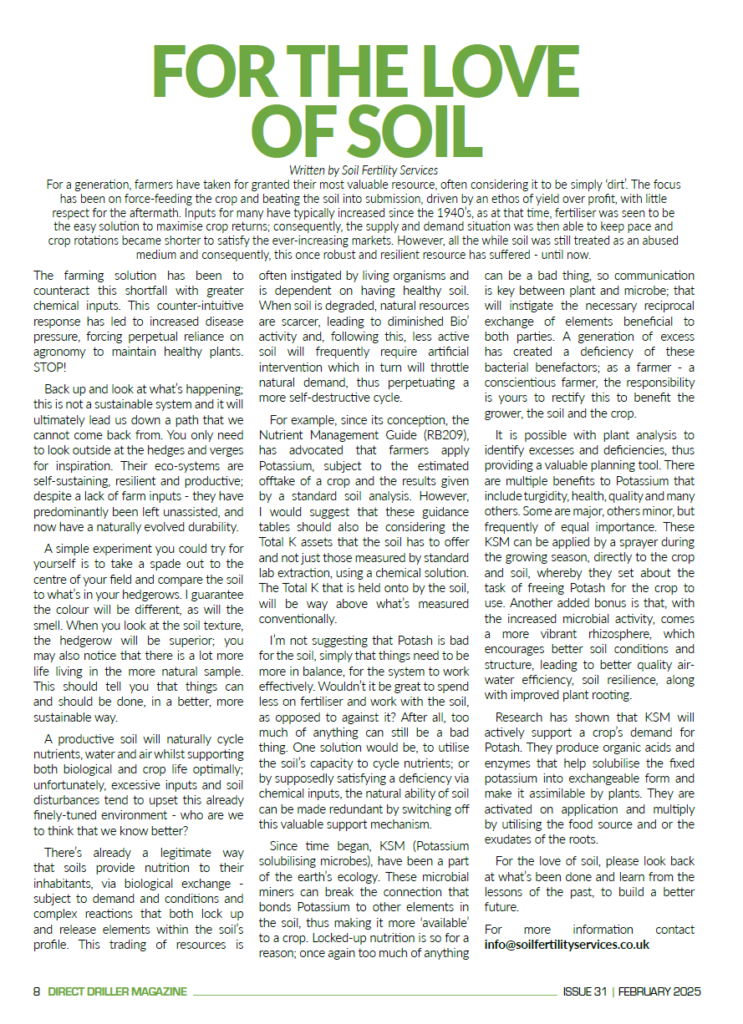
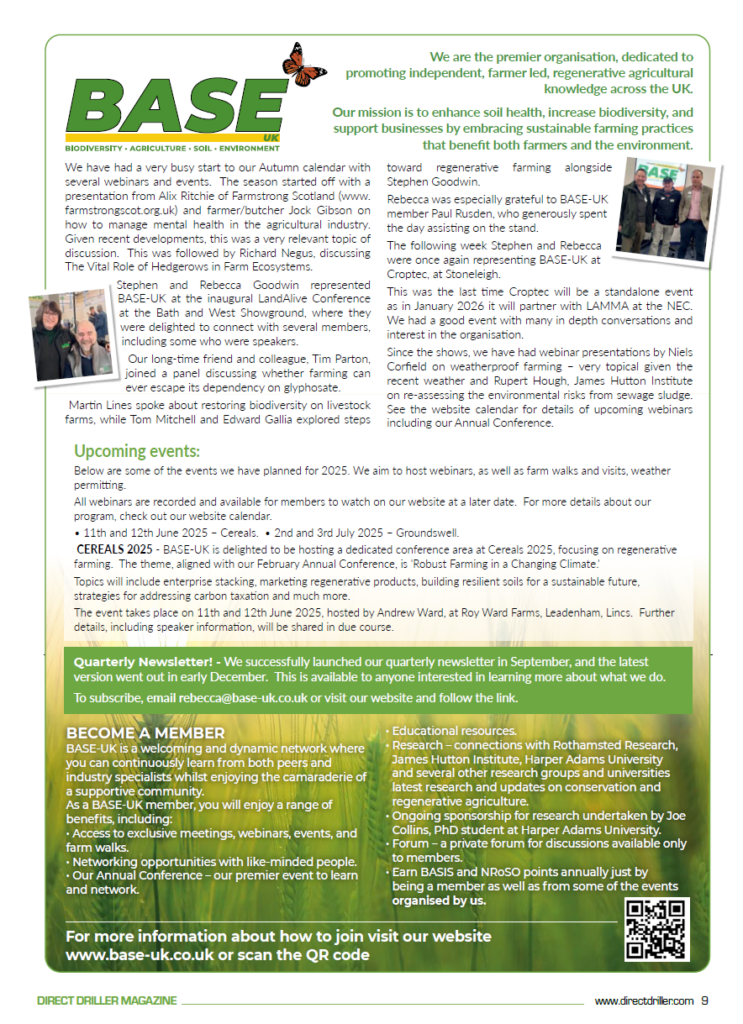
-
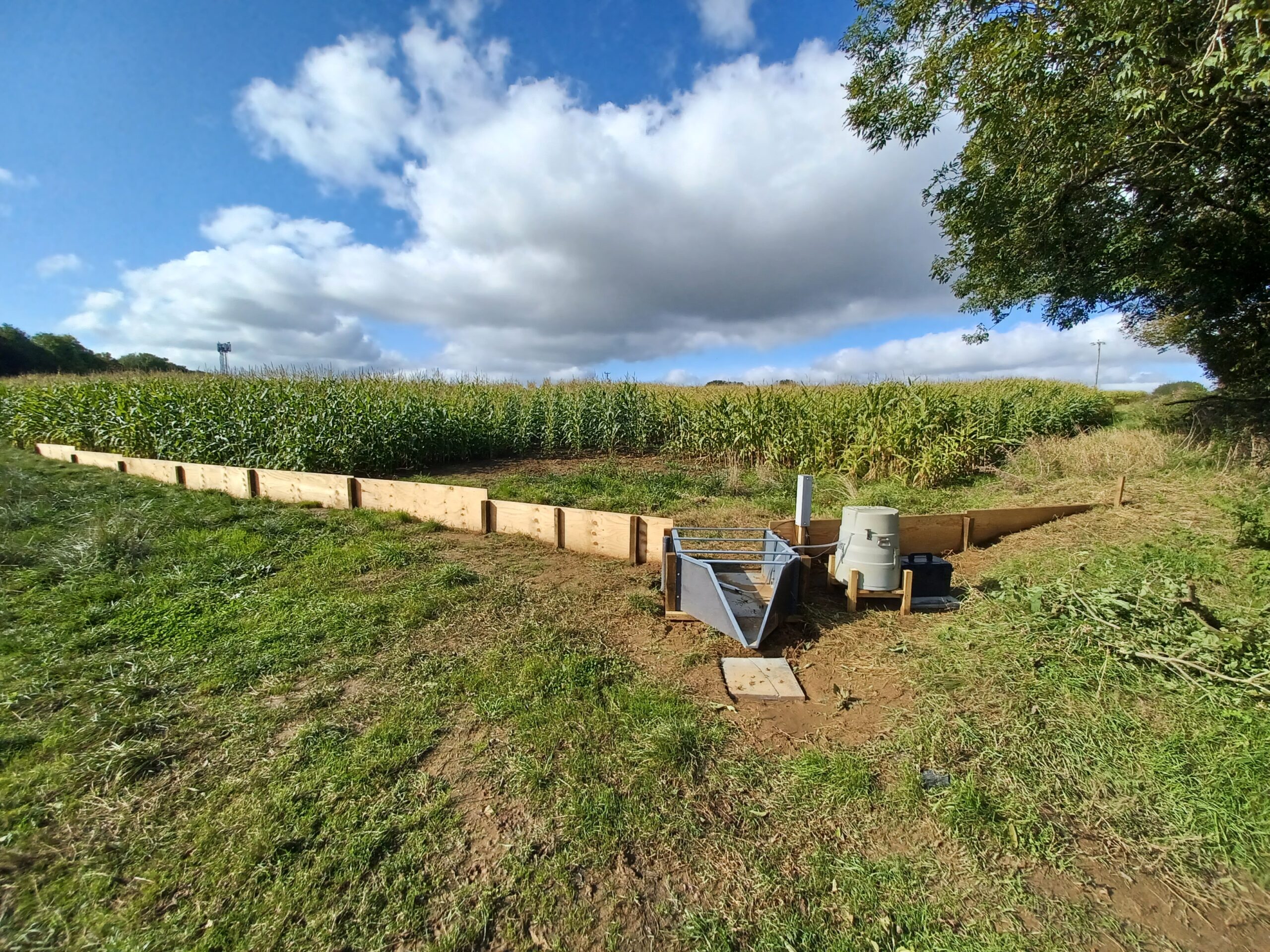
Getting a grip on phosphorus
Written by Tim Stephens NSch, Catchment Management Specialist, Wessex Water
A vital element
Phosphorus (P) is essential for life in all its forms, but many UK rivers, lakes and wetlands suffer from an excess of this critical element. Too much P causes growth of algae and duckweed, which smothers aquatic life and starves the water of oxygen. Very little P is needed to turn water green; it is said that just one kilo of P is sufficient to grow 500 kg of algae!
The two main sources of excess P are treated wastewater (i.e. sewage) and agriculture, although road runoff and septic tanks can also make significant contributions to the problem. Levels of P in many rivers have fallen over the past two decades; mainly due to major investment in wastewater treatment processes. As water companies in nutrient sensitive areas install P stripping equipment at their wastewater treatment works, regulatory and public attention is increasingly turning to reducing agricultural P loading to watercourses. Repeated algal blooms in the River Wye and Lough Neagh have led to widespread criticism of intensive livestock farming for overapplication of manure and of arable farms for excessive soil erosion.
How much P is lost from farmland? Farm P losses vary according to rainfall, soil type, soil drainage properties and farm type; ranging from under 0.25 kgP/ha on low input pasture based systems on free draining soils in low rainfall areas, right up to 2 kgP/ha on intensive livestock or arable farms on heavy soils with high rainfall. Nationally, legally binding targets set in the 2021 Environment Act require at least a 40% reduction in nitrogen, P and sediment pollution from agriculture into the water environment by 2038. Early indications are that any future targets which may be set by the Environment Agency in England could require more intensive systems in the most sensitive catchments to more than halve their current P losses. An unbalanced system
Determining the level of P losses by field and farm relies on nutrient loss calculators as measuring actual losses in runoff and drain flow requires costly edge-of-field monitoring installations. Calculating a farm P balance is usually more straightforward for farmers and advisors than estimating field P losses as it uses readily available farm data on P inputs (usually the amount of feed, fertiliser and livestock brought onto the farm in a year) and P outputs (e.g. how much meat, milk and grain were sold off the farm). Farm P balance is the difference between these inputs and outputs and a recent survey of Wessex farms showed a range of values from a -20 kgP/ha deficit on an arable farm with high P indices taking a P ‘holiday’, -2 kgP/ha on an organic beef and arable farm, through to more than 20 kgP/ha surplus for higher stocking rate dairy farms importing a lot of feed. An arable farm selling only grain and importing only enough P fertiliser to replace P exports in that grain had a surplus of zero, or in other words was ‘balanced’.
Did you know? The pattern of agricultural P loss is often likened to a ‘jerky conveyor belt’ because of the way that each episode of heavy rainfall mobilises P held in soils by washing it downhill in soil erosion, as well as stirring up P held in watercourse sediments, washing it a bit further downstream each time. In higher P index soils, heavy rain also washes out P in dissolved form through field drains. In livestock-dense catchments, which cover most of the western half of the British Isles, many decades of annual P surplus has led to the accumulation of significant quantities of P in our soils. Although the majority of this P is unavailable for plant uptake, all of it has the potential for ecological harm if it is washed into water. For example, a southwest England dairy farm recently surveyed had soil total P stocks to 15 cm depth of nearly 2,000 kgP/ha, whilst the amount of potentially available P (Olsen-P) to the same depth was less than 1.5% of the total at <30 kgP/ha. This situation is common but might be alleviated by liming low pH soils, application of gypsum to heavier and high magnesium soils or use of compaction-busting machinery or plant roots. The potential for using soil biology to access unavailable P is gaining more attention, for example by harnessing the ability of mycorrhizal fungi to supply plant roots with P. Soil-applied P activators may also have a role in increasing P availability in soils.
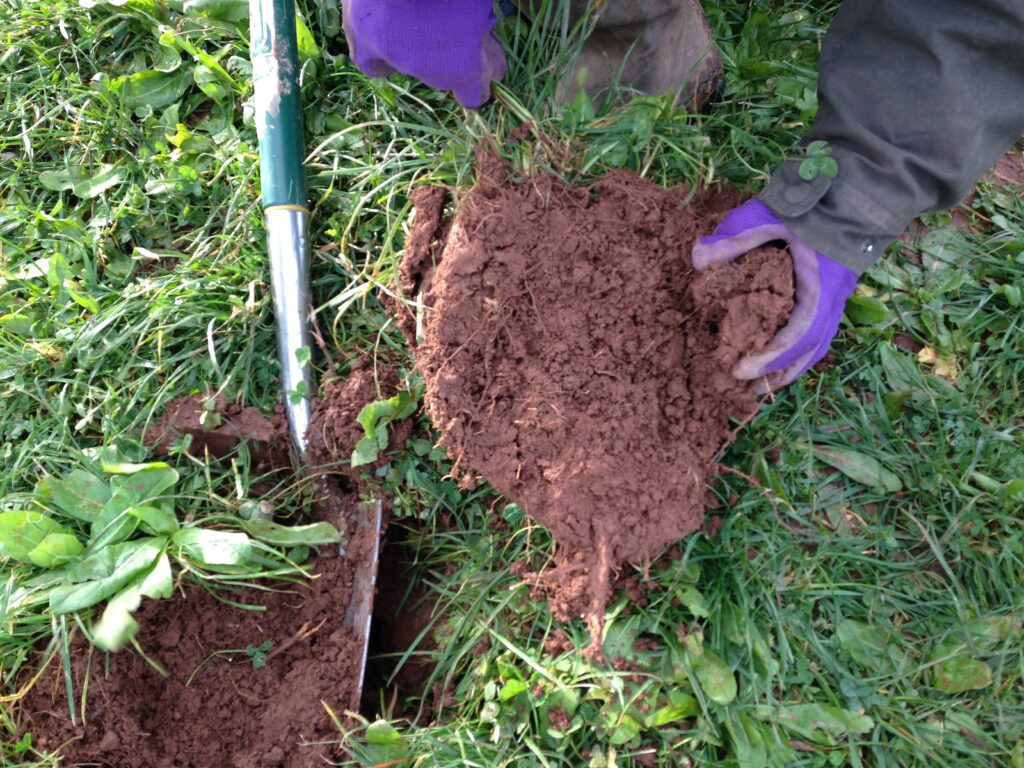
Photo credit: Wessex Water – A multi-species ley grown to lengthen the rotation and build organic matter on a Somerset arable farm – also reducing whole-farm total P losses. How much to apply?
According to the 2023-24 NRM Annual Soil Summary, out of 25,000 soil samples analysed, about a third of those soils were at the target P index of 2, whilst more than a third exceeded target. As awareness grows of the ecological risk posed by soils saturated with P, prominent agricultural scientists have suggested that arable farms need a different approach to P fertilisation strategy to the current RB209 method. Even where soil P tests show that P shouldn’t be a growth limiting factor, widespread P deficiencies shown by plant tissue testing and frequently poor uptake by crops of the P applied in fertiliser led a 2019 AHDB report* to recommend that crop nutrition strategies should be “focussed much more firmly on ensuring crop P sufficiency, rather than on soil P fertility, with crop P status being assessed routinely, especially if circumstances indicate P deficiencies to be possible”. In practical terms, this approach would involve a shift towards little-and-often P applications through the growing season, potentially made possible through greater use of foliar P products and in-crop manure application machinery.
In higher fertility soils with elevated P indices (i.e. 3 or above), future water quality rules could mean that no further P can be applied in manure or fertiliser form until P indices have been drawn down sufficiently. For farmers in this situation to avoid crop P deficiency, especially during the crop establishment phase when P deficiency can be most obvious, much greater reliance on soil health will be needed to help plants access as much existing soil P as possible. If nothing else, regular soil testing for P, K, Mg and pH is essential for identifying the high P index fields which need careful manure management and runoff risk action.
The leaky phosphorus bucket
In certain catchments, like that of the River Wye, a tipping point has been reached where some soils have become saturated with P and readily leak the excess. In other catchments where the soils are heavier and more P retentive, the main form of P loss is when it is attached to any soil particles which are washed off the surface of fields. Increasingly intense rainfall makes it even more important that action is taken to keep soil in the field and away from roads and rivers. Addressing soil compaction and keeping soils covered year round are crucial, especially where maize, root crops and winter cereals are grown, or cattle outwintered. Research** indicates that climate change driven deluges will cause agricultural winter P losses to increase by 30% by the 2050s if no preventative measures are taken.
Manure: a dirty word or brown gold?
Dairy, pig and poultry farms often run a high annual farm P surplus and have above target P index soils, meaning that manure export is likely to be a consideration in their future plans. When this manure is in the form of slurry however, its bulky and dilute nature make it costly to transport, store and apply on the arable farms which could best use it. Investment in slurry separators by dairy farms allows them to concentrate some of the manure P into a form which is easier to send off farm. There will still be some P in dissolved form in the remaining liquid, so more advanced manure processing technologies will be needed to extract this into a form which can be used as fertiliser. Although some nutrient stripping processes have been trialled on dairy farms at Harper Adams University and Coleg Gelli Aur, and plants are starting to appear at AD sites and livestock farms, particularly in Northern Ireland, much more research is needed into these technologies if they are to become affordable enough to become widespread. The variability in dry matter content of dairy slurry, and use of sand for bedding, present a particular challenge for ultrafiltration and coagulation processes. Upfront capital costs, high energy and chemical consumption and the labour requirement for operating and maintaining the equipment will present a barrier to uptake for most farms unless public or private sector financial support is made available. There could be opportunities to combine nutrient stripping with small-scale anaerobic digestion as the technology for both evolves.
As restrictions on manure use become more onerous, especially in the autumn period, manure brokerage is likely develop as a service, presenting commercial opportunities for those who can connect suppliers and users of manures and manure-derived fertilisers. Key to this will be processing of manure into a concentrated, storable, spreadable, weed-free, disease-free, low-odour product.
The more concentrated the nutrients in manure are, the easier it will be to transport them from livestock farms to either nearby arable farms or further east, where they can replace the inorganic P fertilisers used on many crops. Inorganic P usually comes from mined sources, with Russia, Morocco and China all major exporters of phosphate rock.
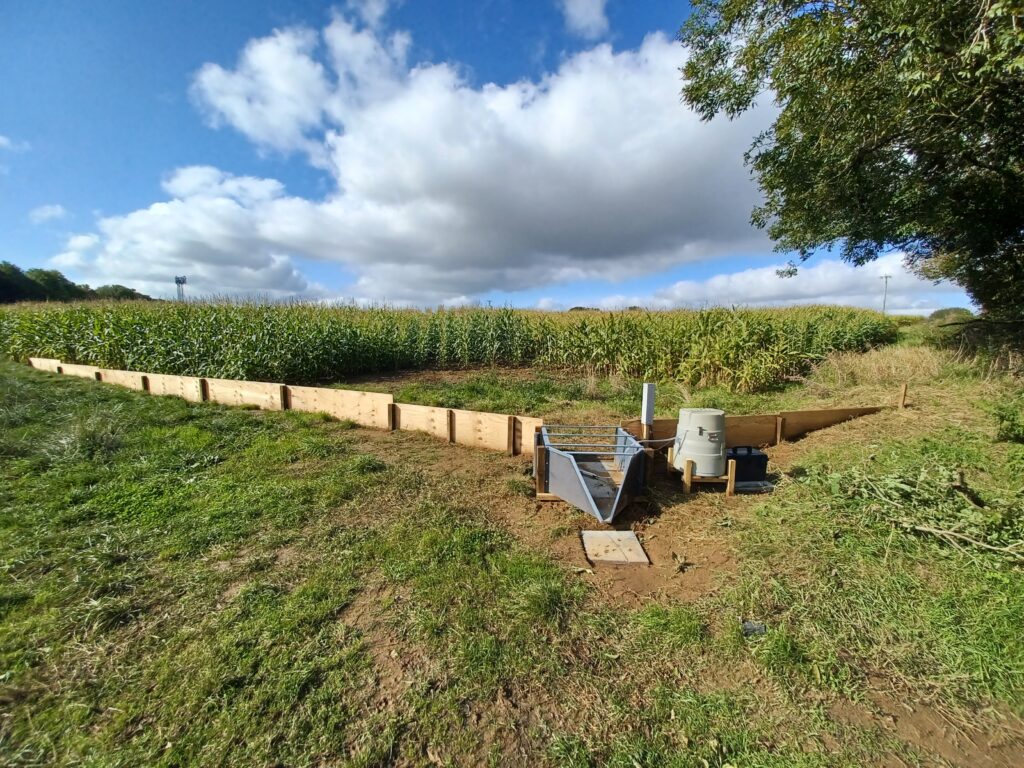
Photo credit: Wessex Water One of Wessex Water’s edge-of-field runoff monitoring stations which continuously measures how much water flows off an arable field, and what the concentration of P in that runoff is. This data is used to ‘sense-check’ what levels of P loss to water a nutrient-loss calculator had predicted for that field and crop type. This type of monitoring supports a Wessex Water grant scheme which offers farmers in parts of Somerset and Dorset funding to reduce P losses to water, for instance by growing overwinter cover crops or establishing watercourse buffer strips. 21st century mixed farming
Although the simple answer to the P issue would be a return to mixed farming, in reality the trend towards specialisation is unlikely to be reversed in the majority of lowland Britain. Collaboration between arable and livestock farms offers many of the advantages of the traditional mixed farm however, whether that be arable farms growing grass and herbal leys for grazing or entering into ‘muck-for-straw’ deals. ‘Muck-for-feed’ deals are especially advantageous to both parties as they ensure the flow of nutrients is two-way, rather than the more common one-way traffic of nutrients in feed grown in the UK or abroad never leaving the receiving livestock farm until these nutrients eventually get washed out of soils into nearby rivers. Studies have shown that dairy farms feeding higher proportions of homegrown feed have lower farm P surplus, with 65%+ homegrown feed having been proposed as a target for Dutch dairy farms. It seems reasonable to suggest that animal feed grown on a neighbouring arable farm with which there is a muck-for-feed arrangement could still be considered ‘home-grown’.
Conclusion
Clearly, there are no simple answers to the challenge which P accumulation in soils presents, not least because weather plays a major role, and climate trends are for UK winter rainfall to increase in volume and intensity. Despite this, there are three steps within farmers’ control which can be taken to get a better grip on their valuable and finite P reserves:
- Turn back the tap: Stop adding P to P saturated soils and better use what is already there by targeting sufficient levels of crop P rather than soil P. Realise the potential of soil biology to feed the plant when it is unconstrained by compaction and low organic matter. Drawdown high soil P indices by exporting manure to replace use of P fertiliser on arable farms.
- Plug the leaks: Hold soil in the field by keeping soil covered and improving water and root infiltration.
- Collaborate: For financially and environmentally sustainable businesses arable farmers need livestock farmers to sell them manure and buy their forage crops, which helps to justify longer rotations. Livestock farmers need arable farmers for feed, grazing, bedding and a home for their excess manure.
2025 Nuffield Farming Scholarship applications open the evening of 29 January 2025. All interested are invited to join in our Zoom Open Night to learn about the applications process, ask questions, and hear from 2023 Scholar Roisin Taylor – contact charlotte@nuffieldscholar.org to register.
References:
*AHDB Final Project Report: Cost-effective Phosphorus Management on UK Arable Farms by Sylvester-Bradley et al., March 2019.
**Nature Communications article: Major agricultural changes required to mitigate phosphorus losses under climate change by Ockenden et al., 2017.
About the author:
Tim manages the Wessex Water catchment management team which works with farmers in nutrient and pesticide sensitive catchments across Dorset, Wilshire and Somerset. He comes from a practical farming background and studied Agriculture at University of Edinburgh before working in the fresh produce and agricultural education sectors. Tim completed a Nuffield Scholarship in 2019 with the title ‘How can farmers keep nutrients out of water?’ and has recently achieved an MSc in Sustainable Agriculture from Aberystwyth University.
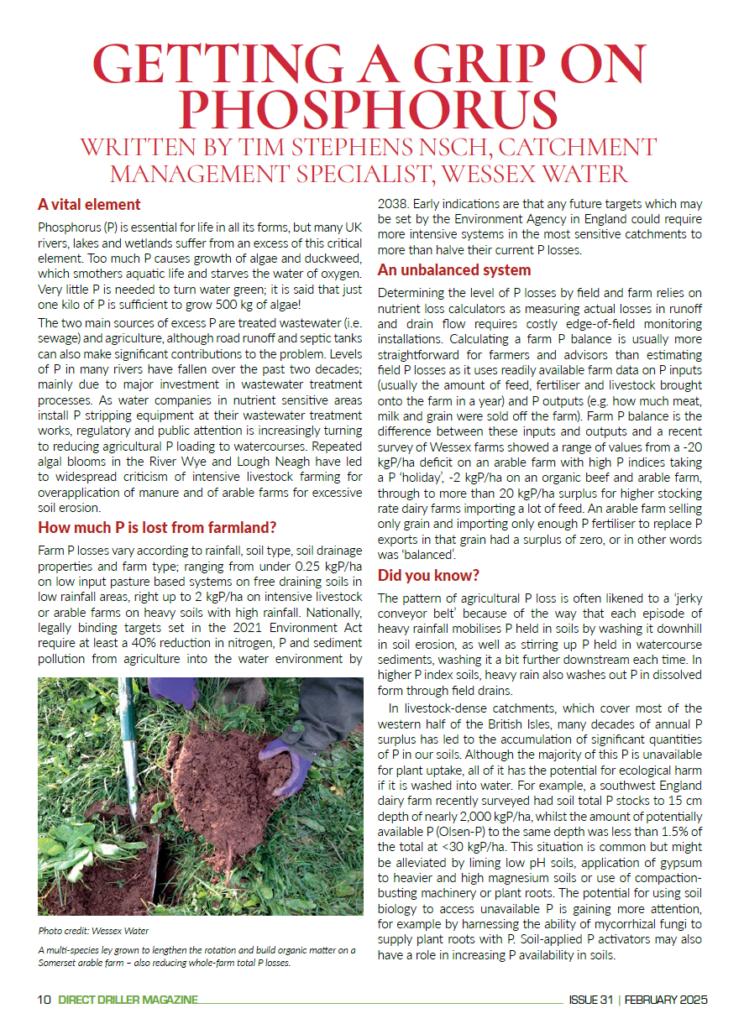

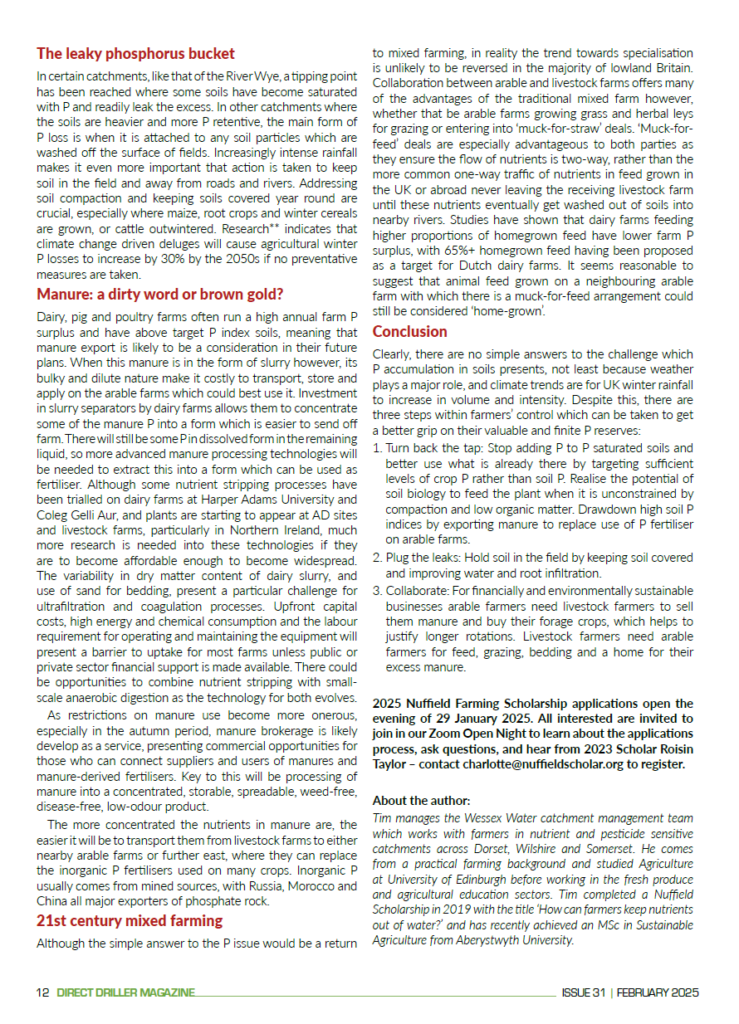

-

Soil Winter Blues
Unmoved stubbles can often be the driest land on the farm after heavy rainfall. Yet we are told that cultivation helps to dry land out. What are the factors that allow stubbles to move water downwards faster than cultivated ground? It’s now apparent that many cultivated soils are not draining recent deluges fast enough. Crops are rotting due to waterlogged anaerobic conditions. Many put this down to underlying compaction, which is mostly nonsense, in my experience. The soil isn’t compacted (at least not in the traditional trafficked sense), it’s only just been cultivated! The reality is poor natural drainage caused by compounding a multitude of problems.
Struggling to believe that something man has been doing for 10,000 years could actually be working against us? All that time and money spent moving soil to release compaction, aerate the soil, and bury the trash could be for nothing. Mike Abrams excellent article ‘Glyphosate or Tillage’ in the last edition of Direct Driller reveals how quickly the natural soil structure and soil porosity collapses once the soil is disturbed. This is the major contributing factor to perched water, or soils that appear not to drain.
Clearly there are aspects of this knowledge we can use to our benefit. Getting winter crops established in good conditions is becoming very challenging. Having had four wet autumns in five years perhaps we need to rethink our drilling strategies. Therefore, understanding how we can exploit the dry stubble is critical to the success.
Soil cover:
Stubbles can offer a good degree of soil cover, reducing the direct impact of rain. Raindrops fall on average at 20mph. When hitting bare soil the raindrops can easily break apart soil aggregates allowing silt particles to slake and slump together blocking soil pores and root channels.Roots:
The drains and pore connectivity offered by roots is considerable. Any root over 0.5mm in diameter can help water move downward through the soil profile. Similarly roots (whether dead or alive) can help aggregation and stabilise the soil, preventing the soil from slumping and loss of porosity.Loss of connectivity.
Drains only work when they are connected. Cultivation destroys the connections between the top and sub-soils. Connections could be root channels, earthworm burrows or connected porosity. During and after heavy rain this is quite apparent as the cultivated layer can be saturated while the sub-soil is relatively dry. The now slumped cultivated layer is waterlogged and struggles to drain fast enough. Each subsequent rainfall event just tops up the water within the cultivated layer.Soil texture:
The proportions of sand, silt and clay within the soil determine the soils’ natural ability to remain aggregated, along with the actions of the biology. Clay has a natural affinity to other clay particles, while sand and silt do not. They are reliant on the exudates of biology to bind and clump them together into what maybe termed crumb or tilth.Chemical balance:
The relative amounts of calcium and magnesium play an important part in the natural aggregation of clay particles and its propensity to hold onto water. One hydrated magnesium ion can typically attract 6-8 molecules of water, due to the charge density of magnesium it will hold onto water molecules very tightly.Organic matter & biology:
Clearly the level of organic matter in the soil plays a very significant part in the ability of the soil to maintain its structure and porosity. Soils which have been in long term grass or grass/arable rotations are much less vulnerable due the larger quantities of OM contained within. OM is the single largest component within the soil we can actually influence. Our actions directly relate to the amount of organic matter within our soils. Continuous arable cropping with annual cultivation will drop the OM levels very quickly to a level where the natural aggregation and porosity is lost. Grass in the rotation will help restore OM, and can do so quickly dependent upon grazing system. Similarly a zero-till, cover crop and soil feeding arable rotation can increase OM over the long-term. If the soil is not being fed the biology is unlikely to produce the goodsIn summary, uncultivated land tends to have more porous soil with better organic content, less compaction, and better root structure, all of which contribute to greater water percolation compared to cultivated land. Do not underestimate how quickly cultivated soil can and will slump leading to waterlogging. Min-till shallow surface cultivations can almost be worse than deep cultivation as the water will sit in the shallow cultivated area where the seed or establishing crop will be. Cultivations increase porosity in the short-term only, evidence in the Glyphosate or Tillage article reveals that in less than 7 weeks this porosity can be lost and the situation worse than a non-cultivated soil.
I am not saying don’t cultivate, clearly that is not going to work for all. The timing and intensity of soil moving does need careful reflection and consideration. Not all cultivation is deleterious, especially when combined with soil-feeding strategies. We are all reliant on our soil, and its green mantle, to remain productive and resilient.
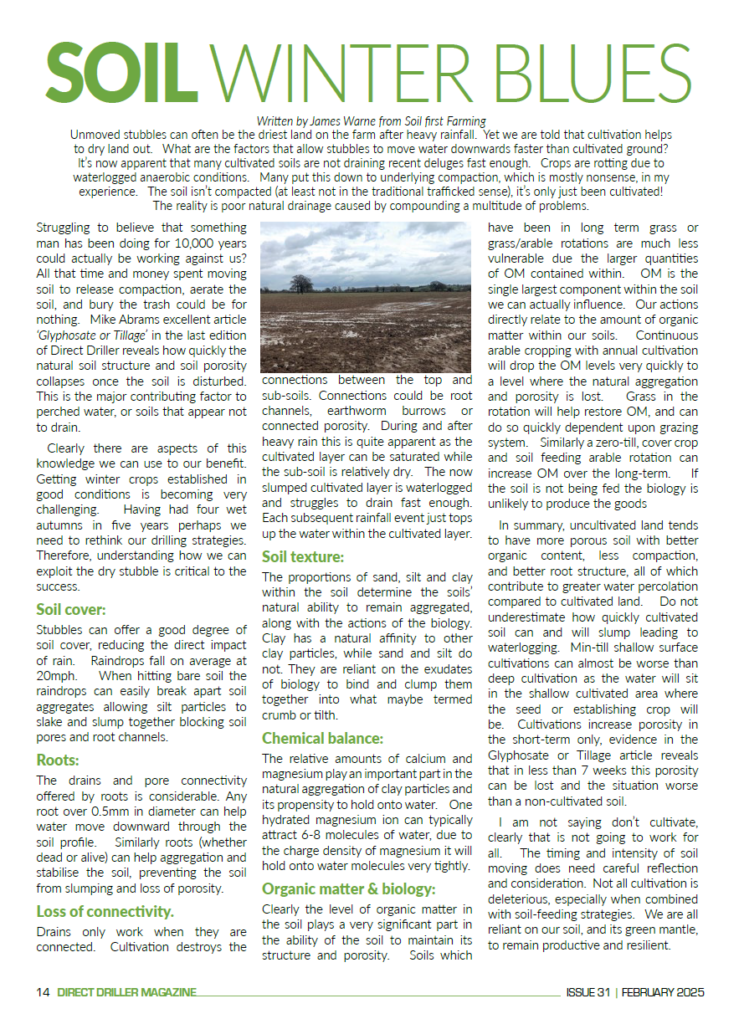
-
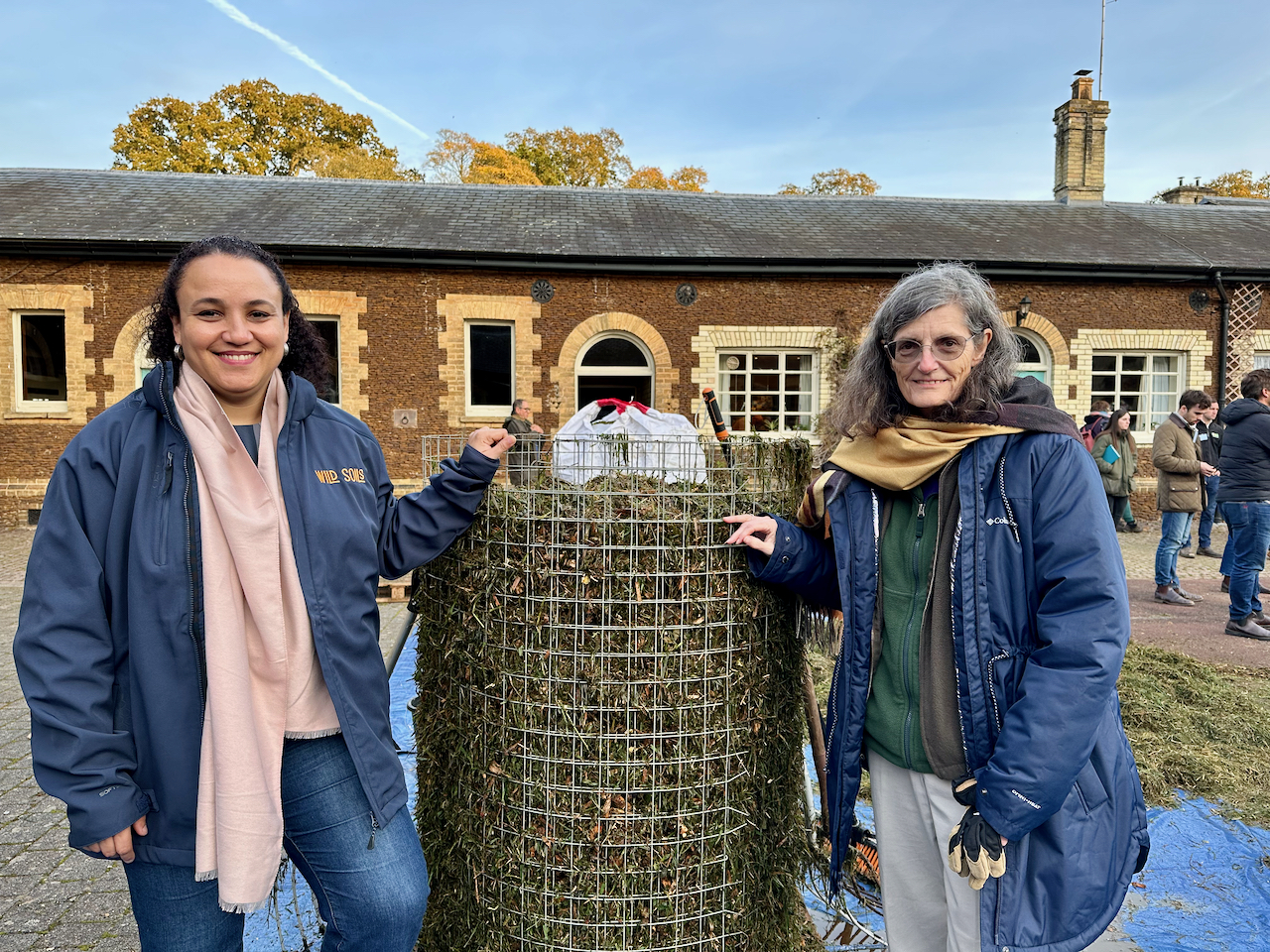
Unlocking the power of soils
Three practical days featuring US soil biology researcher Dr Elaine Ingham about unlocking the power of soil were run by Soil Ecology Laboratory last November. Direct Driller visited the one held in Norfolk
The promise of a day with Dr Elaine Ingham and her team is always likely to attract a crowd and that was certainly the case with the event organised by Daniel Tyrkiel’s Soil Ecology Laboratory in Norfolk.
Elaine, a US-based microbiologist and soil biology researcher, is best known for championing the application of soil food web principles in regenerative agriculture.
As most readers of Direct Driller will no doubt know the soil food web is the complex and interconnected network of organisms that play a crucial role in maintaining soil health, plant growth and overall ecosystem function. A thriving soil ecosystem should also promote nutrient cycling, disease suppression and overall plant health.
In the day’s introductory presentation Elaine ran through the basic principles of the soil food web from how plants converted sunlight energy using photosynthesis into food for soil microorganisms to how those bacteria, fungi, nematodes, protozoa and arthropods interacted and provided functionality within soils.
She also stressed the importance of being able to identify the different types of microorganisms, including distinguishing between beneficial and potentially harmful organisms. Learning to effectively use a microscope to develop this understanding was crucial for making informed decisions about soil management practices, she said.
How to cultivate and work with soil biology was what Soil Domains’ Dr Carla Portugal, an instructor for the Soil Food Web School, concentrated on following Elaine’s introduction.
She described how the soil food web was the foundation of regenerative agriculture, emphasising a balanced and active soil food web formed the basis for healthy plants, reduced reliance on chemical inputs and enhanced profitability, with composting a key tool for cultivating the right type of soil biology.
“Creating a biocomplete compost is the first step to achieving soil transformation,” Carla explained. While it was far from the only type of compost that could be used, she said using thermophilic composting techniques, which keep the developing compost above 55C for long enough to ensure pathogens and weed seeds are destroyed, was Elaine’s favoured choice.
“You can develop your own recipe, but start with 60% of brown, 30% green, and 10% high nitrogen concentration material,” Carla said. “But try to find feedstock as close to the farm as possible as the microbes should already be adapted to your microclimate, and you won’t be adding species that might be harmful.”
Adding soil from local forests or grasslands to add to the compost could also be helpful, she suggested.
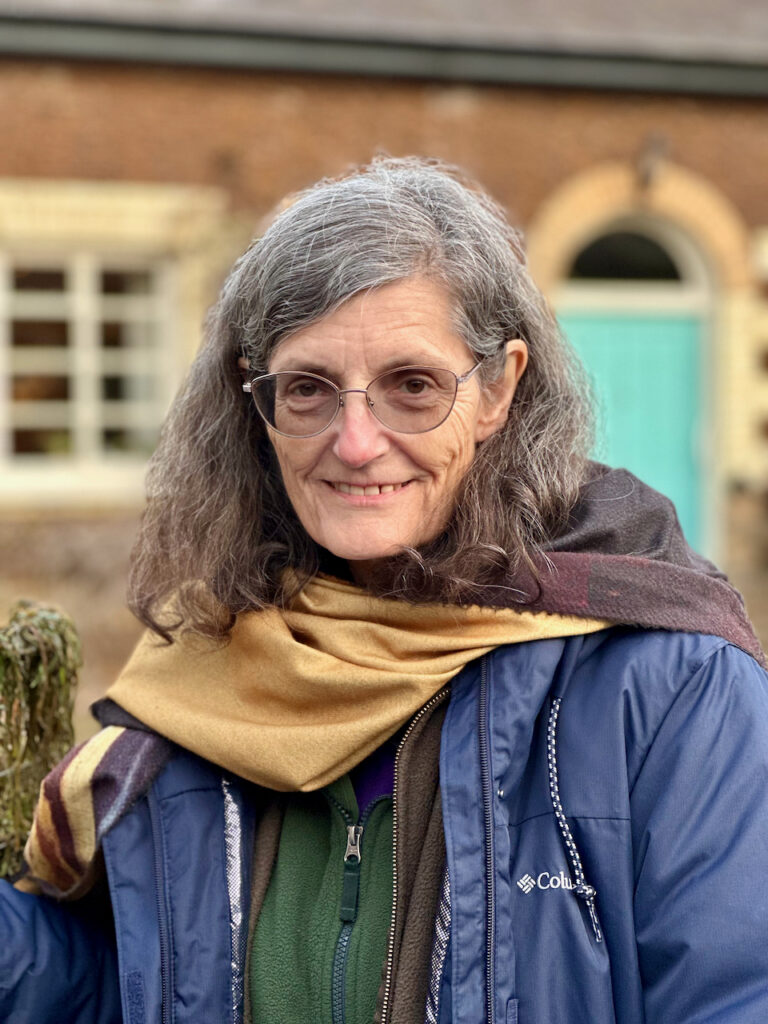
Elaine Ingham 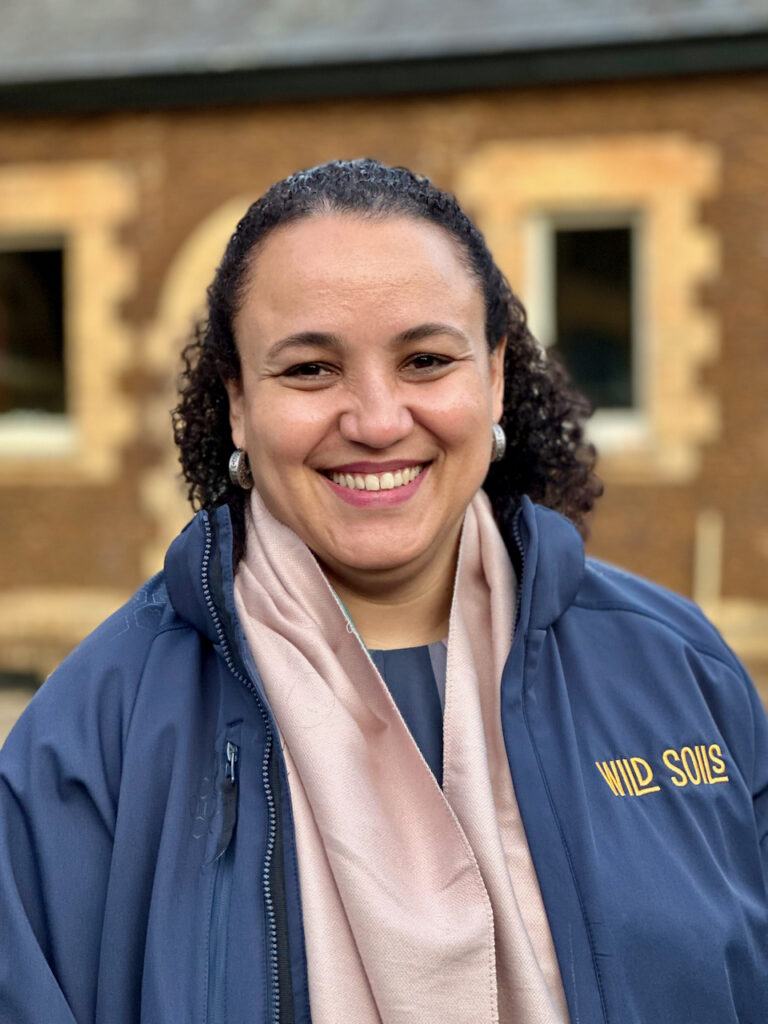
Carla Portugal 
Daniel Tyrkiel Typically piles will need turning at least three times after reaching a minimum temperature of 55C in the centre. She presented guidelines suggesting turning compost piles after 72 hours of temperatures between 55C and 63C; 48 hours for piles between 63C and 67C; 24 hours between 67C and 72C. If temperatures reach above 72C they should be turned immediately or within 12 hours if that’s not possible.
After turning a few times, the pile will reach stage two – the mesophilic stage – when the temperature will reduce, and the compost matures. “This is when the biology settles down, and also the nutrients will stabilise,” Carla said.
Check the microbial composition of the final compost or extract under a microscope, she stressed. “That’s the guide to telling you if you’re on the right track or if you can improve. And if you learn with the microscope what is missing from your soils, you can tailor your amendments to replenish that missing biology.”
That was what Nick Padwick has started to do on the arable land at Ken Hill Farm and Estate in west Norfolk.
With a strong remit to implement regenerative agricultural practices on the farm since his arrival as farm manager in 2018, he sought guidance from Elaine and the Soil Food Web School team after becoming frustrated with the time it took to get results from conventional soil analyses and their accuracy.
Having completed the Foundation course, which provides background to soil science and biology and application methods in a series of 63 online lectures, he followed up taking the consultant training programme which puts the theoretical into practice.
A key aim where growing cereals is to have approximately equivalent amounts of fungi and bacterial biomass in the soil, with higher microbial biomass levels contributing to higher yields, better retention of nutrients, deeper root growth and more organic matter sequestration.
But like the majority of the 400 soil samples he has analysed from other farms as part of his new consultancy Wild Soils, he found his soils were bacterial dominant, with low fungi and protozoa counts.
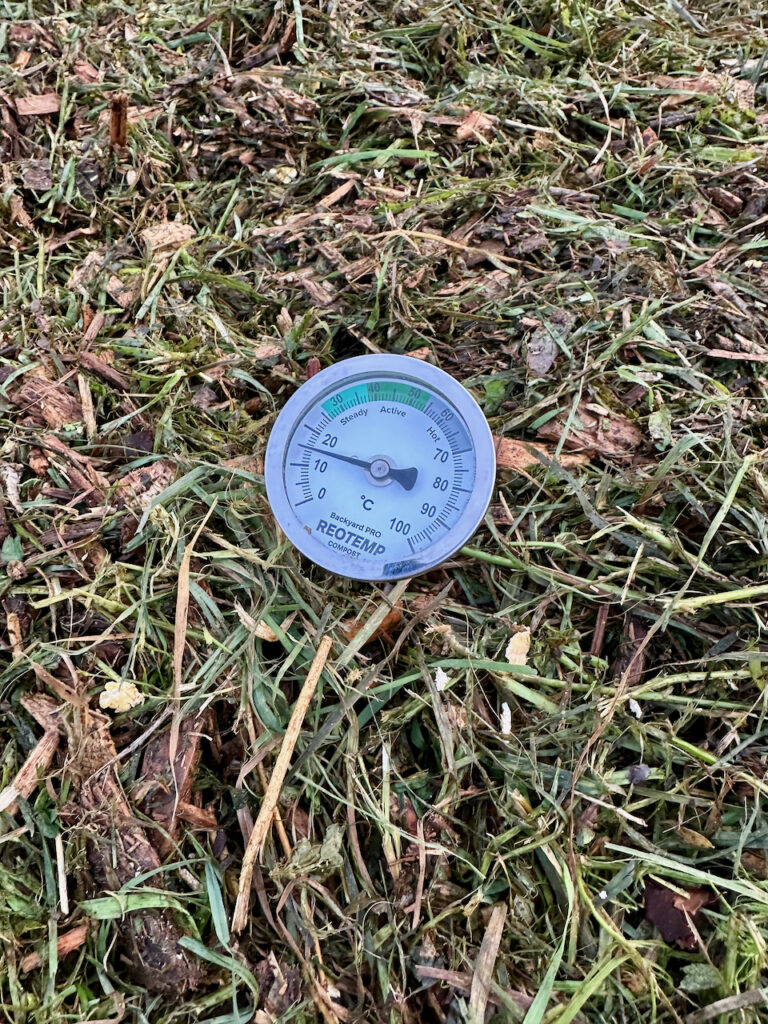
Compost thermometer Nick explained he began making compost in relatively small-scale circular wire mesh towers, but quickly realised that he would need to scale up to be able to make the volumes required for broad acres.
He uses wood chips sourced from woodland areas on the farm as his brown material, while herbal leys and clover understories grown within SFI / Countryside Stewardship schemes have proved to be a good source of high nitrogen and green material.
“I’ve planted the herbal ley so that it is clover or nitrogen dominant, with some grasses, to hopefully get the right diversity of green and high N material in the windrow,” he explained.
When laying out the windrow, Nick stressed the importance of having enough moisture – when squeezed a couple of drops of water should come out. His compost turner is equipped with two IBCs and a pump to apply water during initial mixing of material.
“We’re putting on between 20-100 litres/m of water on windrows that are 250m long.”
Nick records daily temperature and moisture readings from each side and the top of the windrow to monitor when to turn the piles. “Having a log helps with our composting process,” he said.
The compost is then applied either as a 5t/ha direct amendment or as an extract to use through the season. For the latter he uses a custom-built Tow and Fert sprayer with a perforated basket that takes around 200kg of compost.
“The basket drops into the tank, like a cartridge going into a slot, and water flows through the compost, spinning it around,” he explained.
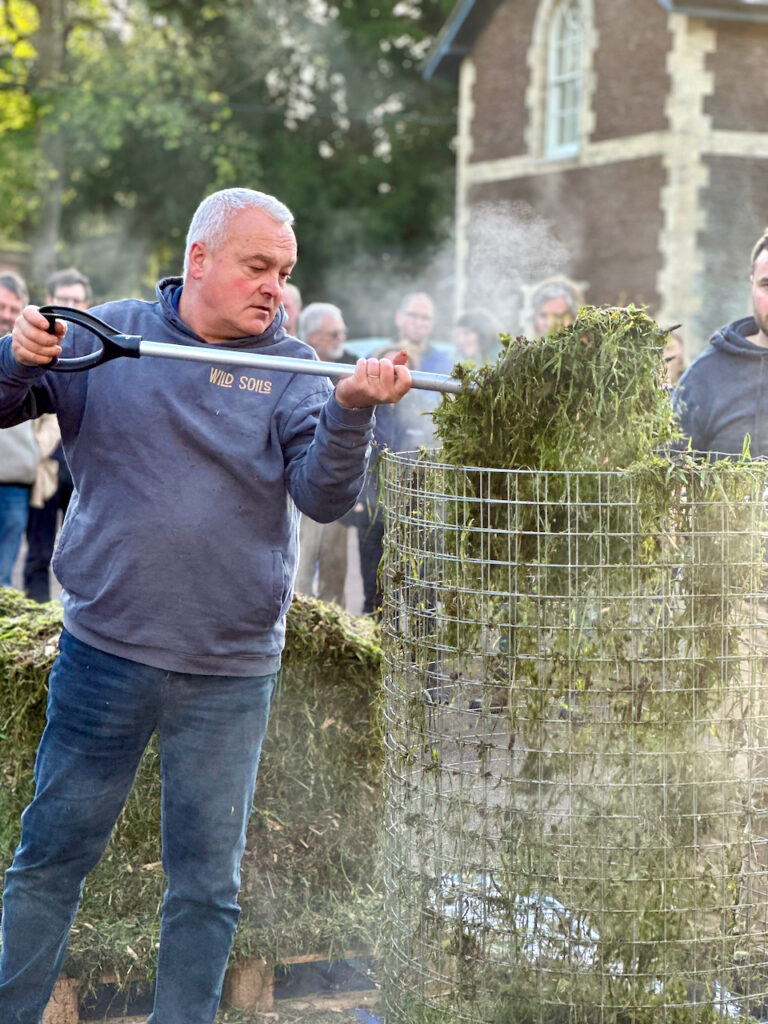
Nick Padwick “All the goodies come out of the compost and into the water. When I take basket out after putting 4000l of water in, I end up with washed wood chips. It has made an extract that I’m able to apply at 400l/ha using 13mm nozzles. At 10ha/load I can treat 150ha/day, its game changing compared with the 15ha/day I could do when making extracts from compost towers.”
Early results for increased use of compost looked promising, he said. Soil analyses show fungi: bacteria ratios are moving closer to the desired 1:1 ratio at around 0.6:1 compared with just 0.01:1 a year previously. Fungal and protozoa biomass have increased too.
“We’ve certainly seen a change in our soils,” he said.
The next step will be replicated trials to assess crop performance with and without amendments in the coming season.
That was work the Soil Ecology Laboratory had already started doing using their NutriBridge compost extract product – sometimes known as “The Goop”, the Lab’s director Daniel Tyrkiel said.
“In compost, we’re able to cultivate almost all kinds of beneficial microbes apart from mycorrhizal fungi, including bacteria and fungi that can efficiently capture nutrients from the environment, and protozoa and nematodes that mineralise these nutrients into plant available forms,” Daniel explained.
“In the past, if you wanted to experiment with such diverse mixes of organisms you had to perfect compost making, then extraction and application. What we’ve done with NutriBridge is not only increase the repeatability of production, but also provided the convenience of a ready-made solution, which can be used on its own or in combination with inputs.”
The first trial with the product was in a spring barley field that had received an application of compost from a green waste local site. The trial compared three applications of Daniel’s NutriBridge prototype versus a water-based control and conventional treatment including 100kgN/ha and crop protection chemicals.
There was a 40% difference between the control and the biology treatment, suggesting the biology unlocked the nutrients in the applied compost better than the native biology in the soil, Daniel suggested.
And while the treatment only achieved 70% of the yield of the conventional treatment, he thought the results suggested the potential of cutting N applications by 20-70% without any loss of yield, and at a much lower growing cost.
A follow up trial in winter wheat also suggested NutriBridge could unlock 70-90kgN/ha for the crop.
Another potential benefit from NutriBridge could be to help soil recover from glyphosate applications – for example, following cover crop termination. A trial where pasture was established following various different establishment techniques showed higher biomass production where the product was used following glyphosate application compared with a conventional fertiliser application.
In comparison, where other establishment techniques, such as ploughing or grazing was used before the grass was drilled, there was greater biomass from the fertiliser treatment.
“The hypothesis is that higher rates of glyphosate knock back the soil biology and then the extract helps it recover,” Daniel concluded.
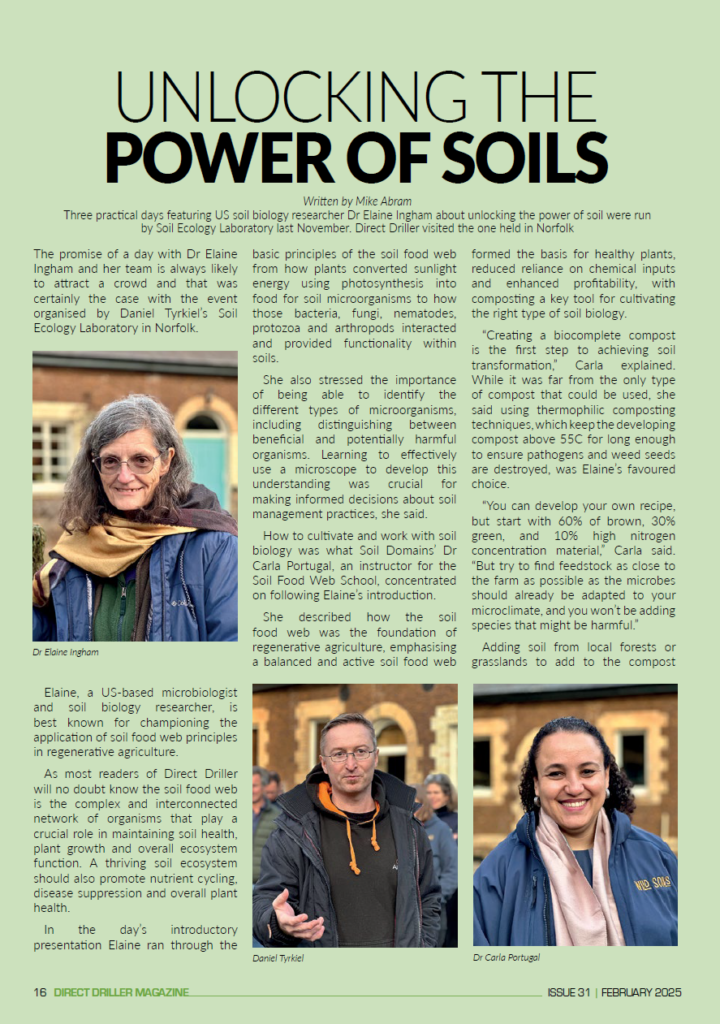


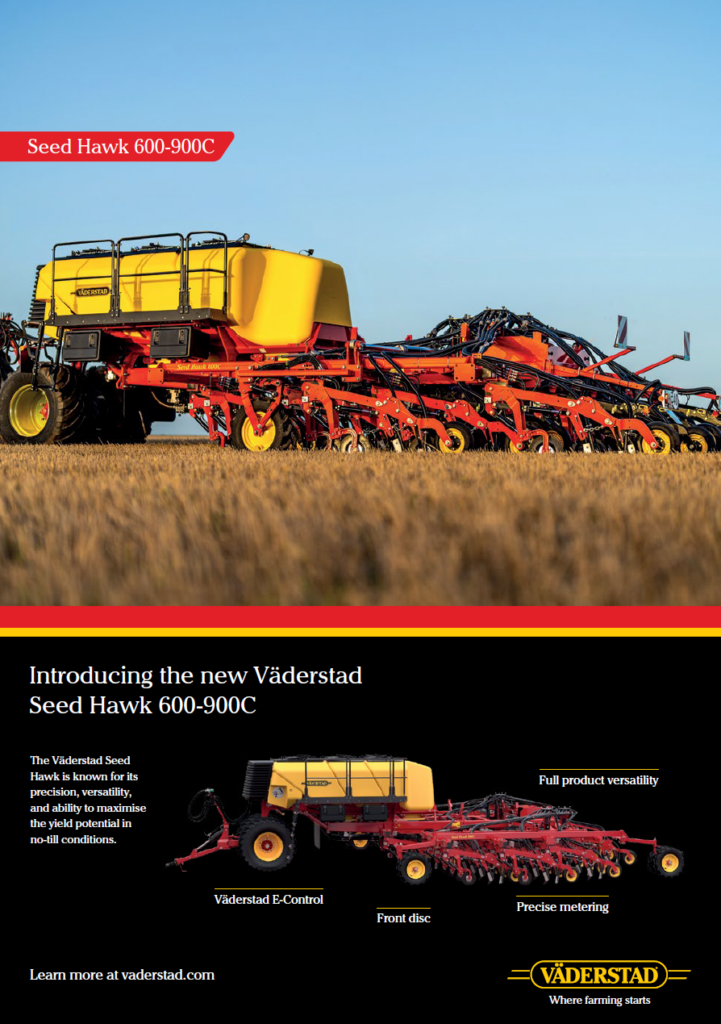
-
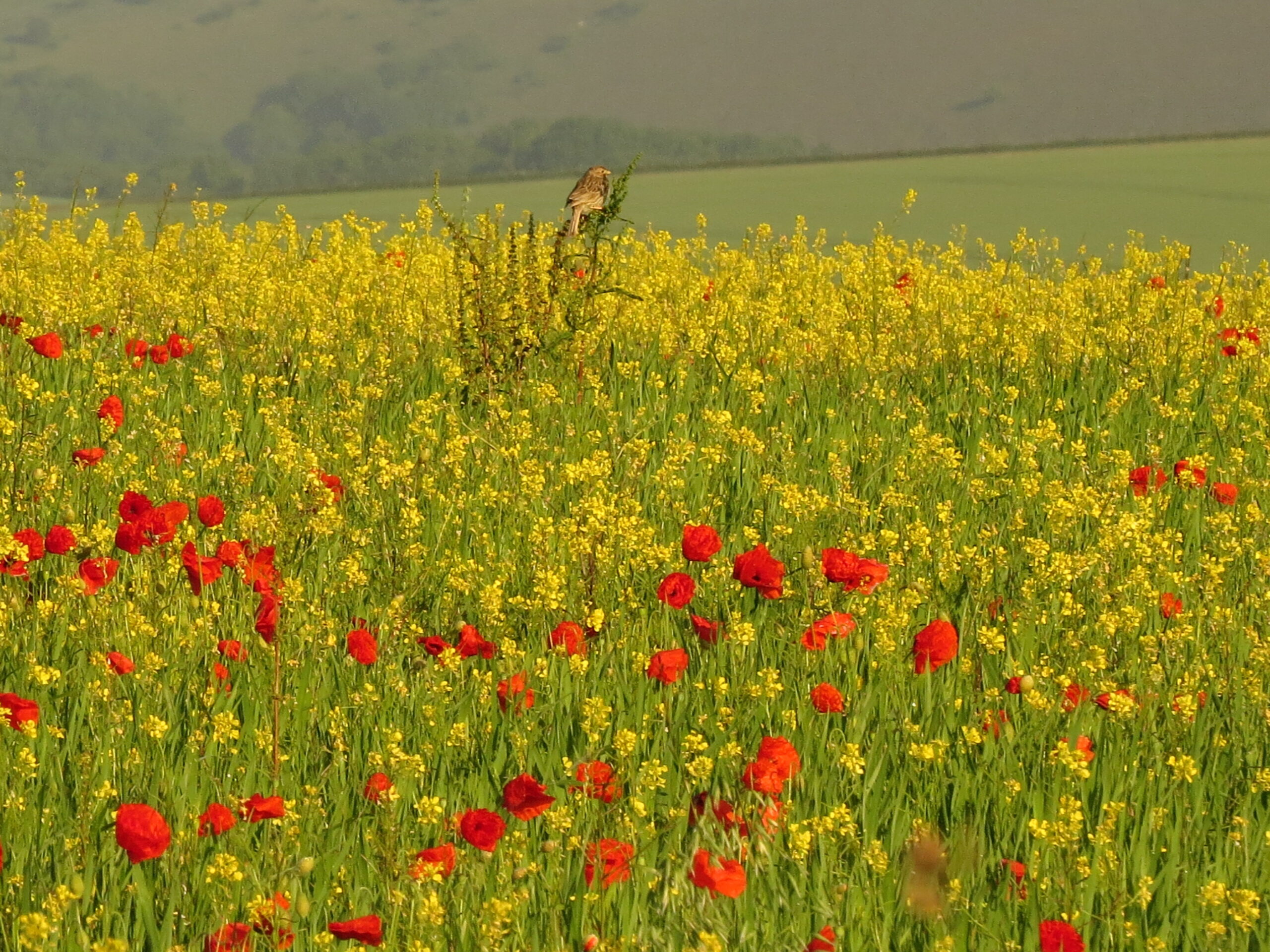
Balancing Wildlife and Farming at Lower Pertwood Farm
Written by Nick Adams, Wildlife Consultant, Lower Pertwood Farm
The winds of change are blowing strongly through the Agricultural sector. Leading the charge is the word “wilding” with all its different permutations and options. Lower Pertwood Farm has always had a strong commitment to its wildlife and is fortunate in that it has many acres of land committed to scrub, gorse, woodland and steeply undulating fields which are typical of the Wiltshire chalk downlands in the AONB designated area. For the last 20-years – the last 10 of which has been under the guidance of myself, a freelance naturalist with a sensible approach to the subject – Lower Pertwood Farm has chalked up many successes regarding the creation of habitats which allow certain species to thrive. The true measurement of this is their ability to find a habitat that protects them and provides access to a food source that sustains them.
Wilding is a term that can cause mixed reactions in both the Farming and Conservation communities. From my point of view, I see it used to cover a myriad of conservation work; things that have been carried out for decades with considerable success are sometimes rebranded as cutting-edge. Whereas processes and options I could only dream of are now happening. Farmers I have the pleasure of working with sometimes see it as an attack on their way of living; a push for them to cease food production on their entire holdings and give the land over to species like beaver and pine marten.
At sites like Lower Pertwood, which in recent decades has been c1,000 hectares of mixed organic farming with some mixed conventional farming in the last five years, due to the size and variation in habitats, there will be opportunities to farm for wildlife, humans, carbon and water.
On my first visit to the farm, in late Autumn, it was clear that certain bird species were doing well, namely farmland birds like skylark, linnet, yellowhammer and in particular corn bunting. The first stage of assessment was a year of baseline surveys, to work out where the hotspots were for these species and then to try and work out why that was the case. Perhaps the most important part of my job is finding the current successes, as we might be able to build on those more easily.

using a Garford hoe in February. Monitoring the
impact of changes in farming process is vital.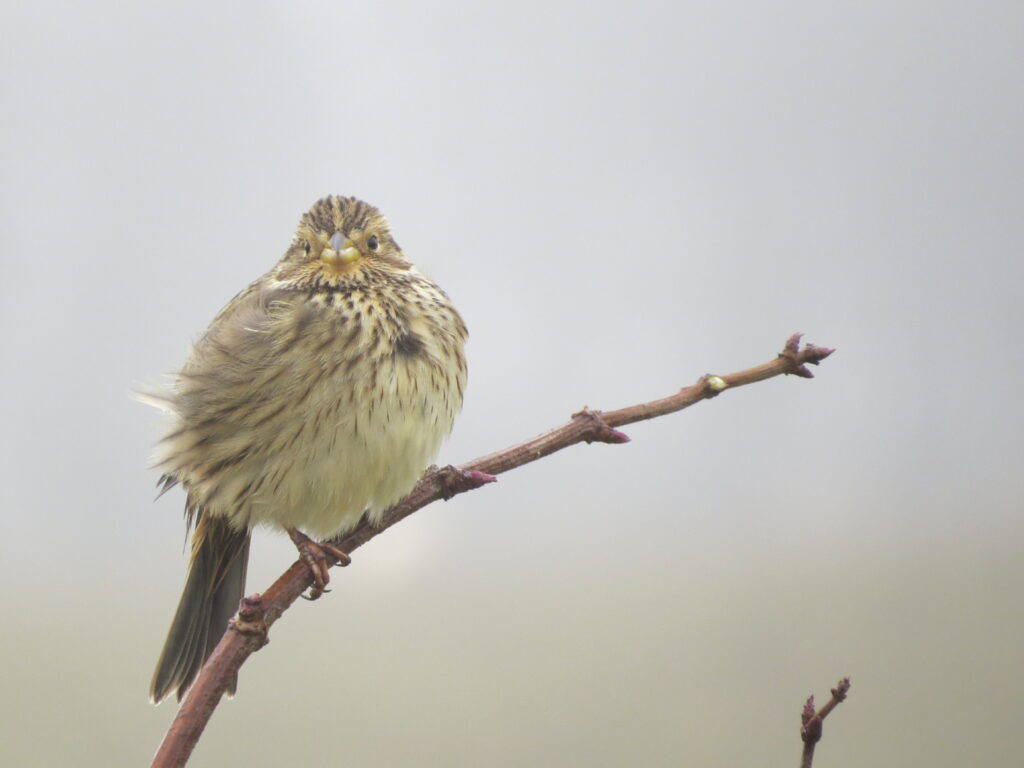
a male corn bunting looking to establish a territory
in February.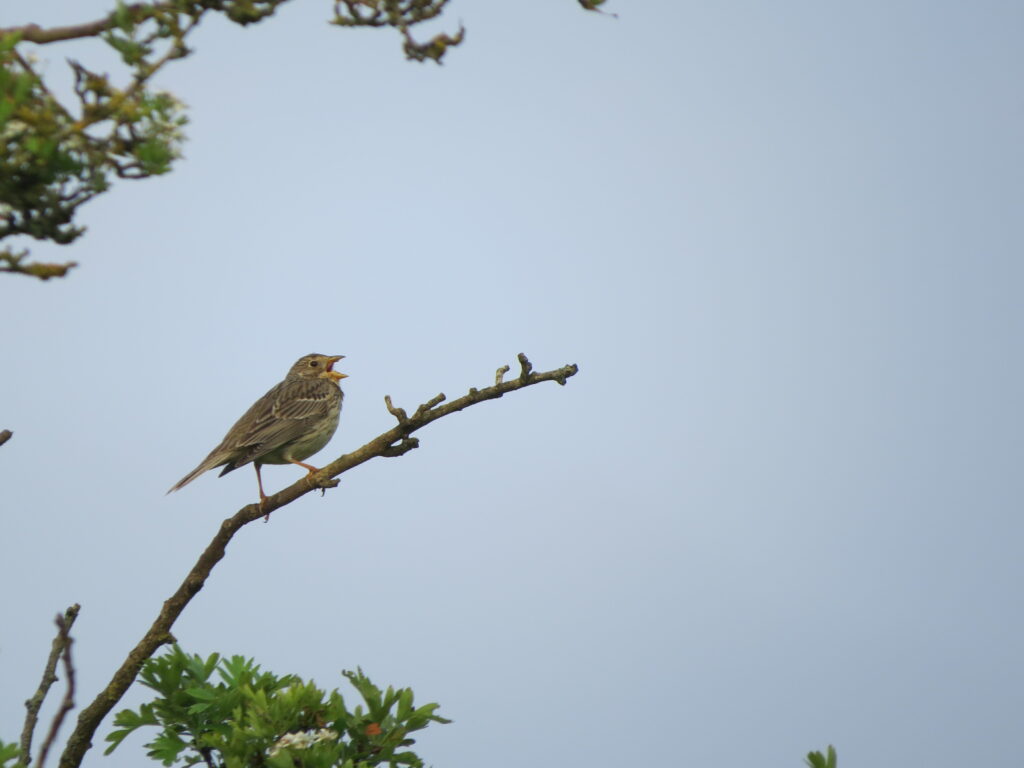
a male corn bunting on an established territory in
May.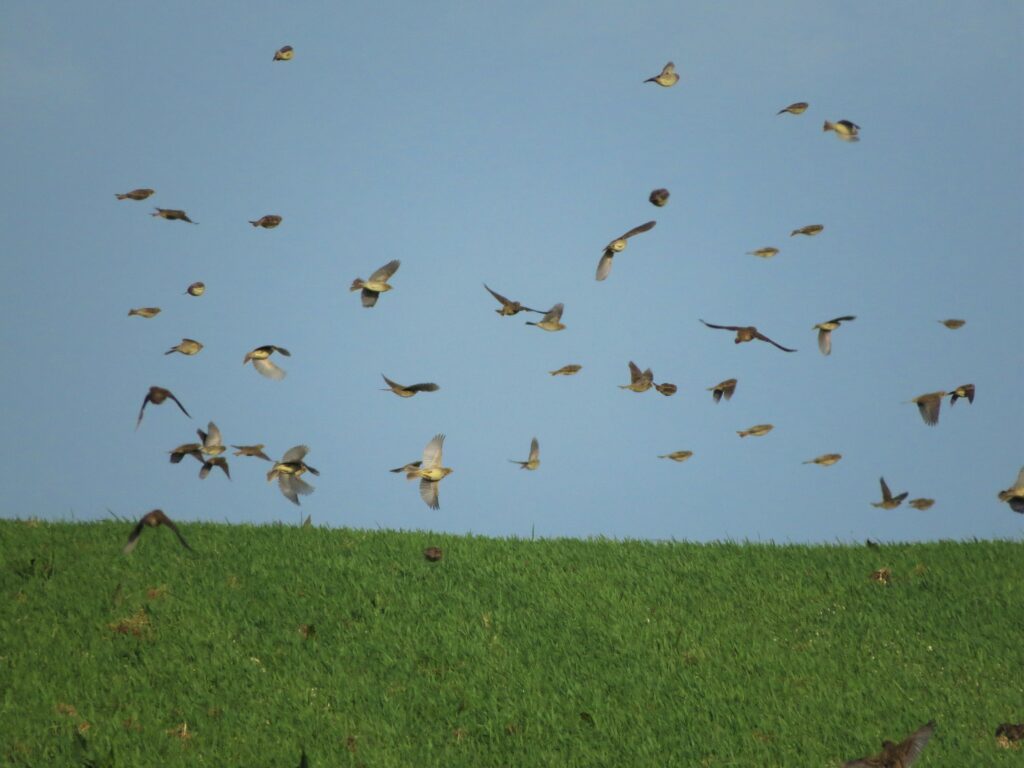
late winter flock of corn bunting in a field of Organic winter barley. Throughout this year, I was having discussions with the agronomist, the landowner and the farm contractor which helped me understand what had happened in the hot spots. Giving positive feedback on what was working and starting to form ideas of what we could consider doing to improve other areas for wildlife. These relationships were vital, two-way communications to show we appreciate each other’s aims and will listen to other’s opinions. We undoubtedly hit the ‘no Nick’ line a few times. This is where I suggest something that is just that bit too much of an impact on the farming process, the response being ‘no Nick, we can’t do that’, the key was the next bit ‘and here’s why’. From there we can further discuss the outcomes we are looking for and often as not, tweak what is happening already or what I was suggesting just a little bit, so it benefits the wildlife without impacting the farming significantly.
A great example of this would be when I was trying to find ways to improve the breeding success of the corn bunting. This ground-nesting bird was doing well in the cereals, especially spring oats where they would fledge two broods due to the relatively late harvest date. Almost unheard of in a lot of their range as they do not start to nest until the end of May, fledging their first brood in early July.
Being organic, there were significant amounts of herbal leys. Some were cut for forage; others were grazed during the summer and some might just be topped. The baseline surveys had shown me which fields were the priority ones for breeding. This greatly reduced the ‘discussion’ points. For the first Summer after the baseline surveys, we had two fields to consider. Field one had one of the densest populations of corn bunting I had ever seen, 25 territories, a true sacred cow. Field two was important, but not on this scale with six territories. For context, the UK breeding population for corn bunting at the time was around 10,000 territories, a site with 1% of the UK population (100 territories) was considered nationally important, the surveys showed a population of c130 territories. Therefore, these fields were a key part of a nationally important population.
For field one, we had a robust discussion about the available options. It was agreed to take a haylage crop, at the point the corn bunting chicks fledged. I suggested a time of around 10th July for this. As it turned out, this was the date the chicks were on the wing with sufficient strength to avoid the machinery and cutting commenced in the afternoon. The adjacent field had been cut at a more standard time of the year and had regenerated sufficiently to offer immediate cover.
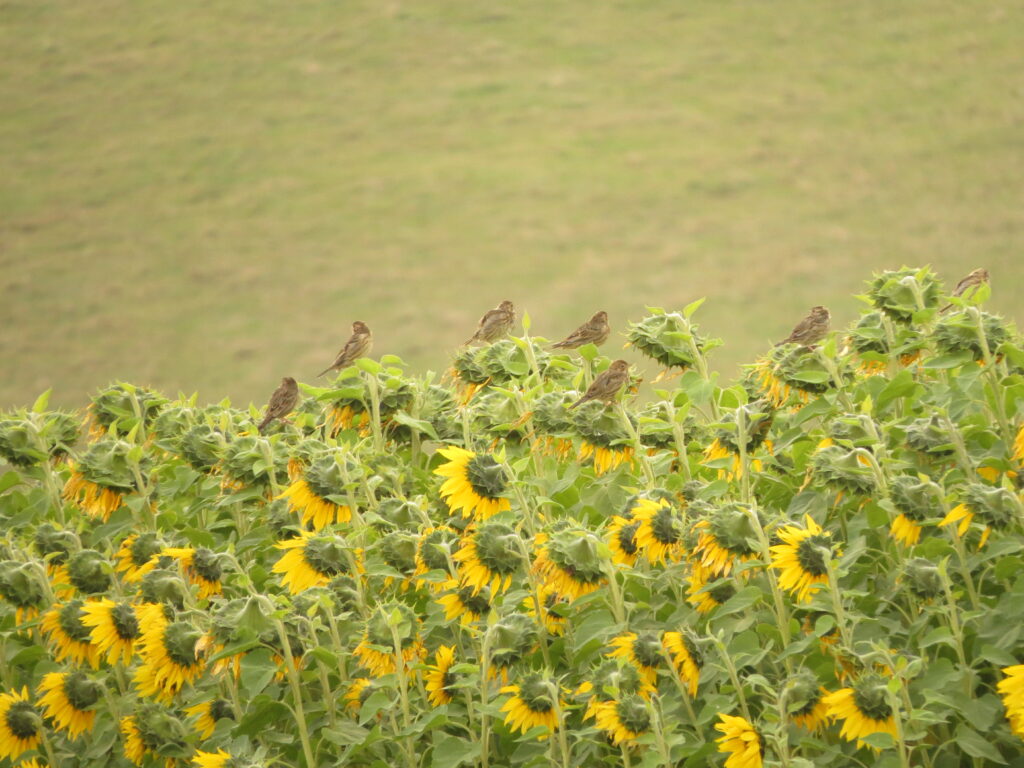
juvenile corn bunting feeding on invertebrates on sunflowers For field two, we tried a different approach. A relatively early cut for silage on 20th May, a week or so before the corn bunting would start to nest. Then another late cut in August for haylage. This gave the farm two crops and the corn bunting enough time to produce two broods. We were lucky with the growing year and after the initial cut, rapid regeneration gave the corn bunting a safe area to commence nest-building at the start of June. It turned out to be an all-round success; instead of the expected six territories, we managed 15.
Through open discussions, everyone was able to get mostly what they would have got if they were solely driving the farming processes. We all gained a lot of knowledge. Using these sort of tweaks, coupled with being proactive as everyone knew which fields we needed to discuss well in advance; we managed to increase the corn bunting population by 87% in three breeding seasons, with no reduction in the amount of productive land. Taking it to close to 2.5% of the UK population.
With animal welfare front and centre at all times, we were able to identify a number of nature tweaks. Others were as small as changing the grazing times by a few days on species-rich grassland year-on-year, to reflect that growing season or perhaps fencing off critical areas allowing the vast majority of the grassland to be grazed. This meant it was possible to get endangered butterfly species like Adonis blue and marsh fritillary back on the farm by ensuring their food plants were allowed to grow sufficiently.
The farm was doing great things for wildlife by farming before I was involved, there just wasn’t any recognition of exactly what they were doing. Once that was recognised, we could build on it. The opportunity was there to diversify into farming for wildlife and humans. Additional funding opportunities are now available, as are a number of extra challenges. If we keep having robust, open discussions, there is no reason why we cannot farm in a positive way for all interested parties.
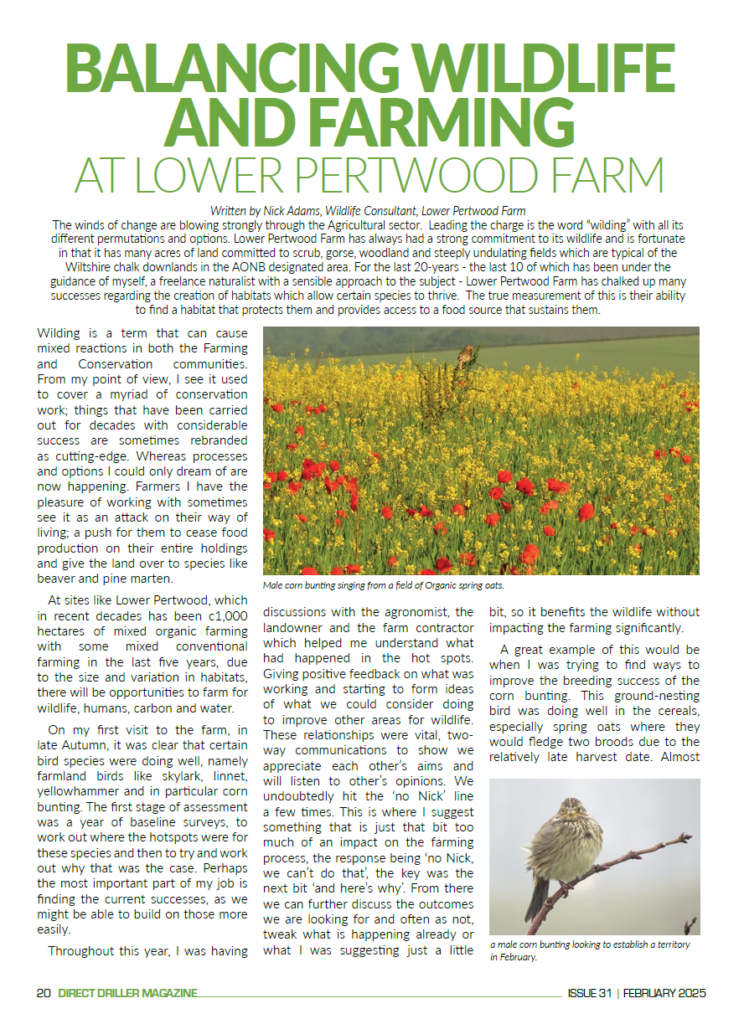
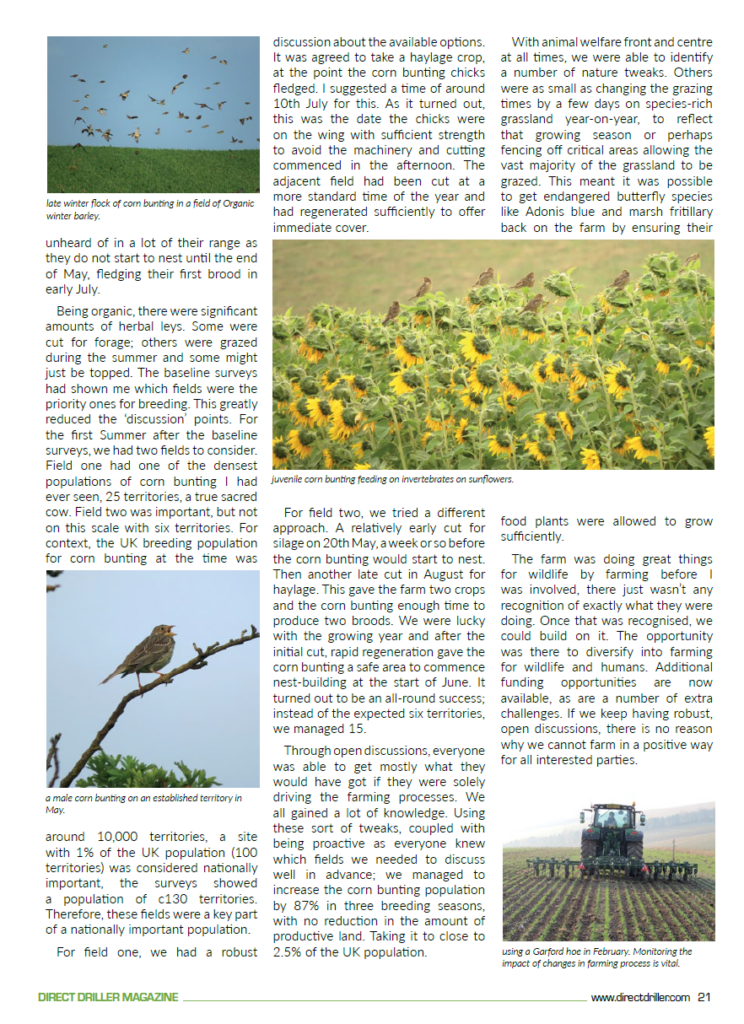
-

Cover crop champion update
A network of cover crop champions is providing a practical view on the impact of cover crop approaches. Technical Content Manager Jason Pole provides an update on the AHDB Cereals & Oilseeds’ initiative.
During summer 2024, we asked farmers growing cover crops ahead of various cash crops for harvest 2025 if they would be willing to share their experiences. The request came with a catch: participants would need to use on-farm trial design principles to help us gauge the effectiveness of their approaches.
The eight appointed cover crop champions are following five key steps:
- Identify the reasons (aims and objectives) for growing the cover crop
- Grow a few options (including controls, where possible)
- Monitor and record progress
- Evaluate the response
- Respond to the evidence
East Anglia champion
Our champion in East Anglia provided the first post-emergence update of the campaign. Bury Farm in Essex has been in the hands of the Clarke family since the 1920s. The rotation features winter wheat, borage, spring barley and canary grass. Jonathan Clarke, who also has a herd of Red Poll cattle, is working with other farmers in the area to increase biodiversity and improve the local river catchment (the farm is near the River Roding).
As cover crops are only being grown on the farm for the second time, they are experimenting to identify what works best in their system, with three establishment techniques currently under test.
- Direct drilled into stubble.
- Broadcast followed by harrowing over the top (lightly scratching under the stubble).
- Broadcast with a light cultivation.
In late August, they sowed a six species cover crop mix that contains buckwheat, crimson clover, hairy vetch, linseed, phacelia and a specialist fodder radish (Smart Radish).

Left to right: Harry Moffat and Archie Humphreys (Oakbank Game & Conservation Ltd), Jonathan Clarke (Bury Farm) and Amy Catling (AHDB).
Diverse roots revealed
Harry Moffat, from Oakbank Game & Conservation Ltd (which part-funded the trial), dug up samples on 4 October and placed them side by side (on a spade) to reveal the rooting characteristics:
- The buckwheat was already going deep
- The radish had long, thick roots
- The linseed had long, thin roots
- The vetch had many thin roots, which were reluctant to let go of the soil
- The phacelia was just getting going
- The clover was sparse (with no good samples available for sampling)
The cover established via broadcast methods was also slower to get going, due to poorer seed-to-soil contact.

Above: Plants from the cover crop trial field in Essex showing diverse rooting characteristics. Left to right: volunteer borage, radish, linseed, phacelia, vetch and buckwheat.
Interestingly, the most impressive roots were from volunteer borage. Borage was cropped in the field two years ago, with its offspring taking up residence in the field’s seedbank. Compared to the cover crops, it had a head start and featured the thickest roots of the bunch. Jonathan isn’t too concerned as it all adds roots to the mix and it should be knocked back by the first hard frosts.
Although not unexpected, where the land was lightly cultivated, borage’s growth was clearly subdued – unlike where the cover crop was direct drilled into the stubble of the previous crop, where borage was already waist height.
The presence of diverse roots should help maximise the benefits of the cover. For example, it will improve the overall structure of the soil and mine nutrients deep within the soil profile. The legumes will also fix nitrogen (with nodulation already visible on the vetch). The buckwheat provided early flowers for the pollinators too. Once again, it should break down at the first good frost.
Other champions
Scotland (Sweethope Farm, Scottish Borders). David Fuller-Shapcott will test if a biostimulant seed treatment (based on endophytes) can improve the germination and establishment of two simple cover crop mixes.
Northern Ireland (Caledon Estate, County Tyrone). Chris Gill will use sheep to graze a hybrid kale cover crop at two grazing intensities (high and low).
North East (Crawleas Farming, County Durham). Robbie Stephenson will test a bespoke cover crop mix to boost biomass for sheep grazing ahead of planting potatoes (it will be compared with the farm’s traditional mix and a no-cover area).
North West (Reaseheath College Farm, Cheshire). Charlie Copley will use various cover crop mixes and compare them with overwinter stubble. The trial will underpin discussions with students about using cover crops to protect and improve soil after a maize crop.
East Midlands (Brixworth Farming, Northamptonshire). Ian Matts will use sensors to track soil nutrients and moisture to assess the impact of cover crops (such as how well legumes fix nitrogen and buckwheat scavenges phosphorus).
South East (Welford Estate, Newbury). Rob Waterston will use a multi-species mix to deliver diverse root architecture and strong biomass (with potential for grazing), with the ambition to reduce artificial nitrogen inputs in his spring malting barley.
South West (Lower Baynton Farm, Wiltshire). Bob King will use a diverse, multi-species cover crop for grazing by sheep during winter before direct drilling spring crops. The trial will quantify the wider benefits of cover crops.
Termination tips
AHDB is also working in partnership with the creators of the Cover Crops Guide to secure the guide’s legacy and keep guidance up to date. Yorkshire farmer Angus Gowthorpe, who led the first phase of the Cover Crops Guide (with funding from Innovate UK), said:
“The Cover Crops Guide provides independent information to help farmers select, establish and terminate cover crops. It was co-designed by farmers with the help of the Yorkshire Agricultural Society’s Farmer Scientist Network. The AHDB-funded cover crops champions align with the guide’s practical approach and will further strengthen the practical, independent information available to farmers.”
One of Angus’ top tips is to make sure that cover crops are terminated in sufficient time to avoid a negative yield impact on the following crop. A rule of thumb is to destroy a cover crop six to eight weeks before the intended drilling date of the following crop to avoid a yield penalty. Naturally, very early termination (pre-Christmas) provides the longest time for the cover crop residue to die back. Generally, light/medium soils are more forgiving. Critically, it is important to ensure termination dates are compatible with any rules in farm agreements.
The Cover Crops Guide website features a section on termination, in addition to a species selection tool, establishment guidance and information on soil health.

Cover crop evidence
AHDB has also recently commissioned desk-based evidence reviews to boost the independent information available to assist with many aspects of growing cover crops, including destruction methods and nutrient management implications. The first practical findings will be available next summer, in time to guide cover crop choices. We will also continue to tell the story of the cover crop champions over the next few months on the AHDB website.
ahdb.org.uk/cover-crop-champions
Follow the journey
To keep up to date with the latest news from AHDB Cereals & Oilseeds, sign up to receive Arable Focus magazine.

Above: To help monitor and record treatment impact, each cover crop champion is using the AHDB soil health scorecard. This includes the visual evaluation of soil structure (VESS) based on a carefully extracted soil block (pictured).
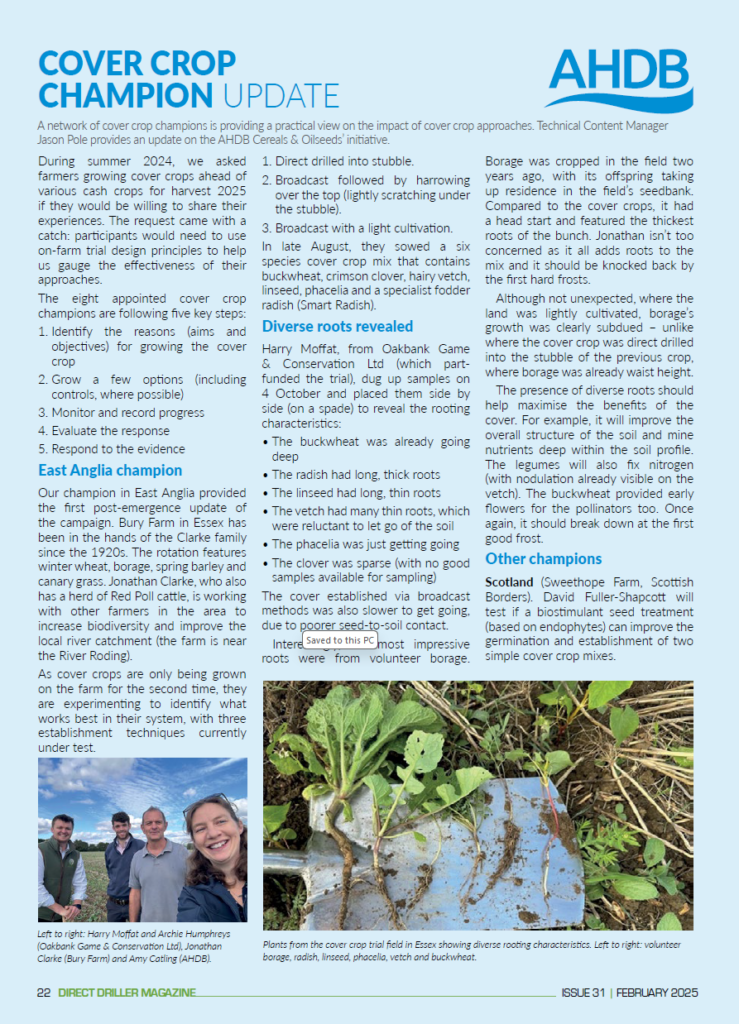
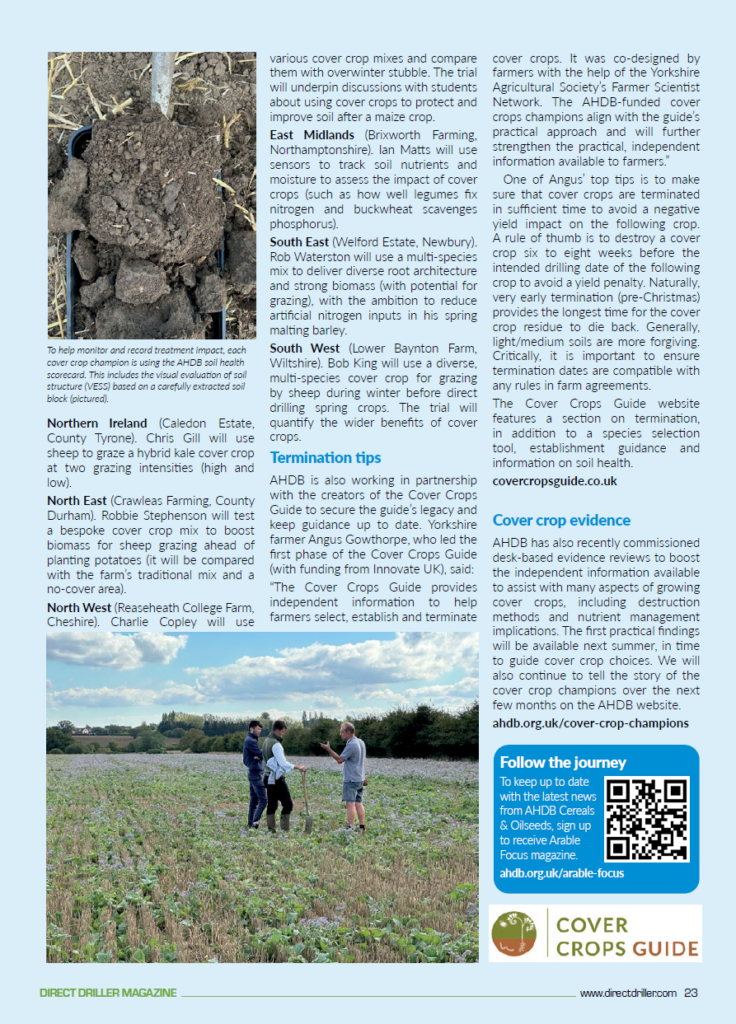
-

We’re changing how we manage the Claydon farm
In a political environment where farming is battling increasing headwinds, Suffolk arable farmer and inventor of the Claydon Opti-Till® direct seeding system, Jeff Claydon is focusing on minimising risk and maximising income.
November 2024
I have always been an optimistic farmer, but right now I am struggling. I’m not normally one to get political, but like many people I feel massively let down by our politicians, who seem intent on destroying farming and the rural infrastructure. Everyone from local shops to agricultural machinery dealers form an essential part of a thriving, healthy countryside, but their livelihoods are at risk from a lack of cash and investment. Many businesses have been lost in recent years and the trend seems likely to continue if those in Westminster carry on along their current path.
We live in a high-risk world, one in which many promises are being broken. Everything is far more complex than it needs to be, and the only certainty is more uncertainty. You only need to look around to see that almost everything has stalled, and not just in the UK. Traditional industries throughout the western world are being destroyed by governments and their punitive, nonsensical legislation which is stifling innovation and investment. Farming is no different, so one must question why this is happening and what is driving politicians to follow this ruinous path. How much more of this can industry take before the last straw breaks the camel’s back?
In the twelve months leading up to the election the Labour Party gave repeated reassurances that they would not tamper with Inheritance Tax Relief (IHT), Agricultural Property Relief (APR) or Business Property Relief (BPR). The Chancellor’s recent actions broke all pre-election promises and this brutal attack on farming and other businesses should concern everyone in the country, particularly given the fragile state of global relations at a time when the UK relies heavily on imported food.
The measures announced in the Autumn Budget risk confining family farms to the history books within a generation. Huge numbers of farming operations will have over £1 million invested in machinery and stock alone, all working capital, while significant increases in the minimum wage and employers’ National Insurance contributions will further reduce profitability. This will dampen any desire for the next generation to join the business, seriously questioning the incentive to invest for the future. On the face of it there seems to be a lot of pressure being put on employers with legislation and demands, and now with the attack of APR/BPR, it seriously brings into question this Government’s commitment to mental health and wellbeing.
As if this wasn’t enough, the changes to the Basic Payments Scheme which Defra announced concurrent with the Autumn Budget will see direct financial support for farming end far more quickly than any of us had expected or planned for, any small concessions being a drop in the ocean in comparison. In a world where many people feel that they are owed a living and are reluctant to get their hands dirty one questions who will take the farming and manufacturing sectors forward in the future.

This 30ha field on the Claydon farm was direct drilled with Elsoms Bamford winter wheat and beans, qualifying for SFI direct drilling and companion crop payments. The CLA and NFU are doing sterling work to highlight the importance of farming and rural businesses, but it is painfully apparent that politicians simply do not understand, or want to understand, this industry, economics, or what it takes to operate a successful business. Developing and growing a successful agricultural machinery business has been the Claydon family’s major diversification from farming over more than four decades, so we take every opportunity to get the message across to local, regional and national government.
Over the last four decades Claydon has grown from nothing to a multi-million-pound company, reinvesting all profits left after taxation and now employing over 80 people. This year alone, based around our range of Opti-Till® crop establishment machinery, we have won a raft of awards for contributing to farming and manufacturing. These include the 2024 Regional Global Britain Business of the Year, part of the prestigious British Chamber Business Awards, the Investing in West Suffolk Award sponsored by West Suffolk County Council, and Suffolk Farming and Wildlife Advisory Group’s Peewit Award for Excellence in Ecological Farming.
Small and Medium Sized Businesses (SMEs) have traditional relied on being able to staircase their development and growth over generations, but this could end for individuals with the demise of APR/ BPR. The government purports to help, but constant increases in legislation and taxation and the removal of APR/ BPR will mean that the only businesses which survive in the long term will be faceless institutions/ corporations which last indefinitely and pay no inheritance taxes. Who will the entrepreneurs for future developments be without sound capital funding to ensure that the businesses continue after their demise? Undermining of viable businesses through short term tax gain and disruption will destroy the future of the company, reduce future tax revenues and seriously impact employment opportunities.
MOVING FORWARD
Having got that off my chest, how then do we, as farmers, move forward? The lack of clarity from government has led to delays in processing grants and payments, with a corresponding knock-on effect throughout the agricultural industry. Under the threat of budget cutbacks our friends at Defra appear to be finding it very difficult to roll out the Sustainable Farming Initiative (SFI) and other grant schemes they administer.
Farming Equipment Technology Fund (FETF) 2024 grants are very welcome, providing a maximum grant value of up to £8400 or 50% of the purchase price of our Straw Harrows and £40,800 or up to 60% of the purchase price of our drills which deliver fertiliser with the seed. Announced in February, they were to be available in three tranches throughout the year. However, I wrote my last article on the final day of August and there is still no news on the grants. This is extremely frustrating for farmers waiting to order a Claydon Drill or Straw Harrow as well as for the machinery manufacturers/dealers who supply them who will suffer knock-on disruption, cost and upheaval in their production and supply chain.

When I started farming everything about the industry was positive. New fertilisers, agrochemicals and machinery were coming on stream, while help and advice was freely available from the Agricultural Development and Advisory Service. Now, with bureaucracy and red tape the order of the day, it seems like everyone is trying to trip you up at every turn.
As a born farmer who loves nothing more than growing crops, despite significant weather-related and other issues, I’m still up for the challenge of producing food to help feed the nation. But it is becoming much, much more difficult to turn a profit. In recent years, like many others, we have struggled with oilseed rape, primarily due to the combined impact of cabbage stem flea beetle following the ban on neonicotinoid seed treatments and prices which no longer reflect the high risk this crop now entails. That is changing how we manage the farm, starting now.
The massive changes to the Basic Payment System in England will reduce our income from this source by circa £60,000 annually, so we are seriously looking at what we can do under the Sustainable Farming Incentive (SFI). In January 2024, then Defra Secretary Steve Barclay used the the Oxford Farming Conference to announce a significant upgrade to the government’s Environmental Land Management Scheme (ELMS), including a streamlined application process. However, only in recent weeks, and post-election, we have been given the go-ahead to apply for SFI but having submitted our proposal we are awaiting an answer at time of writing.

The cover crop behind Jeff was drilled after wheat, that in the foreground behind spring oats. Time waits for nobody, seasons come and go, so on our Hanslope Series heavy clay soils we had to start to manage our farm differently. We have embraced SFI, based on what Steve Barclay outlined during January, in the hope that what we have done will meet Defra’s current requirements and qualify for payments. To provide evidence-based data, everything has been recorded on three systems: Claas Telematics on our Claas Lexion combine, the Fendt One Connect system fitted to our two Fendt tractors and sprayer, together with the Omnia digital farming platform which we use to record and manage SFI actions.
Working with Jim Woodward at Farmacy, which is part of Hutchinsons, our main agronomic adviser, we have assessed the SFI options for three 85ha blocks and, potentially, these will provide significant benefits.
- In Year/block 1, the grant for no-till establishment (SOH1 – £73/ha) and growing a catch crop (SOH3 -£163/ha) followed by winter wheat with a companion crop (CIPM3 – £55/ha), will bring £24,735 in SFI payments.
- In Year/block 2, growing a second wheat, the same approach and payments will apply, generating £24,735.
- In Year/block 3, with the area in spring oats, we will have a post-harvest catch crop (SOH3 – £163/ha), followed by a winter cover crop (SAM2 – £129/ha), then direct drill spring oats with a companion crop (CIPM3 – £55/ha). The No Insecticide payment (CIPM4) will add £45/ha and the no-till establishment (SOH1 – £73/ha) grant will take the total payment in Year 3 to £39,525.
Annual SFI rotational options payments will total £88,995, in addition to which there will be a further £5408 in Whole Farm Management Payments. These comprise £1627 for Soil Management Plans under CSAM1 (£6/ha + £97), £652 for a Nutrient Management Plan (CNUM1), £1129 for an Integrated Management Plan (CIPM1) and Management Payments of £2000 in Year 1, £1000 in Year 2 and the same in Year 3.
Potentially, annual SFI income will be worth a total of £94,403, or £370/ha. Details are available at claydondrill.com/grant-funding/ or farmacy.plc.uk.

All the land which will go into spring was planted with a summer catch crop, with volunteers and grassweeds dominating. This was how it looked during the third week of November. MAKING IT HAPPEN
Following one of our most uninspiring harvests ever we direct drilled summer cover crops with our 6m Claydon Evolution. Those following oilseed rape came on well, but germination after cereals was delayed due to the dry soil, and they are still lagging.
The Claydon Straw Harrow is at the heart of our stubble management approach and in 2023 favourable autumn weather allowed us to complete four or five passes, each removing a flush of weeds and volunteers. Conditions this autumn have been the exact opposite, dry weather in August into early September slowing germination of volunteers and weeds so much that we only needed to complete two passes before wet weather arrived in October.
Winter wheat now accounts for two-thirds of our cropping and after harvest we drilled a short-term cover crop, Hutchinsons’ Maxi CatchCrop. That was sprayed off and the land sown with wheat using our 6m Claydon Evolution direct drill equipped with injectors behind the front tines. This configuration allowed a companion crop of beans to be placed 75-100mm deep directly into moist soil, with the wheat sown in a band at 4cm deep. This approach will qualify for the CIPM3 £55/ha, SOH3 £163/ha, and SOH1 £73/ha payments.

High levels of worm activity are evident across the farm. We started drilling winter wheat, all Group 3 Elsoms Bamford at 190kg/ha, on 5 October, but intermittent rain from then on meant that drilling operations were delayed and sporadic. Autumn drilling normally takes five or six days but this year it was 26 October before we finished. All received a full complement of Avadex granules plus pre-emergence crop protection products and spraying took place from 15 October to 13 November using all the 90,000 litres of rainwater collected from the roof of our factory, leaving the tanks dry in November.
The remainder of the farm will go into spring oats, providing an opportunity to control grassweeds using cover crops, chemical and mechanical methods. Firstly drilling SOH3 (£163) came full of volunteers with some grassweeds, which dominated and if left to the spring would cause problems, so these fields ideally need clearing and replanting in October with SAM2 (£129ha). Clearing the volunteers and grass weeds, gives an ideal cover crop over winter, which will be sprayed off several weeks before drilling the spring oats as per the Block 3.
We’re on a journey with cover crops and there’s a lot still to learn if we are to get the best from them. The goal is that they will help to produce healthier, more profitable commercial crops, benefit soil health and reduce nitrate flow from the land over the winter, helping to meet our environmental targets. That’s a big ask, one which will mean drilling two-thirds of the farm twice and one-third of it three times, so our 415hp Fendt 942 Vario will be putting in the hours!

Jeff Claydon and David Furber (Claydon Sales Manager – UK and ROI) in a field which was direct drilled early after oilseed rape with Hutchinsons Maxi CatchCrop mix. Never has it been more important to find a way of operating that suits you, your land and your farming situation to provide the income to invest and remain positive going forward. On the Claydon farm we are pleased with how things are shaping up at the start of the season, giving optimism for harvest 2025.
To help others, the Claydon team has developed the Claydon ‘Think’ campaign, which shows how the Opti-Till® System can help to reduce the time and cost of establishment by almost 50%. It also demonstrates how customers improve yields and benefit soil health to deliver healthier, more sustainable, more profitable crops. Details can be found on the Claydon website: claydondrill.com/think-change/
Visit https://claydondrill.com/our-customers/ to hear from farmers across the UK and further afield who are achieving great results with Opti-Till® on a range of crops on varying soils in all climates. You can also keep up with the latest posts, photographs, and videos from Claydon and its customers through the Claydon Facebook page www.facebook.com/Claydondrill


Beans in the cover crop have developed a prolific rooting structure and will to help fix nitrogen. 
.
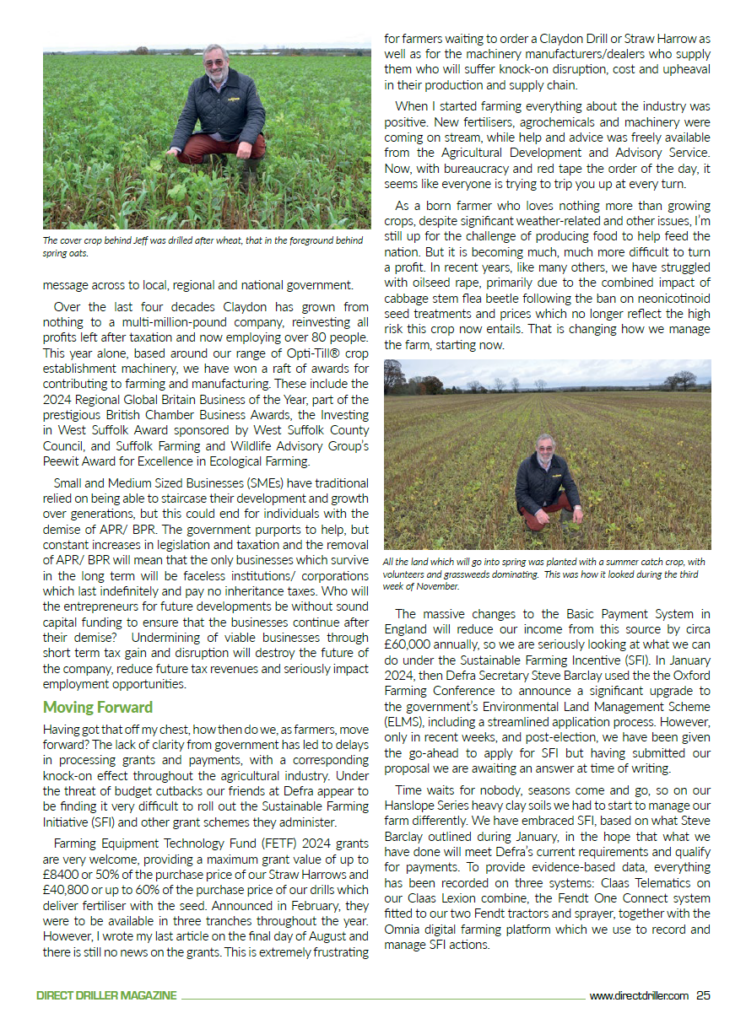

-
TFF Direct Drill Demo day 2025

10 years ago now in the early days of TFF we ran a trial here on my farm for some of the direct drills that were available at that time. The thread that blogged that can be founds here ……….. the result was interesting !
Since then the direct drill market has changed significantly and a lot more farmers are direct drilling, some of the drills at that original event have evolved and there are a lot of new models and even manufactures so we have decided to do it again in on the same block of land this spring
So on Tuesday 15th April we are aiming to have 10-12 drills (most already confirmed ) running into a AHL2 (over winter bird seed) that was waist height going into winter so this should be a proper test of these brands rather than the usual boring demo of them working into stubbles !
We will have a few toppers and crimpers here as well hopefully.
Like last time we are unable to cope with large numbers so anyone wishing to attend will be on a strictly limited basis (all Direct Driller readers are obviously invited) – first come first served probably 100-150 maximum so if you would like to come please register via the link below ASAP to avoid disappointment.Please join us on Tuesday 15th April 2025 from 10am to 3pm to see different drills working in 10 acre plots of knee high AHL2 over winter bird food mix.
Confirmed drills attending
Each drill will have at least 10 acres to work in. You will have the chance to see:
- Horsch
- Fentech
- Vaderstad
- Amazone
- Claydon
- Horizon
Plus others we are waiting to confirm
Register for the event here on Eventbrite for free:
https://www.eventbrite.co.uk/e/tffs-direct-drill-day-tickets-1216355244279
Video of the field of field we will be drilling into: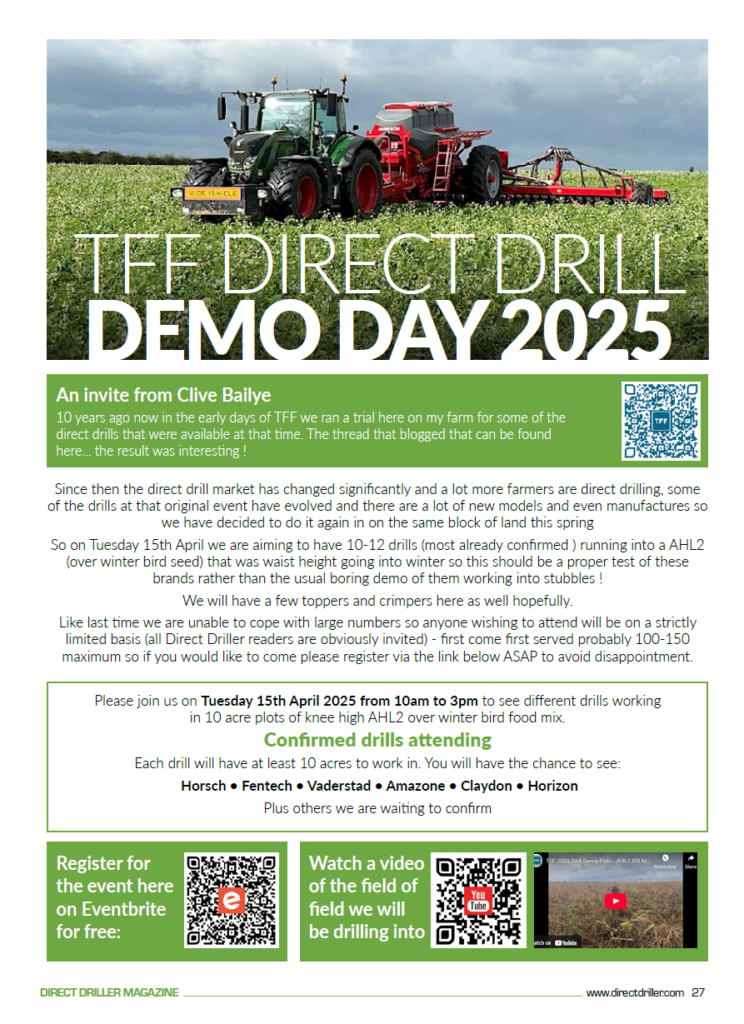
-

Agroforestry options
Dr David Cutress: IBERS, Aberystwyth University.
- Agroforestry is receiving a lot of focus for its role in achieving net-zero globally
- Agroforestry offers multiple integration options but it is important to consider what trees to grow where in combination with what livestock/crop
- Strategies like mixed-species stands and the incorporation of nitrogen-fixing trees appear to add extra benefits to overall system sustainability and resilience to risk
Agroforestry
To begin with, let’s ensure that we are all considering the same concept when discussing agroforestry as its definition can either be highly specific (as is the case in scientific literature) or it can be expansively broad (often in media and political communications). A recent review highlighted that the term agroforestry can be used in different ways which it referred to as ‘the good’ (true agroforestry), ‘the bad’ (agrobizforestry,) which focused on equity rather than environmental benefits and ‘the ugly’ (agrodeforestry), where the term agroforestry is used as a tool to legitimately allow deforestation, degradation and change of current primary or seminatural forests. At its core agroforestry involves the combination of woody vegetation (trees/hedges etc) at the same time as crops and/or animals within the same landscape. As
such agroforestry falls within the category of mixed farming. Terminology within agroforestry includes;Traditional agroforestry – Long-established woody crops alongside livestock or crop components to produce food
Innovative agroforestry – Multifunctional systems combining food and non-food biomass (bioenergy for example) and balancing resources alongside environmental conservation
Silvopastoral/Silvopasture – The integration of trees with livestock grazing
Silvoarable – The integration of trees with arable crop growth
Agrosilvopastoral – The integration of mixed farming crops/livestock with trees
Riparian buffers – Specific use of vegetation (usually woody) in proximity to waterways
Hedgerows – Barriers made of closely aligned trees or shrubs usually for physical separation or to mark ownership boundaries
Shelterbelts – Barriers made of trees and shrubs to protect crops or livestock from environmental factors like high winds and to reduce erosionMany of the benefits of agroforestry have been discussed in a previous article but, in short, these include the impact on sustainability, biodiversity, climate change and soil health. For example, agroforestry is suggested to reduce soil erosion and help balance the available nitrogen and phosphorous in soils to the value of £4 – £15 per ha per year in the UK with silvoarable compared to arable alone (if even half of the current cropable area could be converted to silvoarable that would lead to UK savings of around £24 – £91 million a year).
Agroforestry is at the forefront of discussions about being a low-risk, low-investment, high carbon sequestering land management practice and has several other ecosystem service benefits as noted in the diagram.

Taken from Lawson, Dupraz and Watte, (2019) The ecosystem services of agroforestry – NTFPs = Non-timber forest products, LER = Land equivalent ratio GHG = Greenhouse gas This article aims to explore some of the options available across agroforestry systems and the research on how these perform. The soil associations handbook on agroforestry offers a lot more advice for individuals considering agroforestry including this useful acronym to help
with how to approach these systems – PAMASAL- Purpose: Where do you want to get to?
- Advice: Where will you get advice and support?
- Measures of success: How will you measure efficiency, effectiveness and impact?
- Agroecology: How will you capitalise on agroecology / let nature do some of the work?
- Starting points: Where do you want to start from? (pasture, arable or an orchard etc)
- Adaptive management: As things develop, what tools will help you to adapt?
- Layout: What varieties/species, spatial arrangement and sequencing will you use?
Tree considerations
Different tree species have different functions and considerations for best growth conditions within agroforestry with some being quick growing, some slow growing, some producing fodder or alternative revenue food source and others being more compatible for renewable energy production. A general rule of thumb is to plant at 100 stems per hectare as higher numbers could reduce benefits. Though different species in different environments may function best at higher or lower numbers. The table below presents some broadleaf species researched in Europe and their general functionality.

Generally, conifer species’ functional use in agroforestry is their sheltered environment for livestock outwintering, frost protection of any understorey forage and their long-term timber production (generally 40-60-year rotations depending on species). Specific information on which conifer and broadleaf species can work in which environments can also be found online from the Scottish Farm Advisory Service (FAS).
Mixed-species stands are reported to offer benefits to ecology as they are associated with a broader array of interacting species, they also act to fill and create different niches within an ecosystem distributing resources more efficiently. Mixed species systems also have benefits to resilience as they ensure events such as pests and pathogens do not eliminate all of a system in one fell swoop, though species choice is important here to avoid creating conditions that increase disease outbreak risk.
Further to these benefits, there are suggested disadvantages of utilising monoculture stands such as reduced soil productivity and fertility,
impacts on how water is utilised within systems and higher risks of loss to events such as storms and fires. Whilst the potentials of these systems are well noted the actual instructions and design guidance available for what species to combine successfully are somewhat limited
and need further research.Increasing interest has been seen in tree species with the ability to fix nitrogen toward improving soil nutrients and thus improving growth and biomass. In some studies, the production increase of these trees, mixed into stands of other species, has been as high as 27%. These include species such as alder, Scottish laburnum and acacias, with nitrogen fixation strategies suggested to work best on lower productive lands and in temperate conditions.
What should be avoided across agroforestry as a whole is introducing non-native exotic species, as whilst on paper they can technically enhance biodiversity, there is much suggestion that they do so at the cost of shifting ecosystems from what works for the native environment.
Silvoarable considerations
Alley cropping arable fields with fruit trees can lead to increased farm income following initial (>7 years) negative cash-flows, with the carbon sequestration achieved being demonstrated to mitigate between 47-88% of these cash-flow costs incurred. This suggests that fruit trees can be beneficial due to their co-production benefits particularly if systems carefully consider which trees will yield well on the specific land in question and achieve good sales prices.
Furthermore, alley cropping of trees is an easy way to ensure that machinery can still operate within these alleys and can reduce the complexity of the needs for labour and bespoke machinery. Other integrated forms of planting include the incorporation of lower bushes/shrubs like blackcurrants and raspberries around the edges of the field where they can benefit from the light and provide different shelter considerations.
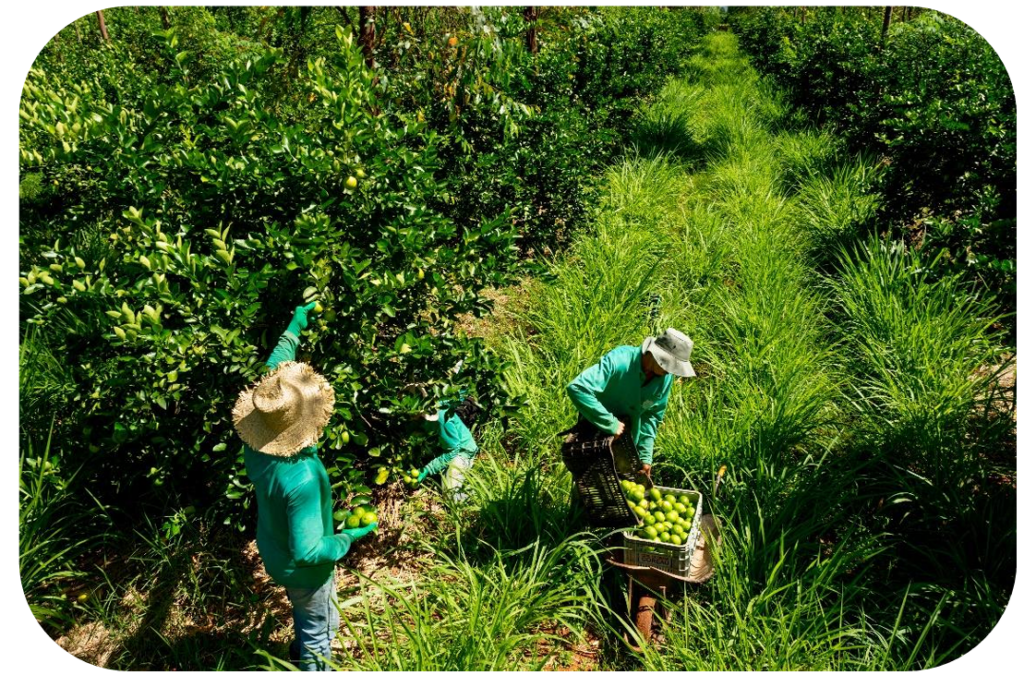
Some studies suggest that silvoarable systems benefit crops where the leaf of the crop is the “economic part” as in a shaded region of trees these plants will naturally allocate more biomass to leaves over roots to capture as much of the available light as possible.
Selecting arable and tree crops with complementary harvesting times can spread the labour and risk of difficult harvesting season windows for example later ripening apple varieties work well with cereals as the cereals can be harvested first. Some intercropped plants even have
the potential to be used for pest management and additional production yields. For example, aromatic plants including basil have been shown to reduce aphid populations and also improve N release in soils available when intercropped with apple treesSilvopastoral considerations
Whilst canopy coverage in silvopasture systems can lower the peak pasture growth rates in key production periods it has been demonstrated to make up for this by protecting growth during normally less favourable cold periods. Silvopastoral systems have also been shown to play interesting roles with regard to drought conditions, where tree species perform more favourably regarding moisture stress than equivalent forests and can reduce water loss from the soil systems and swards caused by evapotranspiration. These benefits to water stress in droughts are also bolstered in agroforestry systems as these are known to improve water penetration into soils and plant roots tend to gather nutrients and water lower down than grasses reducing direct competition.
These features make year-round outdoor systems with lower stocking values more feasible. These would have added ecosystem benefits, to vitally important dung beetles for example, and have the potential to save costs and emissions associated with indoor housing and supplemental feed.

Figure Taken from Jose, Walter and Kumar (2019) Using pigs to forage woodlands has been a traditional practice of old as they can make use of multiple sources of nutrition including acorns (oak trees), and masts from beech trees all of which can reduce the feed requirements and boosts animal welfare. Pigs also work well with
fast-growing bioenergy crops (like miscanthus, willow and poplar) which are known to be efficient in taking up nitrogen, this is important as pigs, due to their excretory behaviour, are associated with producing high N hotspots where grazing. Though consideration and control
of stocking density were shown to be of high importance for efficient systems.Results from a section of the AGFORWARD project suggested that when utilising agropastoral systems site-specific grazing regimes could increase soil seedbanks and species richness of the pasture understorey compared to strategies that excluded grazing. Specifically, it could boost nitrogen-fixing legume fractions in swards. It was also noted that certain trees provide higher digestibility fodder options with ash leaves showing increased digestibility compared to grass. When considering leaves for fodder options it is important to consider management practices to either allow direct browsing (low hanging branches) or to give animals access to
graze branches following coppicing via strategies like pollarding.Alternatively preserving materials from incorporated fodder trees is another option via drying, silage and pelleting, with different species having different processing considerations and edible regions. Such strategies can be important for sustaining livestock in periods of critical grass shortage such as seasonal droughts. But it is heavily noted that research on specific digestibility and preserving methodologies of tree products are lacking and would need further research and optimisation.
Much study has been performed on the benefit of free-range systems and specifically wooded systems for poultry production. One of the benefits that were found by increasing the cover of woody areas in free range systems was it reduced the presence/interaction of poultry with
‘high risk’ avian influenza carrier bird species. This presents an interesting biological disease control consideration alongside the other welfare and natural fertilisation benefits noted with such systems.Though practically in such systems it is important to prune lower branches and allow sufficient light to encourage hen laying behaviours with enough shade to benefit naturalistic behaviours for positive animal welfare. Importantly, however, the selection of animals may change your consideration of tree planting as many animals will trample, graze or otherwise damage young trees. In several systems, this can involve the need to plant nurse species which improve the survival of the target tree species during initial growth.
Despite these detriments, tree incorporation improves soil structures and thus can mitigate compaction issues that might otherwise occur from livestock use. Ammonia dust and other air pollutants are other big factors of interest in livestock production. Here again, tree incorporation has been shown to benefit as trees are effective scavengers of air pollutants and calculators exist to help farmers to model which trees work most effectively in different conditions and different distances from animal housing.
In general, incorporating some form of fodder production from trees within silvopastoral systems gives a diversified feed option on a farm that if performed optimally can reduce feed costs and can have increasing importance in seasons of difficult pasture growth or where imported feed costs increase.
So, what does it mean?
Agroforestry systems can provide many ecosystem service gains and ultimately over longer periods are frequently suggested to provide increased income over treeless equivalents. This means that farmers may need to be willing to play the long game and think carefully about what species of trees will grow best and provide the best sequestration vs productive economic harvest benefits. Mixed strategies show promise, for example, starting systems as silvoarable when younger trees block less light impacting the crop minimally. Following tree growth systems can convert to silvopastoral once crop yield reduction due to tree size and shade occur and loss in crop revenue can be at least partially mitigated by livestock production gains.
It has been suggested that the following strategies could flourish in the UK with the right legislation and support. Such options are also able to be combined into even more complex systems;
1) Silvoarable with mixed grains (to mitigate pest and disease risks to mono-grains) along with nitrogen-fixing trees to reduce synthetic N requirements and other nutrition from tree species such as nuts (to capture non-meat-eating markets)
2) Silvopastoral to improve animal welfare with trees producing fodder supplements to lower production costs
3) Orchard intercropping (no spray) systems to produce food alongside nutraceuticals
4) ‘Agrenforestry’ which would produce bio-renewable energy alongside food on land to prevent the conflict between these two resources – can also incorporate waste food into the renewable energy production alongside the woody biomassNote – many studies suggest specific subsidies are needed to mitigate the economic losses
associated with tree processing for energy in Agrenforestry systems.There are, however, problematic considerations involved in transitioning to agroforestry. Firstly, the mindset for modern agriculture and forestry has very much been that of monocultures, as these are easier to predict growing trends rather than modelling complex mixed species systems, intercrops and systems combining trees and crops/livestock.
Combining this with the fact that there is a lack of evidence surrounding the financial costs, risks and benefits associated with transitioning and the low levels of transition becomes apparent. Some studies have highlighted that agroforestry systems can reduce crop yields and increase weed impacts and many use these findings as a key negative focus in transitioning and management. This negativity was also raised in the recent UK ELM agroforestry assessment which suggested an underlying consideration from farmers that agroforestry is always more detrimental than beneficial to farm operations.
Long-term land tenure is another issue that can impact the uptake of agroforestry as often systems require time to develop. Considering more than 35% of UK farmland operates on a tenancy basis this could be a big factor to overcome and may push more farmers into the shorter turnaround systems. If farmers in such systems were to consider agroforestry at all they will be more likely to favour fast-growing biomass and timber options, which may not have as good prospects for long-term C sequestration.
Summary
In the UK it appears as though there is an understanding that agroforestry is an important future land management tool for land sharing purposes and environmental and biodiversity benefits amongst others. Whilst this understanding is clear it is also clear that newly proposed
schemes such as the Sustainable Farming Scheme in Wales and ELM in England, will need to consider grants to incentivise correct integration of agroforestry and importantly provide resources to guide and train landowners and farmers in an area in which they may have little to no current experience. Whilst almost all agroforestry systems will benefit biodiversity and environmental factors, finding those which work well economically on a case-by-case basis will be key to the successful future of this strategy. Research suggests that this is possible but
may require a re-examination of land system strategies and priorities.

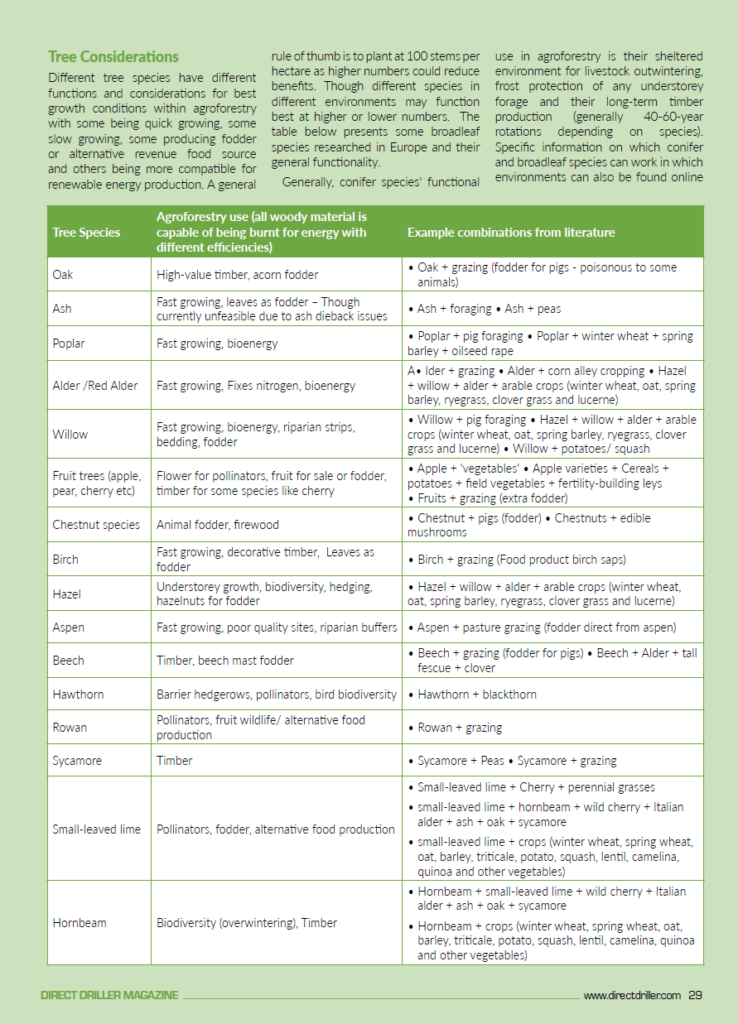
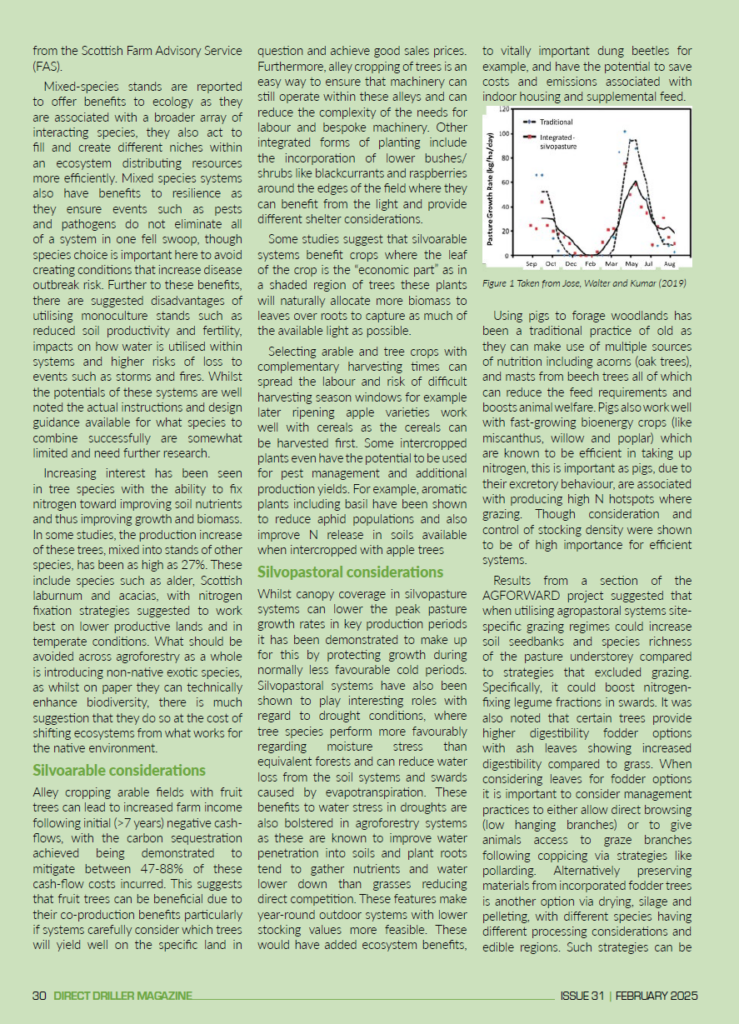
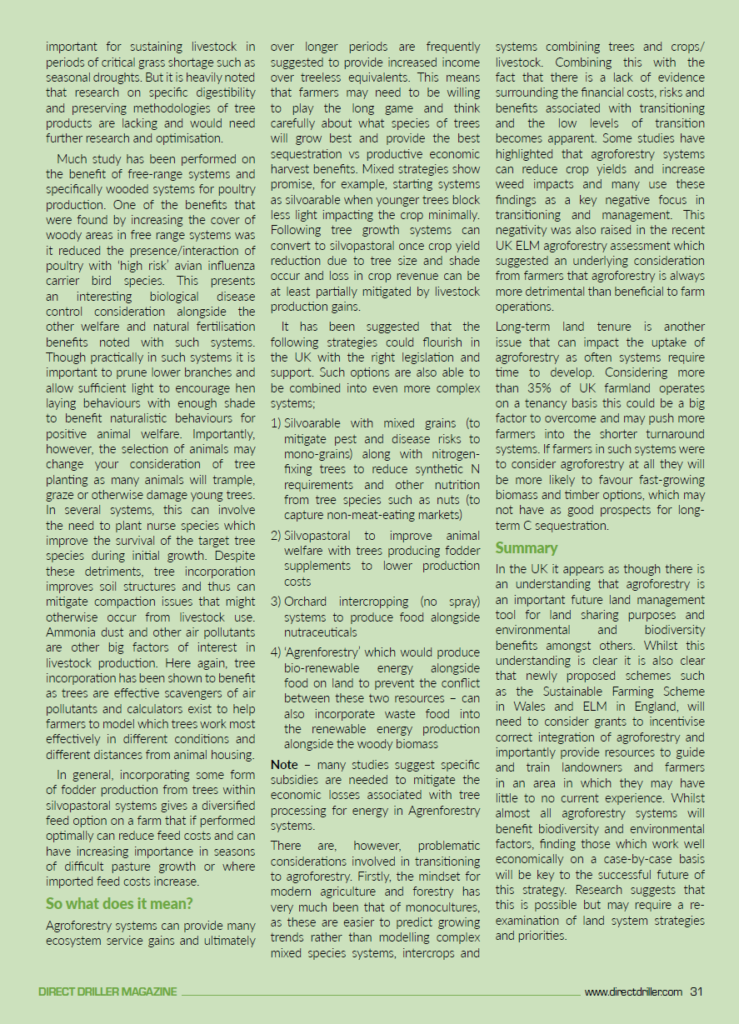
-
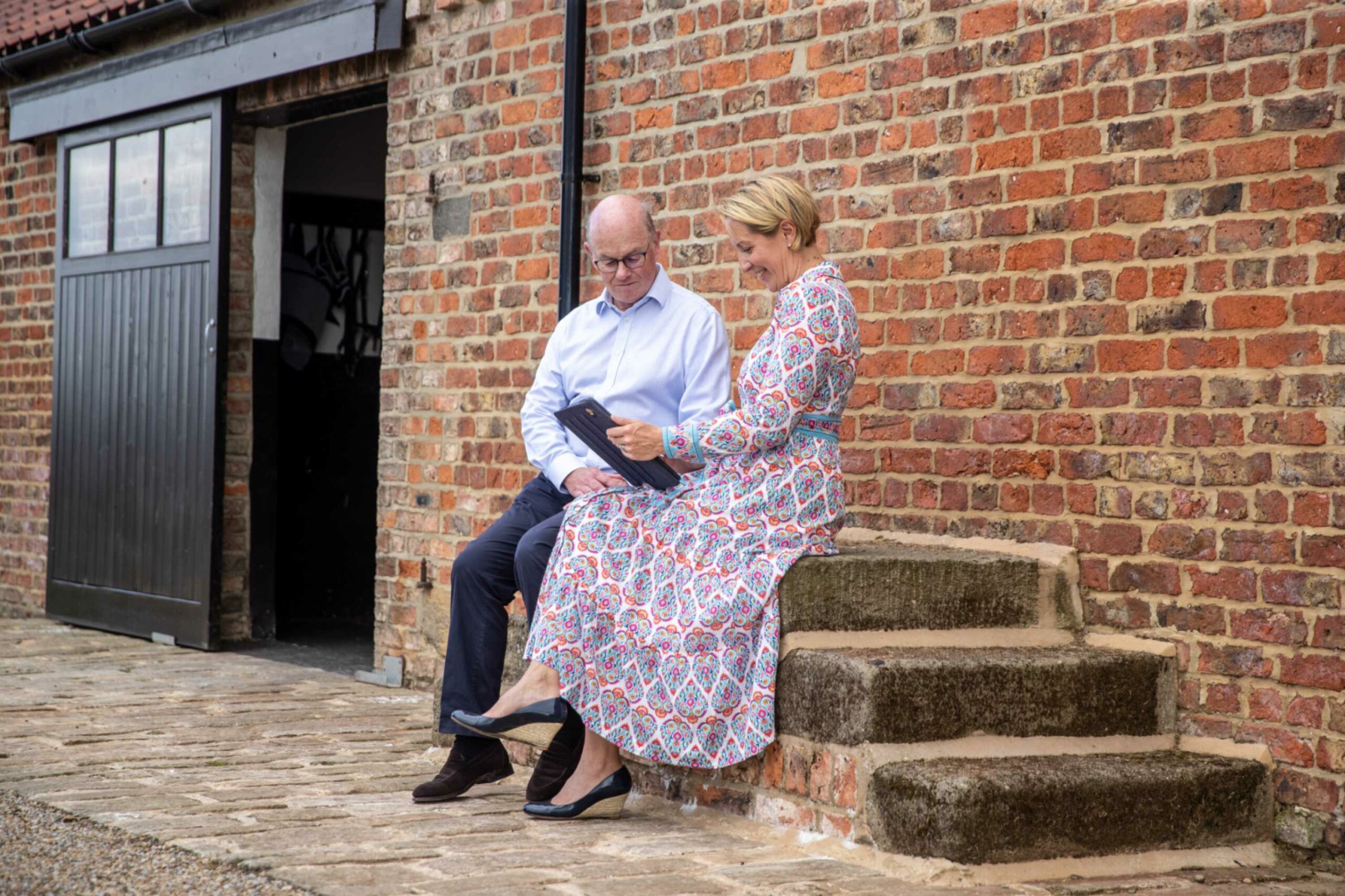
The top five things to do this winter
To aid landowners and farmers with their 2025 planning, Knight Frank’s Andrew Martin and Mark Topliff have developed a list of the top five tasks to tick off this winter.
The last few months have seen vast developments in the political landscape of the rural sector and 2024 might go down as one of the more memorable years in terms of policy changes.
Notwithstanding the policy changes and the subsequent impacts, most of which are yet to be seen, the winter period has always been a good time to do some analysis on the past year and objective and budget setting for the year ahead.
Financial Forecasts
This year, amidst the evolving changes to funding and policy, it seems even more imperative to undertake basic financial forecasts to review cashflow position, project aspirations, and capital or equity available in rural businesses.
In England, Basic Payments Scheme (BPS) will be withdrawn completely by 2027 under current plans.
In the short term, farming businesses will see significant profit gaps due to the rapid reduction of BPS payments, the new carbon taxes on imported fertiliser, and an increase in employers’ National Insurance contributions.
Now is a good time to take a step back, evaluate business performance to find out what is and isn’t working on the farm. Monitor and research what the alternative options are in mitigating this loss in profit.
Andrew Martin, Agri Business Consultant explains: “Get to understand your enterprise margins. If you can, in a spatial way field by field, around your farm. You can then make informed decisions about alternative crops or environmental schemes for areas that are not performing.”
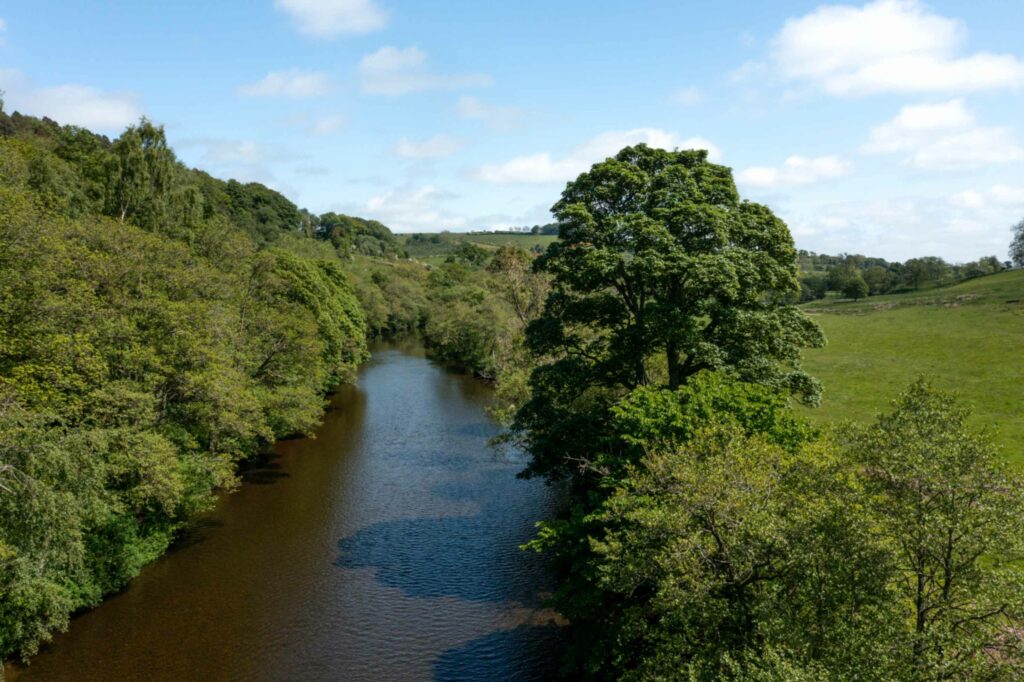
Explore Resources
It is also important to explore all available resources – natural capital market opportunities are often overlooked.
Mark Topliff, Associate and Natural Capital Specialist, emphasises that “natural capital opportunities should be top of the agenda. Any landowner can access them, but which is most suitable will depend on their location and resources. These opportunities range from carbon credits and nutrient neutrality to biodiversity units.
It is important to fully understand a business and its strategy to ensure any natural capital agreement entered into dovetails its operation, but we see these markets as potential opportunities and a way of future-proofing rural businesses by mitigating the loss of BPS income while also delivering for nature.”
Work with your advisors
Following the announcement of changes to Agricultural Property Relief (APR) and Business Property Relief (BPR), make it a priority to bring in trusted advisors early.
Andrew said “bringing in independent specialists allows the conversation to be mediated and facilitated in a manner that gives everyone a voice. These discussions are useful not only in succession planning but also in formalising areas of responsibility, which can provide clarity moving forward.”
Connect with others
The winter period can be a time of prolonged isolation with fewer social activities to attend. Try and get out to one event to connect with others; they are often good learning experiences that allow those attending to see different perspectives and can be useful when setting business aims and objectives for the year ahead.
Look after yourself
It’s of equal importance for farmers and land managers to look after their own health and wellbeing as it is to carry out business health checks. Take time to enjoy the rural environment and set personal objectives for the year ahead on the ways to maintain or improve wellbeing.
Next steps
If you would like to speak to Andrew and Mark, they can be contacted at andrew.martin@knightfrank.com and mark.topliff@knightfrank.com. Further insight and case studies on sustainable farming, natural capital, environmental schemes and legislation can be found in The Rural Report Autumn Winter Edition 2024/25 and on Knight Frank Rural website at www.knightfrank.com/rural-matters

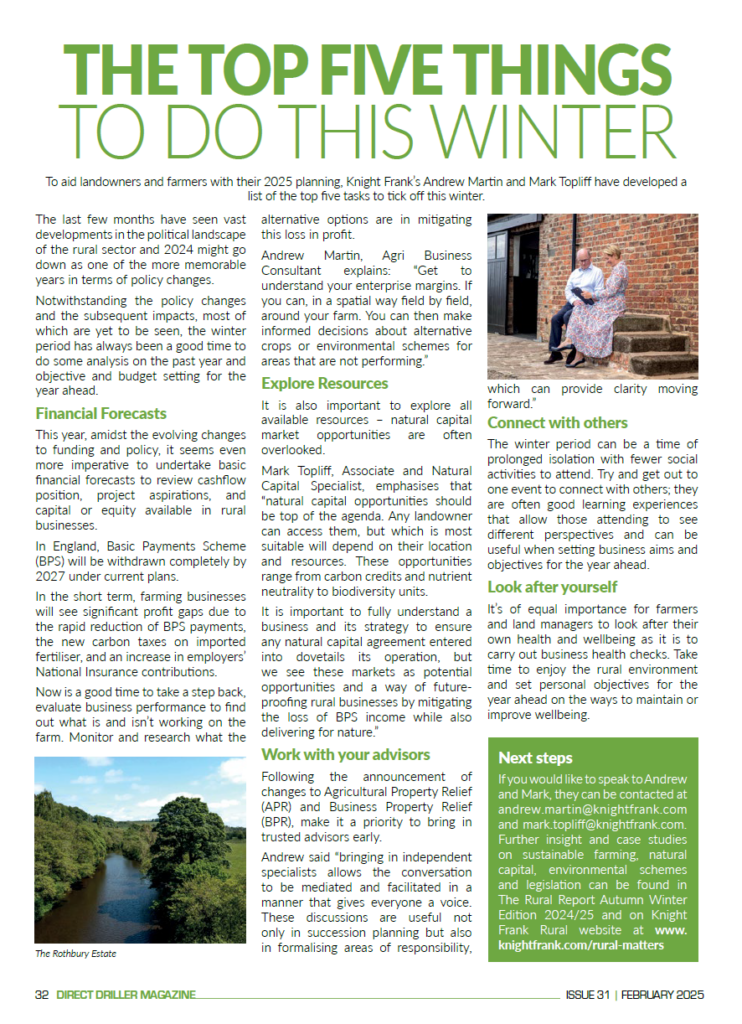
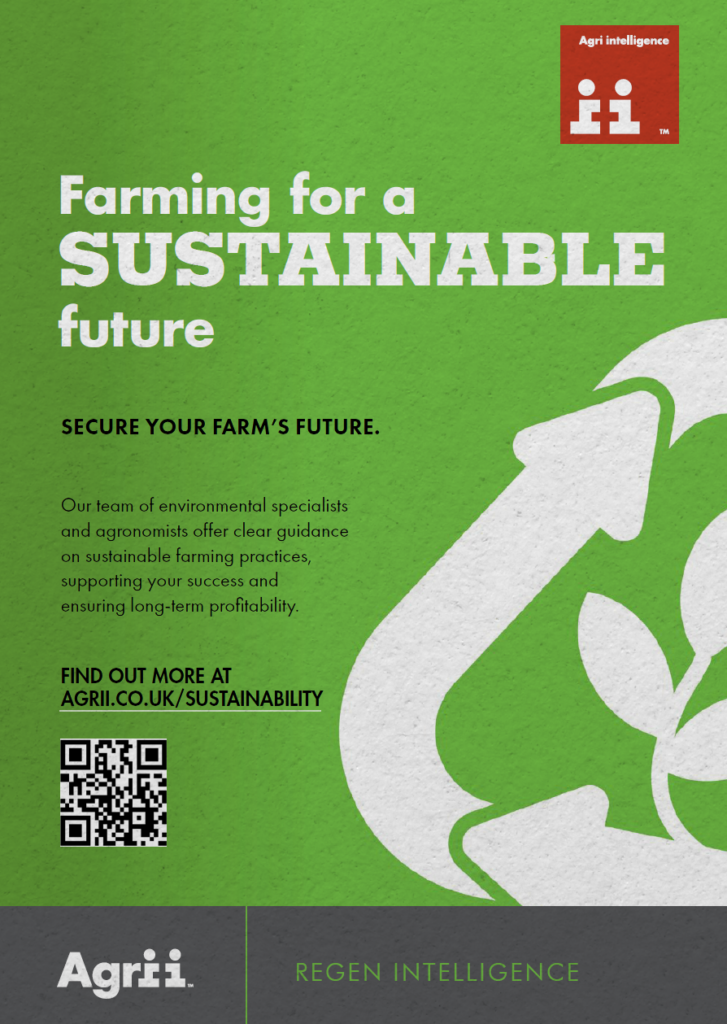
-

Farmer Focus – Tim Parton
Another year, another set of problems?
I can only feel at the time of writing that we are getting kicked yet again with what I can only describe as the worst budget I have ever seen in my life! Aside from what they are doing to farming; what on earth are they doing to the whole UK economy? I can only see inflation going up along with unemployment. Growth will grind to a halt. Where does the government think growth and wealth comes from? Certainly not from within! I can see the effects of this budget lasting for decades to come! Basically, we need growth of all industries to move forward and to have a thriving economy. With agriculture being a primary industry and integral for all other industries, wouldn’t you think that the politicians would want to get the foundations right first? After the mistakes that were made over 100 years ago about food security, have the government learnt nothing? Obviously not. Do they sincerely comprehend where their food comes from? Rant over. Back to farming.
All crops have been drilled here. Thanks again to Micheal Kavanagh for helping out whilst I am continuing my rehabilitation. It does seem to go on and on; at the same time, getting kicked and punched from so many directions along the way! Yet on the flip side, I have had so many messages of support from around the world, of which I will always be grateful and humbled.
It has been another tough autumn but one that once again shows the benefits of getting one’s soil functioning and in order. The last time I did an infiltration test I was down to thirty seconds per inch. Where I started all those years ago it was taking six and a half minutes. You can see how my soil has improved. I always like to prove to myself what is working and what is not, or needs amending, and this year my soil came into its own, allowing us to travel and get seeds into the ground in good conditions, where others could not travel. In my experience this has always been half the battle of having the patience to only go drilling when the conditions are right. I just cannot see the point of mauling seed into the ground, knowing full well that you are likely to have half a crop which will lose you money long term in more ways than one; since, more than likely you will have compaction issues moving forward, which will have to be resolved in order to keep profitable.
All seeds are drilled with my biological seed drench, along with nutrition, humates and wood vinegar. As I explained in my last article, wood vinegar has so much to give, which I go into in a lot more detail on my website at timpartonfarming.com All wheat is companion cropped with beans, or clover, or both, depending on the field. We all should be fully aware that nature never grows monocrops, so why on earth would we? When we can now get paid for planting a companion crop through SFI, why would you ever think of planting without when there are so many benefits to be had, from fixing nitrogen, sharing nutrients, water and keeping ground covered to suppress anything else germinating, the right combination just keeps on giving and we get paid for the privilege (government allowing)?
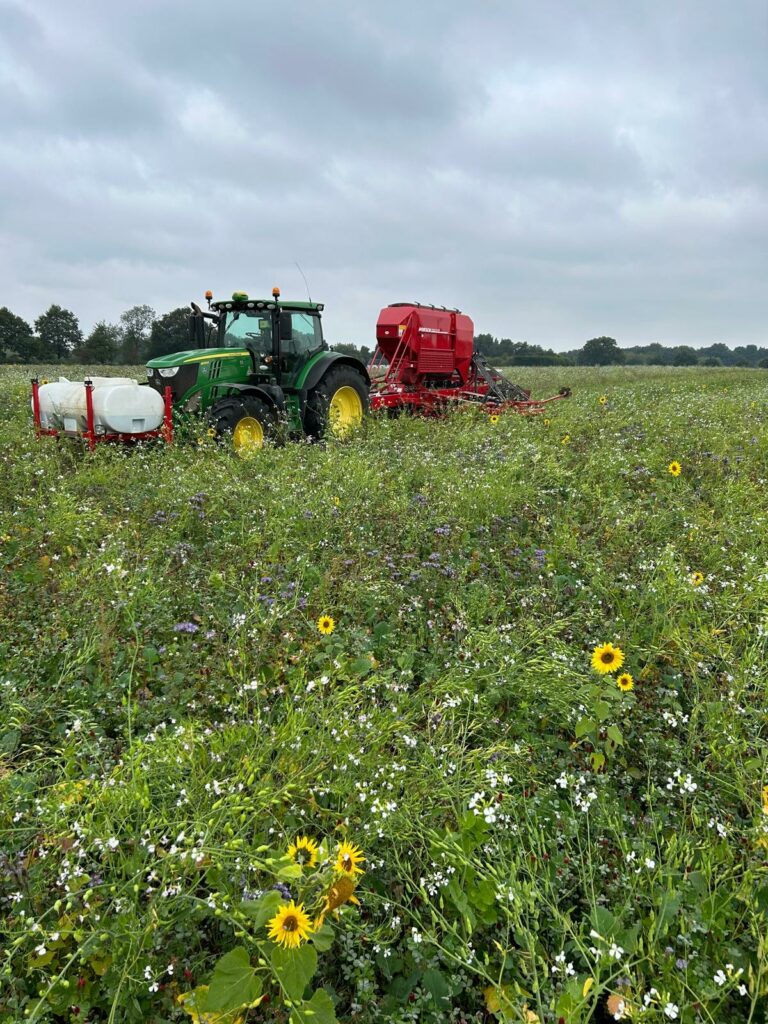
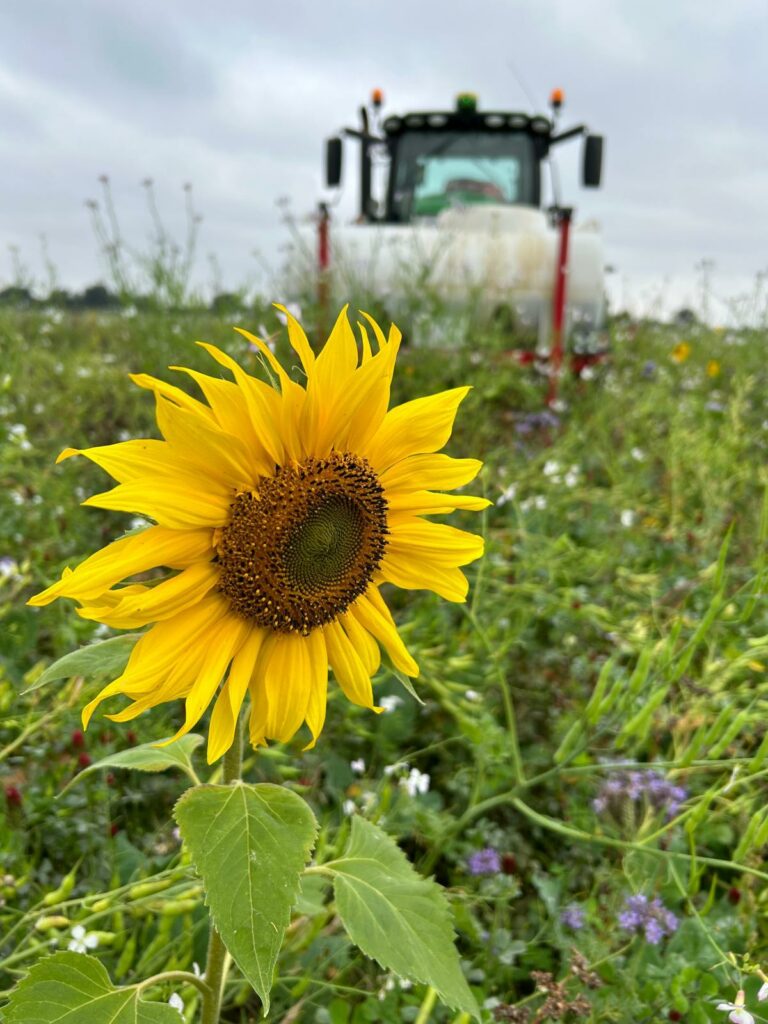
I know, from being lucky enough to speak around the world, we UK farmers are very much envied on the help we are offered to improve our own soils and don’t we just need that help in today’s climate of inclement weather and wheat gushing into the country pushing our prices ever lower! If you had money to invest, the return agriculture gives certainly would not inspire to invest now, would it? But has the government gone far enough to want to stop corporate investors from investing in agriculture? I think not, they have just got it wrong yet again! Back to farming, I promise!
The Green Farm Collective (GFC) board has been working hard to find the right reward for our members, selling certified regenerative wheat into the baking industry and will be gaining momentum this year, if all goes to plan. One thing that we are all passionate about is that we want to be as transparent as possible, ensuring that we cannot be accused of green washing. This is something that must always be exposed, in my opinion, as we need to get full public support behind the movement of regenerative agriculture so they can regenerate themselves along the way and be part of the journey. Having a healthy body and living in a healthy environment – every person has the right to these basic needs; the right to know how their food has been produced and know exactly what they are eating. It is up to us all to demand a higher price for this nutrient rich product and not let it be diluted into conventional stores for a conventional price, as its worth so much more.
The other big thing is that it’s so important to keep control of the carbon sequestered on farm, as this belongs to farm and should be marketed separately, in my opinion along with natural capitol. They should not be allowed to be amalgamated in with produce, as once we allow that to happen, we will never get the benefits in financial gain and don’t we need every avenue of income at the moment? We all need to come together on this one whoever you decide to trade with, but at GFC we will be able to get you a good price on all three moving forward.
The other one that has saddened me this year is the introduction of gene editing (GE), which is not too dissimilar to genetic modification (GM). I am old enough (only just) to remember when GM crops were being introduced into the States, with all the claims of how farmers were going to make more money, better for the environment, blah blah. When in reality they have just been a disaster for the environment and there is plenty of evidence showing a knock-on effect to human health, meaning, for me, there is nothing to like! I can achieve most the claims that are being made for their introduction from just plain nutrition and epigenetics. Epigenetics is one of the main reasons of retaining home saved seed, with the offspring aiming to always be an improved version of their parents. Having the right immune system to go back into the environment, they have become adapted too, but as a very much evolved and therefore improved version.
Once you have let the genie out of the bottle you cannot put it back in and how many times over the years have we been told that products are safe, when in reality they are not? Household budgets spent a third of their income on food in the 1940s with 92-98% of their fruit and vegetables coming from gardens and allotments, meaning everybody had a connection to mother earth, which is so important in my opinion. Present day and we spend 10-12% on food. Some people have had little respect for what goes into their bodies, leading to obesity and other health problems. Surely once they understand the difference nutrient rich food can have on their own health, they would value what they are putting into their bodies and be willing to increase their spend on food? Similarly in industry the foundation to success, health equals wealth, all starting with soil.
I have been out on the talking circuit spreading the word of regenerative agriculture: the first one being at “Land Alive”, which is a new conference, down in Somerset. The conference was well attended and was a real pleasure for me to be speaking, along with Andy Neal (Rothamsted) and Ian Wilkson (Farm-Ed) on the big debate “Glyphosate V Tillage”, which made for a very interesting debate. I have also been speaking down in London, firstly for the under 35s Farmers’ Club chaired by Andrew Court, which was a very enjoyable evening for all those who attended. Then moving on to be part of the panel at “Banking for Change” hosted by Soil Association Exchange, which was addressing the financial barriers to farm transition to regenerative agriculture and was attended by all the major banks who are looking to be a part of helping the transition. The move towards Regen is happening, but not fast enough for me, as the clock is ticking.

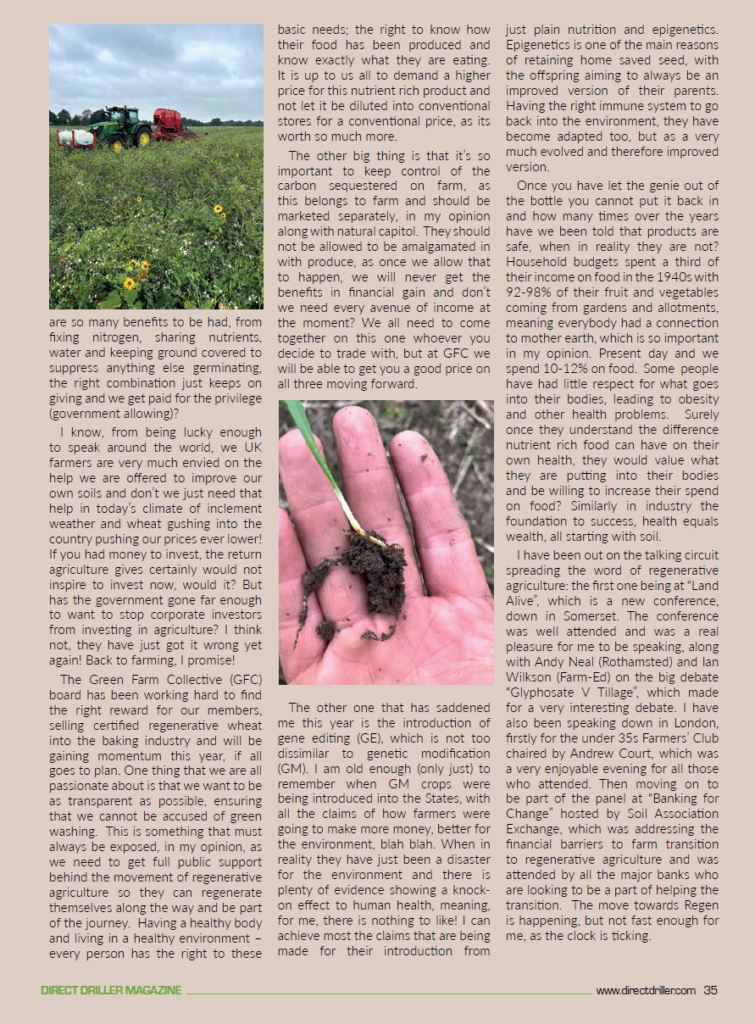
-

Smart phosphorus management to boost yields in depleted soils
WRITTEN BY JOHN HAYWOOD – UNIUM BIOSCIENCE
Standfirst: Environmental conditions play a significant role in determining the availability of phosphorus (P) to plants.
With the challenges of another wet season, and potentially depleted soil reserves, many growers are looking for ways to support winter crops and optimise phosphorus uptake in spring crops.
As an essential macronutrient, phosphorus is crucial for plant energy transfer, root development, and flowering and insufficient phosphorus can lead to decreased yields. However, phosphorus often exists in forms that are not readily accessible to plants, and environmental factors such as soil pH, temperature, moisture, and microbial activity directly influence how much phosphorus plants can absorb.
Factors affecting phosphorus uptake
Soil pH
Soil pH is one of the most critical environmental factors affecting phosphorus availability. In acidic soils (with pH levels below 5.5), phosphorus tends to bind with aluminum and iron, forming insoluble compounds that plants cannot absorb. In contrast, in alkaline soils (with pH levels above 7.5), phosphorus forms insoluble compounds with calcium. The optimal soil pH for phosphorus availability typically lies between 6.0 and 7.0, where phosphorus remains in its most accessible form – orthophosphate.
Farmers often adjust soil pH by applying lime to raise pH or sulfur to lower it, improving phosphorus availability. Without proper pH management, even soils with high phosphorus content can lead to deficiencies, as phosphorus remains locked in forms unavailable to plant roots.
Soil moisture
Soil moisture also has a significant impact on phosphorus availability. In waterlogged or overly saturated soils, oxygen levels decrease, leading to anaerobic conditions that can slow down the release of phosphorus from organic matter. In such environments, phosphorus may also bind with iron, further reducing its availability.
Conversely, in dry soils, the lack of moisture inhibits the movement of phosphorus toward plant roots. Phosphorus is relatively immobile in soil – plants need phosphorus to be dissolved in soil water to absorb it, unlike nitrogen, which can move more freely with water. As a result, drought conditions can lead to phosphorus deficiencies because plants struggle to absorb the nutrient without sufficient water to facilitate its uptake.
Maintaining balanced soil moisture through irrigation and proper drainage helps ensure that phosphorus remains accessible to plants. Cover crops and organic matter can also improve water retention in the soil, indirectly promoting better phosphorus availability.

Temperature
Temperature influences both the chemical reactions in the soil and the biological processes that control phosphorus cycling. At lower temperatures, the microbial activity responsible for breaking down organic matter slows down, reducing the release of phosphorus into the soil. This is especially problematic in colder climates where spring planting begins before the soil warms sufficiently to support microbial decomposition.
In higher temperatures, microbial activity increases, releasing more phosphorus into the soil. However, extremely high temperatures can cause soil to dry out, limiting phosphorus movement toward roots. In regions with fluctuating temperatures, such as temperate climates, phosphorus availability can vary seasonally.

Microbial activity
Soil microorganisms, particularly mycorrhizal fungi, play a key role in phosphorus availability. Mycorrhizal fungi form symbiotic relationships with plant roots, extending their ability to access phosphorus in soil particles. This is particularly important in soils with low phosphorus levels, as the fungi help extract phosphorus from insoluble compounds.
Environmental factors like soil pH, temperature, and moisture all influence microbial populations and activity. In harsh conditions—whether too hot, cold, dry, or wet—microbial activity decreases, limiting phosphorus availability. Managing the soil environment to support healthy microbial populations through the addition of organic matter and minimal tillage practices can enhance phosphorus uptake by plants.
Erosion and soil compaction
Physical conditions such as soil erosion and compaction also impact phosphorus availability. Erosion can strip away the topsoil, where most phosphorus is stored, leading to deficiencies. Compacted soils, on the other hand, reduce root growth and limit the movement of phosphorus toward plant roots. Reducing tillage and implementing erosion control measures, such as planting cover crops and maintaining ground cover, can mitigate these effects.
Supporting your crops in less-than-ideal conditions
Many growers are considering what can be done to give autumn crops a helping hand, given the wet weather of the past season and depleted soil reserves, as well as the potentially compromised establishment of this year’s winter cereals. Phosphate biostimulants are worth considering, providing an alternative and cost-effective option to applying foliar phosphate, which can give inconsistent results.
Calife Extra is a stimulant designed to improve crop rooting and maximise nutrient uptake. It essentially tricks the plant into scavenging and therefore boost its roots and exudates which feed the soil biology.
Working in synergy with this is Luxor which provides an efficient phosphate supply through maximising availability and reducing adsorption in the soil. Because Luxor contains pidolic acid (L-GPA), the overall combination helps a crop to make the most of this availability while increasing nitrogen assimilation.
Ultimately, by adjusting soil pH, maintaining optimal moisture levels, supporting microbial activity, and preventing erosion, farmers can improve phosphorus availability, enhancing crop yields and promoting sustainable soil health.

New phosphorus decision-making tool launched
An easy-to-use online tool allows farmers to assess the phosphorus biological availability in their soils by entering their post code.
Developed by Unium Bioscience, ‘Phosphate Power’ is a free, easy to use online tool that helps farmers assess the phosphorus biological availability in their soils.
A critical nutrient during germination and establishment phases, phosphorus availability can often be limited by various soil and environmental factors. Phosphate Power offers tailored recommendations depending on the phosphate bioavailability in the soil. By using the phosphorus index, based on peer-reviewed data, it informs farmers whether their soils are biologically optimised to provide what the crop needs.
“The new service is simple and practical,” explains John Haywood at Unium Bioscience. “It links environmental conditions such as soil moisture, temperature, soil texture and location to a forecast for the next seven days to help growers with precise, location-specific information. This enables informed decision making on how best to supply crops with phosphorus at a very critical and sensitive time in the plant’s physiology,” he says.
If phosphorus availability is limited, the tool provides advice on appropriate actions, such as the application of seed treatments, foliar phosphorus products, or biostimulants, which encourage root growth to enhance phosphorus absorption from the soil.
“Seed treatments are a sensible choice when you are planting outside optimal conditions to boost establishment and root growth – for planting from October to April,” says John.
“Depending upon your soil P levels, it will help to dictate whether you need to mine reserves – the only way to do this is to push out more roots, more active roots in terms of pushing out more exudates to feed soil biology or by supplying an efficient form of phosphorus – organic or inorganic – based on your soil’s pH, placing it strategically near the root structure, or using effective foliar treatments for optimal uptake,” he says.
This model is the next step to help farmers make informed decisions, question practices or recommendations and to stimulate debate as to how to manage phosphorus uptake better.
One of the key advantages of this tool is its ability to help farmers during the critical early stages of crop development, ensuring that their plants have the necessary nutrients for optimal growth. By leveraging environmental data, Phosphate Power aims to maximise efficiency, leading to healthier crops, improved yields, and reduced input costs.
In trials with Cambridgeshire arable farmer Russ McKenzie, Unium has achieved lower costs and increased yields with its nutrient programme. “We are excited to be able to bring this tool to help growers optimise their yield potential in the same way,” he says.
“It’s designed to help farmers make better decisions about phosphorus management and improve crop yields, while also reducing costs and maximising return on investment,” adds John.
By integrating this tool into their practices, farmers can expect to optimise crop phosphorus uptake and enhance their overall production efficiency.
Phosphate Power will be available to growers nationwide, helping them achieve optimal results through smarter nutrient management.
Farmers can access Phosphate Power by visiting uniumbioscience.com/phosphate-calculator/ where they can quickly input their postcode to receive a detailed analysis of the phosphorus content in their soils.
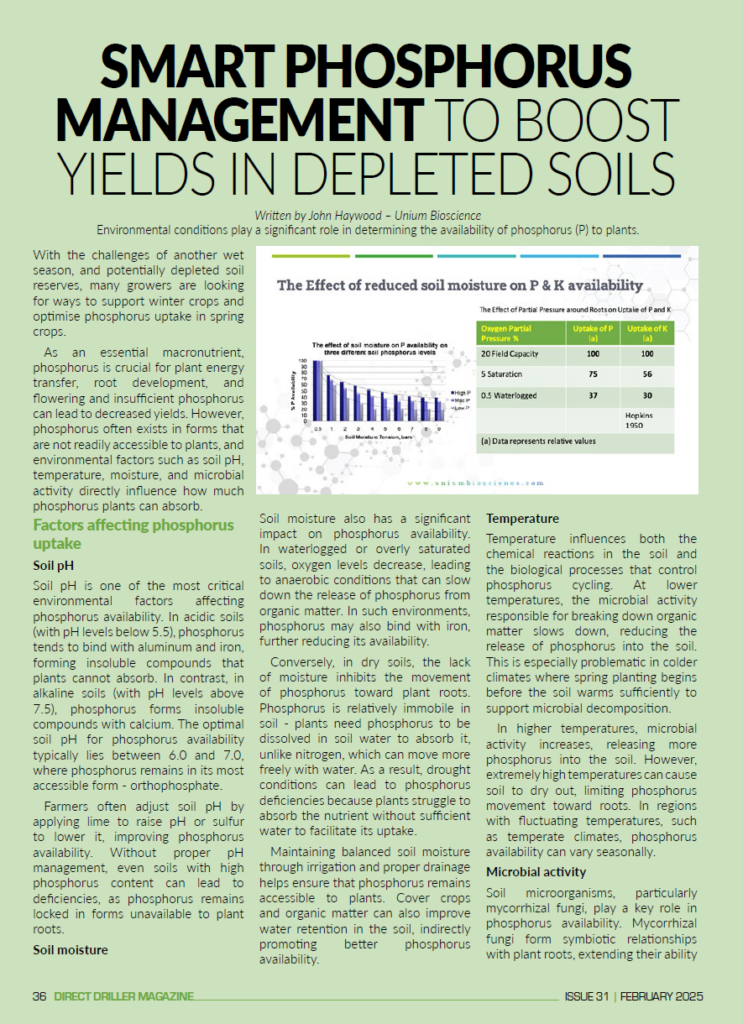
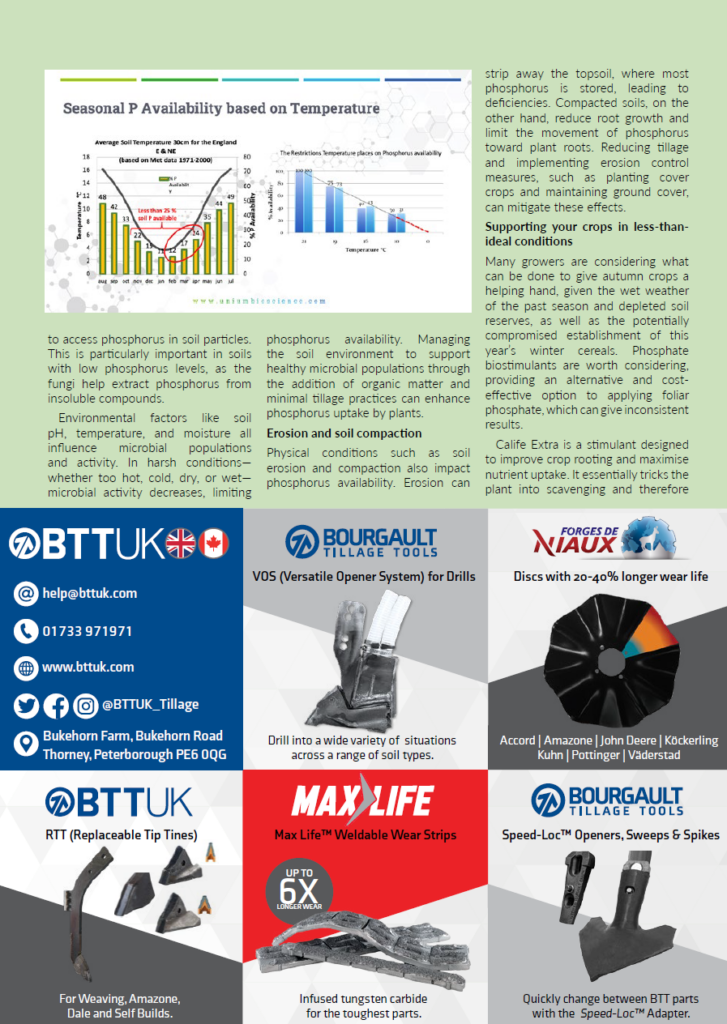
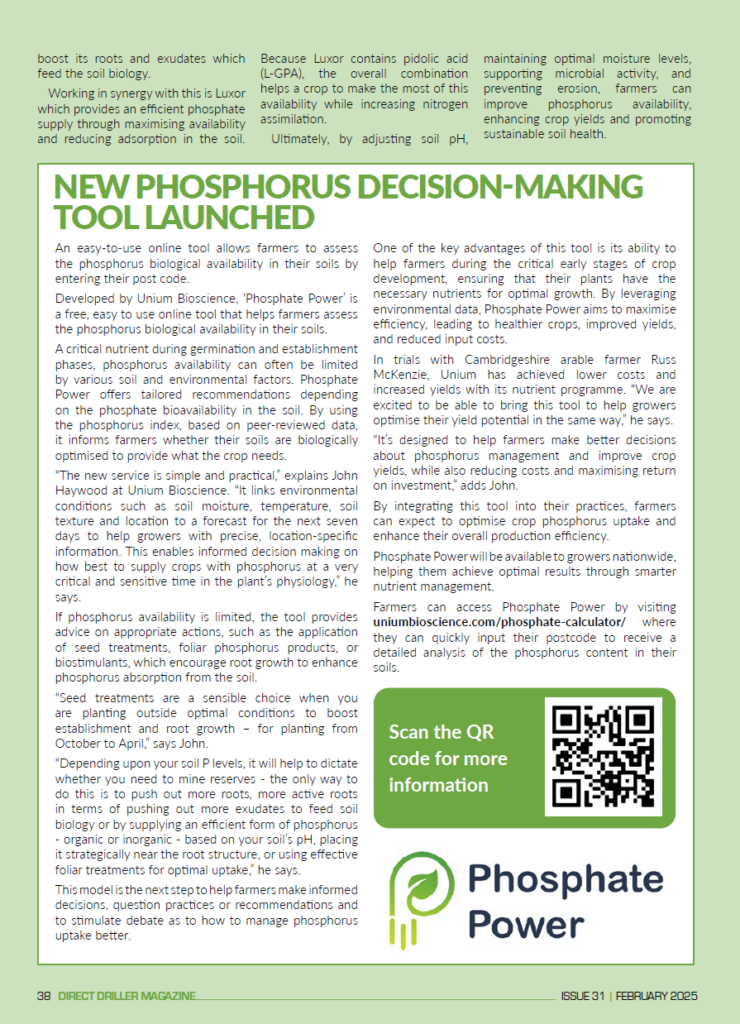

-
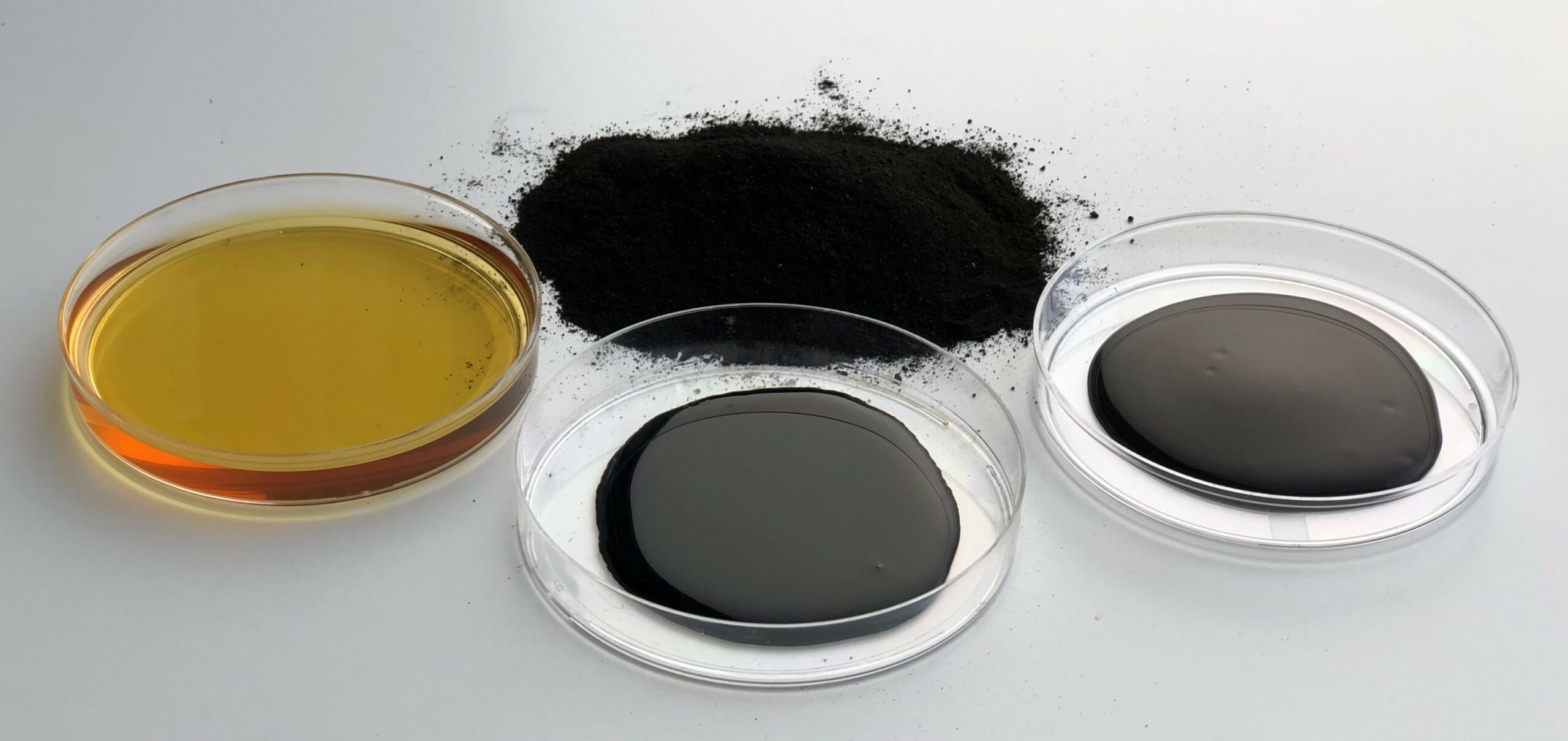
Humic Substances: a background to their classification, properties, origins and uses in Agriculture.
Written by Tim Smales from Humi-Cert.com
Humic substances play a vital role in a healthy soil. We’ll review what humic substances are, their benefits, the various amendments that are available and some examples of how they are used in agriculture. Having an understanding of these substances and their properties is of great use in understanding how they can benefit agriculture.
It is important to understand that there is a difference between soil organic matter and humus. Soil organic matter is defined as carbon containing compounds which have originated from living beings. This is still decomposing at various rates in the soil. Humus is the black/brown substance found in the top layers of soil. It is formed by the physical, chemical and microbiological transformation of biomolecules from the debris of living organisms via a process named humification. Humus is a stable component in the organic matter of the soil and is resistant to further degradation. The term ‘Humic substances’ is used to describe the three organic, carbon based, compounds which make up humus. These substances are humin, humic acid and fulvic acid, which have been separated into groups based on their solubility and physical properties. They exist in abundance in terrestrial and aquatic environments and are rich in oxygen-containing functional groups such as carboxyl, hydroxyl, carbonyl, quinone and methoxy groups 1, giving them their ability to chelate and interact with nutrients.
Humins are large molecules and have thehighest molecular weight of the humic fractions. Humin is not soluble in solutions at any pH and resists movement and leaching in the soil. It is dark brown to black in colour and has a Cation Exchange Capacity (CEC) of approximately 100.
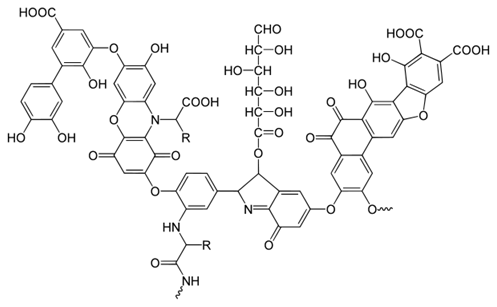
Stevenson, F.J.; Hunus Chemistry: Genesis, Composition, Reactions, John Wiley & Sons, NY, 1994 Humic acid consists of molecules of moderate molecular weight around 10x smaller than humin. It is only soluble in alkaline solutions. It has higher molecular activity than humin and a higher CEC, of approximately 400. Amendments are more commonly added to soil and are resistant to leaching. It is dark brown to black in colour.
Fulvic acid has the lowest molecular weight, around 10x smaller than that of humic acid. It is soluble in solution at all pHs. Fulvic acid has the highest bioactivity levels of the humic fractions, possessing the highest CEC, of over 1000. Its smaller size allows it entry to the plant through the leaves, stem or roots and is able to deliver trace minerals directly into plant cells. Although it is of great value in the soil it is principally used for foliar applications in agriculture. It is leachable through the soil and light yellow to brown in colour 2.
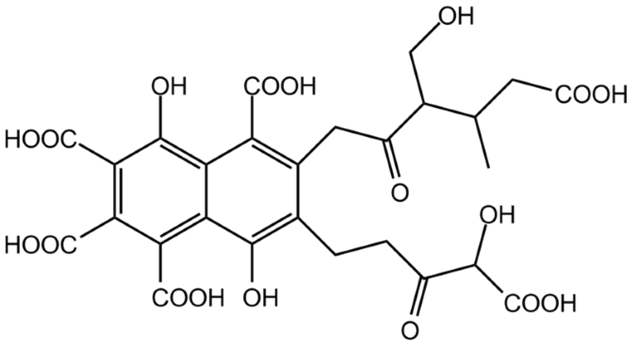
Buffle, J.; Greter, F.C.; Haerdi, W: Measurement of complexation properties of humic acid and fulvic acids in natural waters with lead and copper ion selective electrodes. Anal. Chem. 49, 1977, 216-22 Soil benefits Humic acids are able to increase soil nutrient availability by chelating, retaining plant nutrients (such as NH4+, Mg2+, Ca2+ and Na+) and co-transporting them to plants. Humic substances are able to buffer, retain water, improve aggregation and increase the carbon sequestration of the soil 1.
Microbiology benefits Humic substances are able to directly increase microbiological activity and indirectly influence nitrogen availability by promoting the growth and activity of these soil microorganisms, such as nitrogen fixing bacteria and mycorrhizal fungi3. One interesting study carried out over three years of soil-applied humic acid showed an increase in numbers of fungi considered beneficial to plants whilst numbers in strains considered pathogenic decreased 4.
Plant Benefits Humic substance amendments have been shown to increase crop yields, nitrogen use efficiency and nitrogen uptake 5 . Humic Acid can directly increase nitrogen uptake by stimulating enzyme activity in root cells 3. Increased root growth and mass through auxin-like properties of humic substances is also seen 6. Fulvic acid, in particular, can increase foliar micronutrient uptake and increase the nutritional value of the crop 7. Germination and seedling development can also be improved 2.
Environmental benefits Humic substances have been shown to be excellent fertiliser carriers/stabilisers and research 8 has evidenced reductions in nitrogen leaching and in fertiliser usage. Humic substances can also immobilise organic contaminants and harmful heavy metals in the soil, very useful properties for environmental cleanup 9 , and can reduce the salinity in saline soils as well as inhibiting salt accumulation 10. Humic and fulvic acids were shown to bind to glyphosate (herbicide), cypermethrin (insecticide) and azoxystrobin (fungicide), showing promise to clean contaminated water 11. An additional study evidenced humic acids were able to neutralise the antimicrobial effect of glyphosate 12.

Humic amendments
Firstly, by increasing soil organic matter with regenerative practices there will be an associated humic matter increase which is of huge benefit 13. Compost and manure (aerobic and anaerobic) applications will contain humic matter. Many of the humic amendments available are extracted from ancient mineral deposits, from lake sediments, peats, brown coals and shales. Humic and fulvic acid are contained in these mineral deposits, generally with significantly more humic acid than fulvic acid, and the humin content will vary from one deposit to another. Therefore, mineral sources can vary greatly in humic substance content and the biofunctionality they possess. It is worth noting that deposits will contain a host of micro and macro nutrients in low percentages. Generally humic substances from compost, manure and the soil are at a lower stage of humification, when compared to mineral sources, and their decomposition and biological activity is likely to be faster 14. Mineral sources will generally have a far higher humic substance content and the humic substances will have a greater longevity after application.
As described previously humic acid is soluble in alkaline solutions. Commonly potassium hydroxide is used as a base to extract humic acid from the mineral source and this results in the formation of potassium humate. You might find this marketed as a liquid product or a dehydrated powder/granule. If we stopped processing at this point, we would also have a product which retains the fulvic acid component from the mineral source. This potassium humate product will contain the additional nutrient potassium, from the potassium hydroxide, which is also useful as a crop nutrient. To separate the fulvic and humic acid an acid is added to the solution to reduce the pH. The fulvic acid will remain in solution (soluble at all pHs) and the humic acid will precipitate and drop out of solution (insoluble in acidic solutions). These fractions can then easily be separated. It is now easy to see why this alkaline extracted potassium humate is not compatible with acidic tank mixes, as it will precipitate out and block the sprayer. Generally, humin is only present in small amounts in these mineral sources. It is most often filtered and/or settled out and will not be found in commercial products. Other sources of fulvic and humic acids can be associated with fermented products, the decomposition of organic matter and extraction from water sources. A small number of products in the market, produced with the use of additional proprietary chemistry, contain humic acid that is soluble in acidic tank mixes.
The mineral source can be left chemically unaltered, but mechanically processed; crushed, powdered or micronised. As with many materials, increasing the surface area of a product will dramatically increase its functionality. A powdered raw mineral (or a dispersible granule made with powder) would be the most useful for soil or substrate amendment, when compared to a coarser raw mineral addition. There are also products which contain the micronised mineral in suspension/dispersion. The benefit of these micronised products is that they retain their original pH of 4-5 and will blend with an acidic tank mix with no fear of the product precipitating out in the spray tank. They also retain all the humic substances in the original ratio found in the mineral source: humin, humic and fulvic acid.
There is no universal testing protocol used to establish the humic and fulvic acid content of products. By their very nature they are not standardised molecules, and their size and chemical make-up can vary greatly. This makes accurate analysis very technical and difficult with some analytical methods capable of grossly overestimating the percentage content of a product. Much research was done to establish a more accurate analytical method, resulting in the creation of international standard ISO 19822:2018, which is regarded as the best method currently available. When making a purchase decision based on the content of humic substances it would be wise to establish how the content has been measured and whether it is likely to be accurate.
There is a huge body of research addressing the use of humic substance amendments in agriculture and so there is a great deal of useful information. However, the description of the humic substances is often very vague and rarely contains an accurate humic or fulvic acid content, making it difficult to establish a usage rate. Additional factors of the materials source and its manufacturing process will also affect the functionality of the humic substance. It can be challenging to transfer directly any research findings, where research trials are performed globally, in varying climates, on a variety of crops input with varying humic substance inputs. When applying humic products to the soil it would be wise to do this over several years as results can improve year on year, rather than presuming an application over one season will give a completely representative result.
Some examples of how humic substances can be used in agriculture.
Fulvic acid is widely used for foliar applications to increase nutrient uptake and use efficiency. It is a popular addition to foliar fertiliser blends and has also been used to increase the efficiency of foliar applications of glyphosate.
Urea and humic acid have become widely used together, particularly on pasture where increases in yield, efficiency and nitrogen losses have been recorded using solid products 15. Increased nitrogen efficiency was also evident in a study using foliar applied urea and humic acid on pasture 16.
Applying humic acid with phosphate applications has been shown to increase the fertiliser efficiency and improve yield 17,18.
Humic acid was shown to reduce nitrate leaching and ammonia volatilisation whilst increasing yields in a lucerne crop fertilised with dairy slurry 19.
Humic acid has been shown to work in synergy with seaweed applications in increasing yield 20.
A small humic acid addition is popular with anyone brewing compost teas and has been shown to have a synergistic effect when applied with plant growth promoting bacteria applications 21.
Too much of a good thing? – It is possible to over apply, and an over application can potentially lead to nutrient tie up due to the potent chelation effect of humic substances 22.
I hope this short review has provided some useful insight into humic substances and how they can be applied in an agricultural setting. I also hope you have gained some additional working knowledge when purchasing humic amendments, knowing what fractions you are buying and the source of the humic substances allowing you to generate a value assessment of a product.
Full list of References
1 Yang, F.; Tang, C.; Antonietti, M.; Natural and artificial humic substances to manage minerals, ions, water and microorganisms. Chem Soc. 2021 Rev. 50, 6221-6239
2 Pettit, R. E. Organic matter, humus, humate, humic acid, fulvic acid and humin: their importance in soil fertility and plant health. 2004, CTI Research, 1-17
3 Canelles, L.P.; Olivares, F.L.; Aguiar, N.O.; Jones, D.L.; Nebbioso, A.; Mazzei, P.; Piccolo, A. Humic and fulvic acids as biostimulants in horticulture. Sci. Horti. 2015, 196, 15-27.
4 Li, Y.; Fang, F.; Wei, J.; Wu, X.; Cui, R.; Li, R.; Zheng, F.; Tan, D. Humic acid fertilizer improved soil properties and soil microbial diversity of continuous cropping peanut: A three year experiment. Scientific Reports. 2019, 9:12014
5 Ma, Y.; Cheng, X.; Zhang, Y. The impact of humic acid fertilizers on crop yield and nitrogen use efficiency: A meta-analysis. Agronomy. 2024, 14, 2763.
6 Jindo, K; Martim, S.A; Navarro, E.C.; Pérez-Alfocea, F.; Hernandez, T.; Garcia, C; Aguiar N.O.; Canellas, L.P. Root growth promotion by humic acids from composted and non-composted urban garden wastes. Plant Soil. 2012 , 209-220.
7 Nikoogoftar-Sedghi, M. et al. Fulvic acid foliar application: a novel approach enhancing antioxidant capacity and nutritional quality of pistachio. BMC Plant Biology. 2024 , 24:241
8 Olk, D.C.: Dinnes, D.L.; Scoresby, J.R.; Callaway, C.R.; Darlington, J.W. Humic products in agriculture: Potential benefits and research challenges – A review. Journal of Soil Sediments. 2018, 18, 2881-2891.
9 Lanyi. K; Assessment of the relations between the spectroscopic characteristics of soils and their ability to adsorb organic pollutants. Microchemistry Journal. 2010 , 79:249-256
10 Huang, R. The effect of humic acid on the desalinization of coastal clayey saline soil. Water supply. Vol. 22 No. 9, 7242
11 Makrigianni, E.A.; Papadaki, E. S.; Chatzimitakos, T.; Athanasiadis, V.; Bozinou, E.; Lalas, S.I. Application of humic and fulvic acids as an alternative method of cleaning water from plant protection products residues. Separations. 2022, 9, 313. 2020, Vol. 5 October 161-171
12 Shehata, A.A.; Kuhnert, M.; Haufe, S.; Kruger, M. Neutralization of the antimicrobial effect of glyphosate by humic acid. Chemosphere, 2014, 10, 258-261
13 Banach-Szott, M.; Debska, B.; Tobiasova, E. Properties of humic acids depending on land use in different parts of Slovakia. Environmental science and pollution research. 2021, 28:58068-58080
14 Rose, M.T.; Patti, A.F.; Little, K.R.; Brown, A.L.; Jackson, W.R.; Cavagnaro, T. R. A meta-analysis and review of plant-growth response to humic substances: practical implications for agriculture. Advances in Agronomy. 2014 , Vol. 124
15 Espi, P.; Ridgway, H. Bioactive carbon improves nitrogen fertiliser efficiency and ecological sustainability. Scientific reports. 2020, 10:3227
16 Howells, N. Foliar feed for grassland. 2021. EIP Wales Study
17 Xiong, Q. et al. The effective combination of humic acid phosphate fertiliser regulating the form transformation of phosphorous and the chemical and microbial mechanism of its phophorous availability. Agronomy 2023, 13 1581.
18 Awaad, M.S.; El-Shazly, M.A.; Deshesh, T.H.M.A. Effect of potassium humate and phosphorous fertilization on faba bean plants of yield and its content of nutrients. Menoufi J. Soil Sci.
19 Huang, Y; Shi, H.; Sindhoj, E.; Wang G.; Liu, F.; Gao, X.; Du, H.; Du, L.; Zhang, K. Humic acid combined with dairy slurry as fertilizer can increase alfalfa yield and reduce nitrogen losses. Agriculture 2024, 14, 1208
20 Sarhan, T.Z. Effect of acid and seaweed extracts on growth and yield of potato plant. Mesopotamia j. of Agric. 2011 , Vol. 39 No. 2
21 Da Silva, MSRA.; dos Santos, BdMS.; da Silva CSRA.; AntunesLFS,; dos Santos RM.; Santos CHB.; Rigobelo EC. Humic substances in combination with plant growth-promoting bacteria as an alternative for sustainable agriculture. Front. Microbiol. 2021, 12:719653
21 Seyedbagheri, M. Influence of humic substances on soil health, fertilizer and water use-use efficiency.
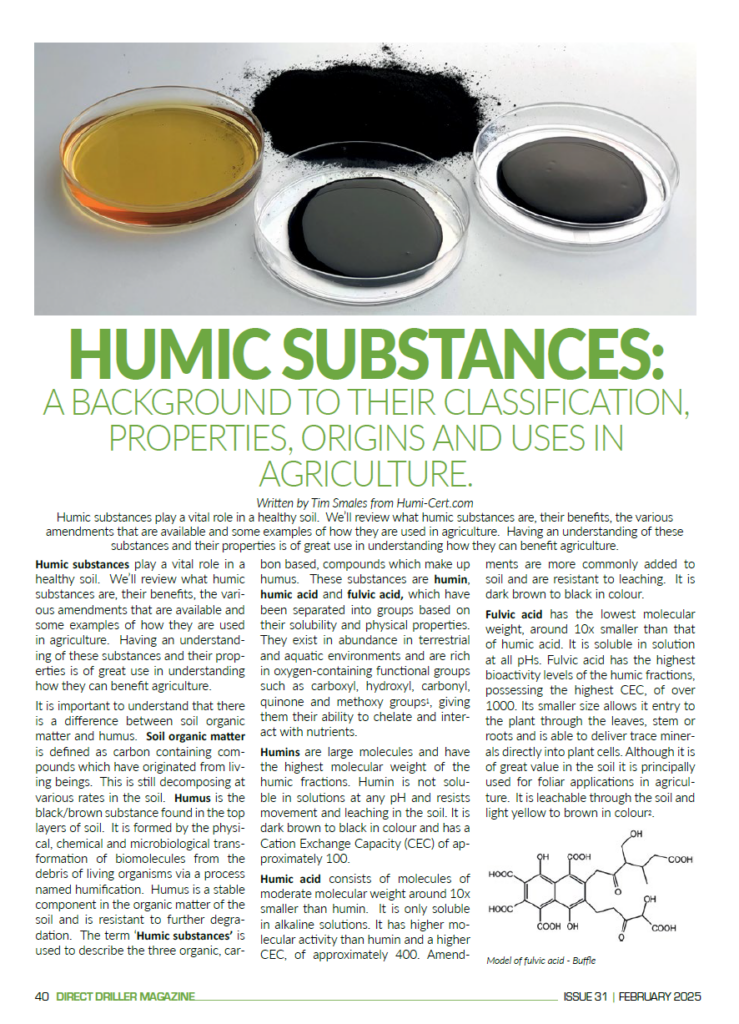
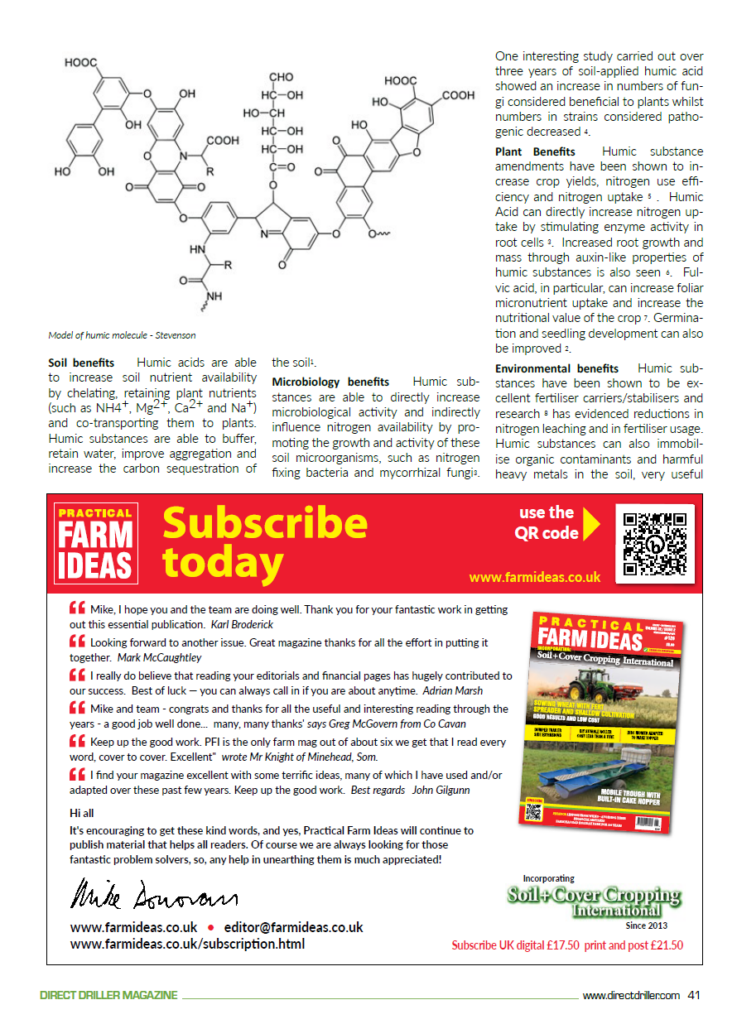
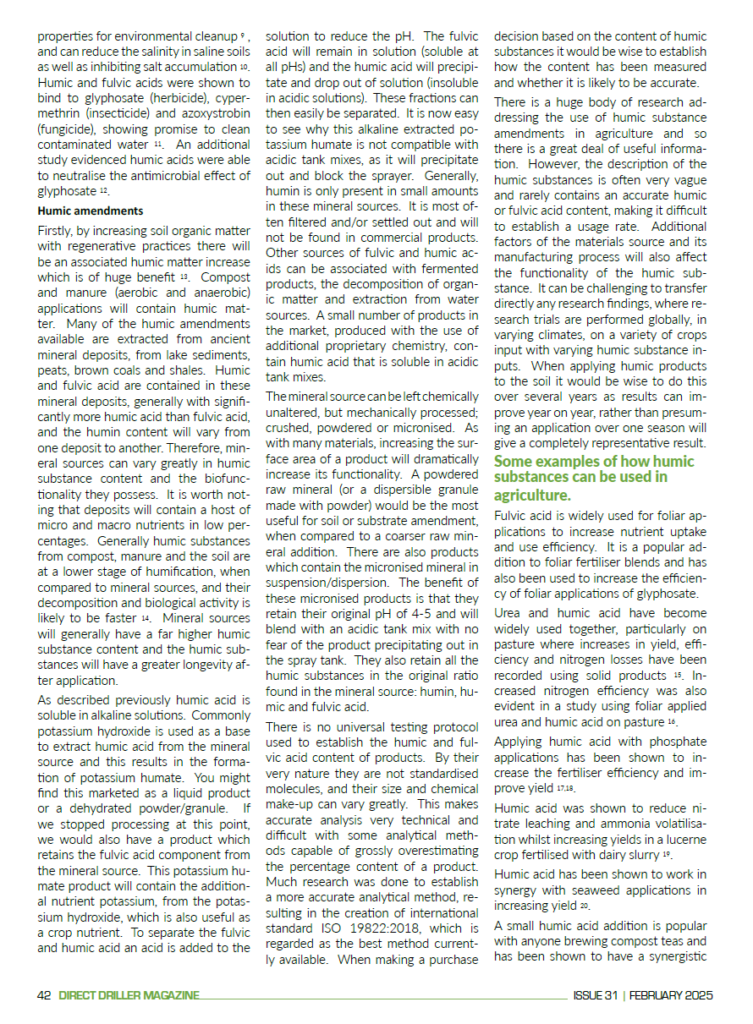
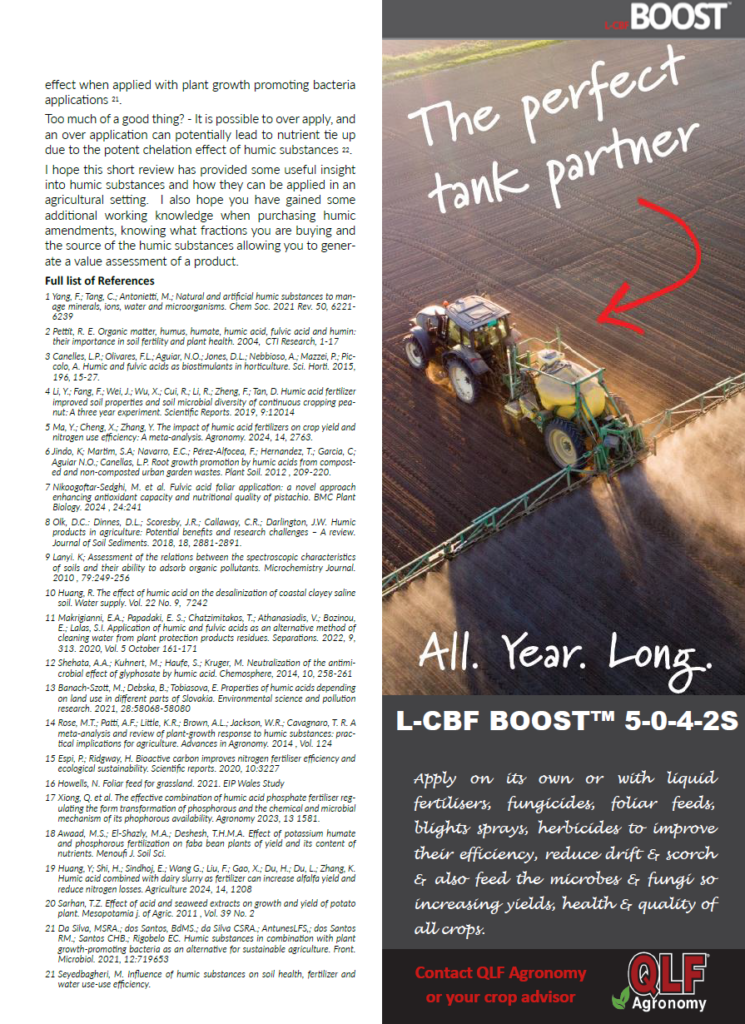
-

Plan ahead to get the most from soil sampling
Soil sampling is an essential tool in understanding the nutrient availability of soils, but unless the results are interpreted correctly it could be a wasted exercise.
That’s according to Simon Francis, Technical and Services Manager for ProCam, who explains that not only is soil sampling required for farm assurance compliance purposes and to meet the statutory requirements of an increasing number of SFI schemes, but it is also time well invested in ensuring crops can perform to their full potential.
Unless soils are sampled and tested in a timely and accurate manner, and the results interpreted appropriately by an experienced agronomist, it is unlikely the investment in soil sampling will generate a viable return.
Sampling prior to sowing any crop is key, as it provides an essential opportunity for growers to assess the nutrient status of soils and to make plans to redress any identified imbalances or deficiencies.

Soil sampling is an essential tool in understanding the nutrient availability of soils, but it could be a wasted exercise unless the results are interpreted correctly explains Simon Francis. Each field should be tested at least every 4-5 years. Some growers might elect to sample more frequently, but there’s generally no need to unless there’s a specific reason such as a change of cropping or land use.
That said, in extreme cases, for example where continuous high rainfall or an extended period of waterlogging has caused nutrient stores to be depleted due to leaching, increasing the frequency of testing could prove useful. Another example could be where a lack of organic matter prevents nutrients from being retained thus causing leaching losses to be exacerbated.
Water logging will also compromise root development in the establishing crop, affecting its ability to access nutrients. Understanding what is available to the crop during the early stages of development is therefore vital to maximise potential.
Irrespective of the soil type, the very least growers should be doing it to test each field to build a basic picture of the farm’s P, K and Mg indices as well as pH and organic matter: testing organic matter content can provide a good indicator of general soil health, from which it is possible to begin to understand the soils capacity to retain both moisture and nutrients.
Beyond this, the next step is to build a more comprehensive understanding of the macro and micronutrients available to plants, so that a tailored nutrient programme can be drawn up proactively rather than reactively during the season.

Soil sampling is essential to maximise the performance of new crops, with ProCam’s SoilSense service taking testing to the next level step by analysing not only the chemical composition of soil, but also the wider availability of macro-nutrients. ProCam’s SoilSense service takes soil testing to this next level step by analysing not only the chemical composition of soil, but also the wider availability of micro- and macro-nutrients[RA1] .
SoilSense also provides an in-depth picture of physical soil health and an advanced understanding of other key indices such as soil carbon, cation exchange capacity and structure.
Armed with this level of detail, growers will not only remain compliant with the basic crop assurance requirements plus any additional information required by the various SFI schemes, but will also be able to work with their agronomist to develop a clear and detailed nutrient programme that ensures each crop in the rotation has access to the full complement of nutrients required to enable them to reach their full potential.
For growers who want to take things even further, an analysis of the soil’s biological constituents including protozoa, mycorrhiza and saprophyte populations as well as positive and negative bacteria population dynamics can be assessed to give a full appreciation of the soil’s health.
For further information about SoilSense visit procam.co.uk or contact your local ProCam agronomist or local ProCam depot or e-mail soilsense@procam.co.uk.
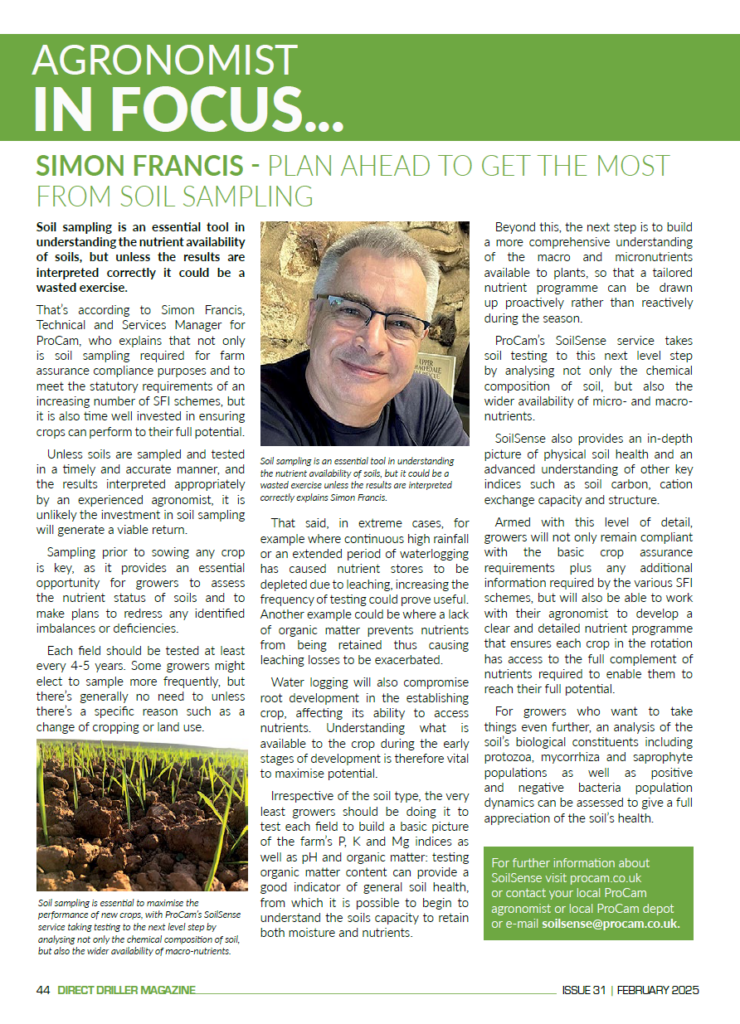
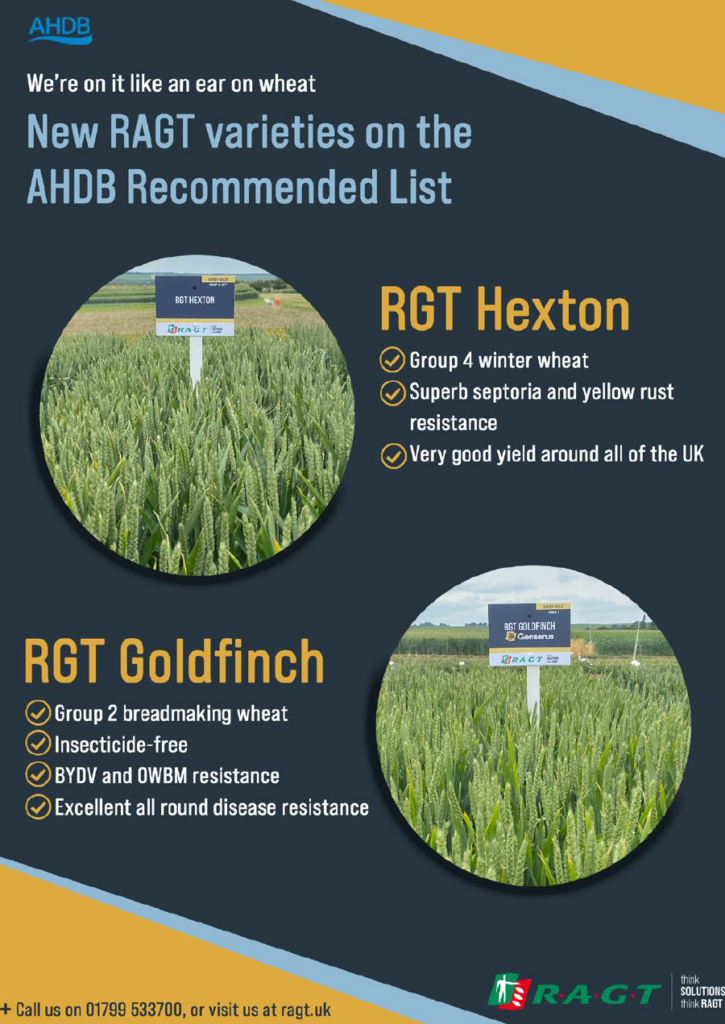
-
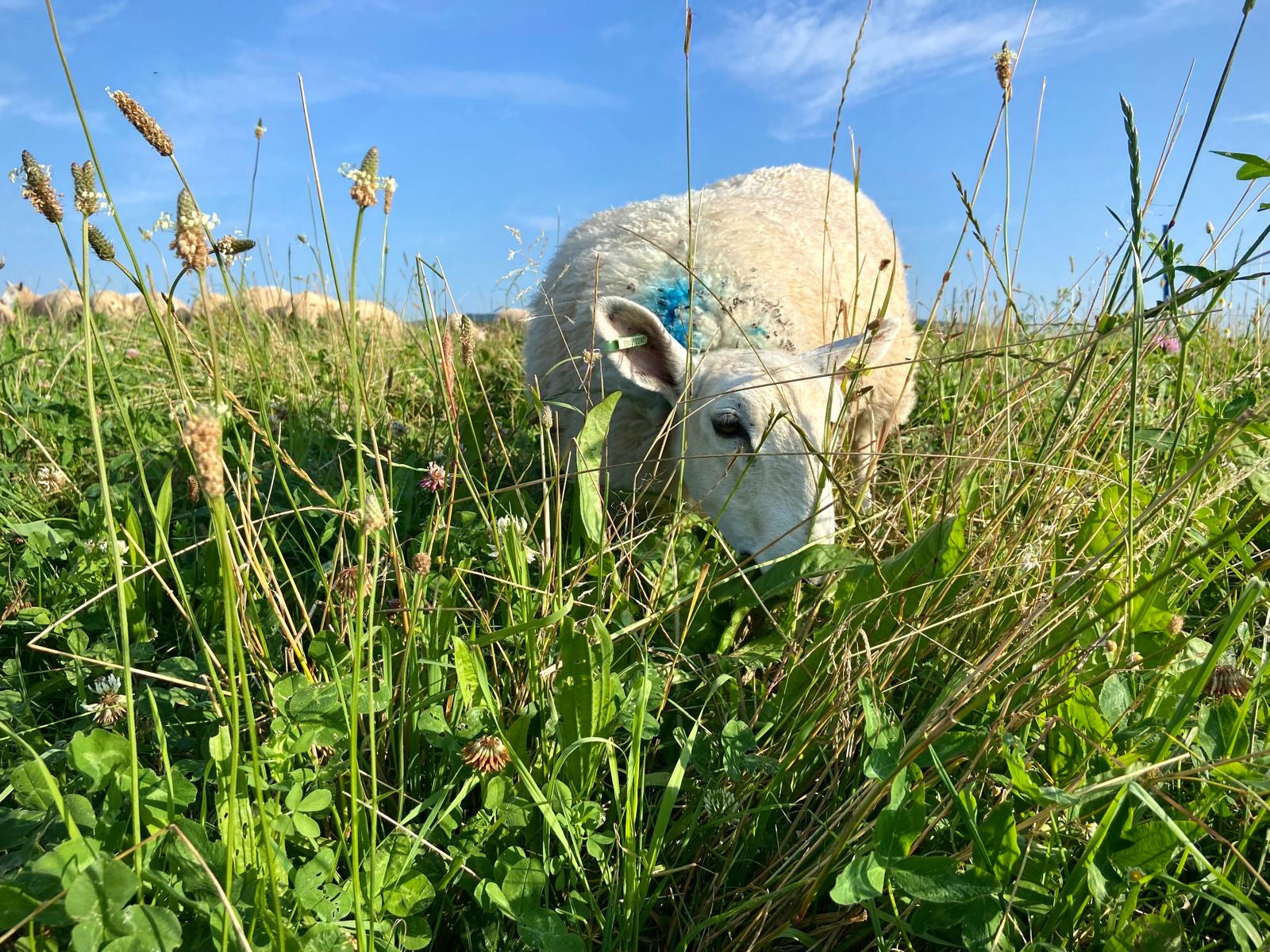
Farmer Focus – Billy Lewis
Dec 2024
Another tough year of compromises, setbacks and stress, all as a direct result of the not-so-great British weather. The lack of sunlight throughout the year coupled with the continuous and unprecedented rainfall events that we’ve been receiving really has made for a hard time, especially on the arable side of the business.
Over the past couple of years, we’ve managed to get decent catch crops established straight after harvest and had some great success direct drilling the following cereals straight in ‘on the green’. However, much to my displeasure we didn’t get a whole lot of that done this autumn, and the plough had to come out in all of its glory. A very late harvest coupled with the need for a considerable amount of remedial cultivations meant that agronomically and economically inverting the soil was the correct thing to do in a lot of places. I was delighted when the first furrows came over in a wheat stubble to reveal a soil that was in beautiful condition. It was very reassuring to see the effects of the direct drilling, grazed cover crops, compost applications and companion cropping that had been carried out on that block of land over the previous three seasons. The oats that are now growing there look absolutely stunning.
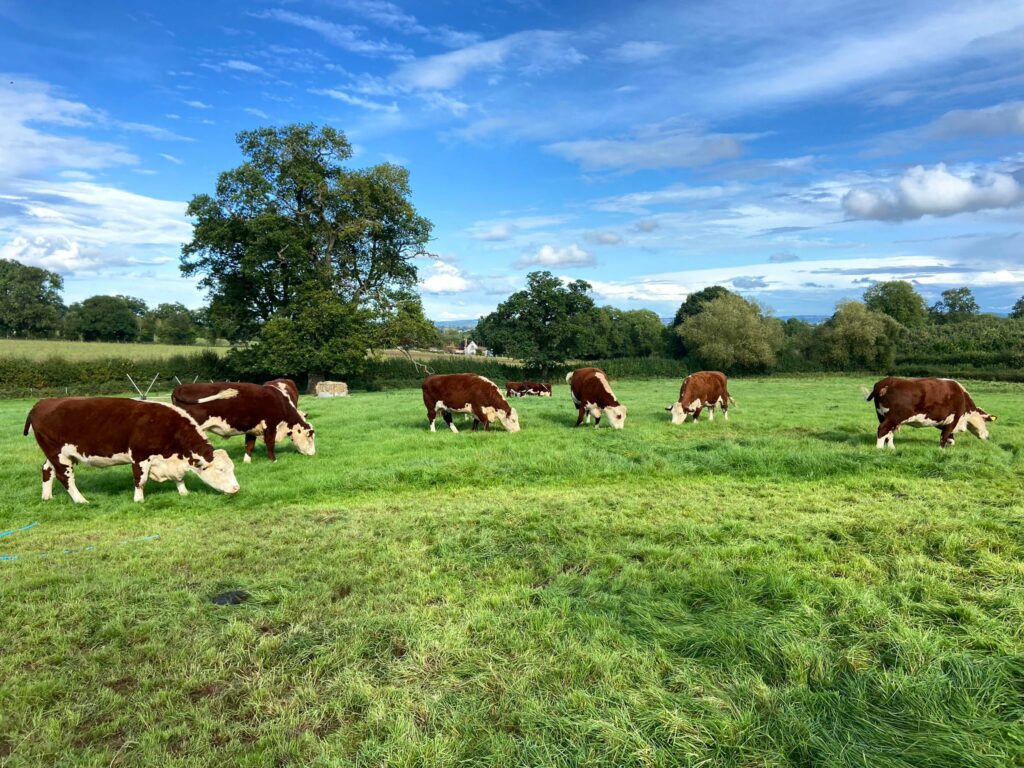
Rotational grazing We did manage to get some winter wheat direct drilled. This went into land that was summer cover cropped in place of spring beans. Conditions were too wet in the spring and time was ticking on so I decided against putting the beans in the ground, a decision I don’t have any regret about given the equally damp conditions at harvest time. The wheat is now sitting pretty amongst a sea of volunteer summer cover crop species, these will be taken out with a cheap herbicide in the spring. Typhoon is the variety of choice for this year. A feed wheat which in theory should be high yielding and have a very good resistance to disease. This will hopefully help us in our ongoing quest to continue cutting pesticide use. If I like what I see I will make sure to get it planted a lot earlier than mid-October next autumn, as it is has been very slow to get going.
The long-term economics of cereal production in this country are a great concern of mine, as I’m sure they will be for every grower currently. Hopefully our low input, dynamic system will stand us in reasonable stead to take on the weather, uninspiring markets and ever-increasing costs. Thankfully livestock production is proving slightly less of a challenge at the moment. Continuing strong markets for beef and lamb are helping confidence levels in the sector.
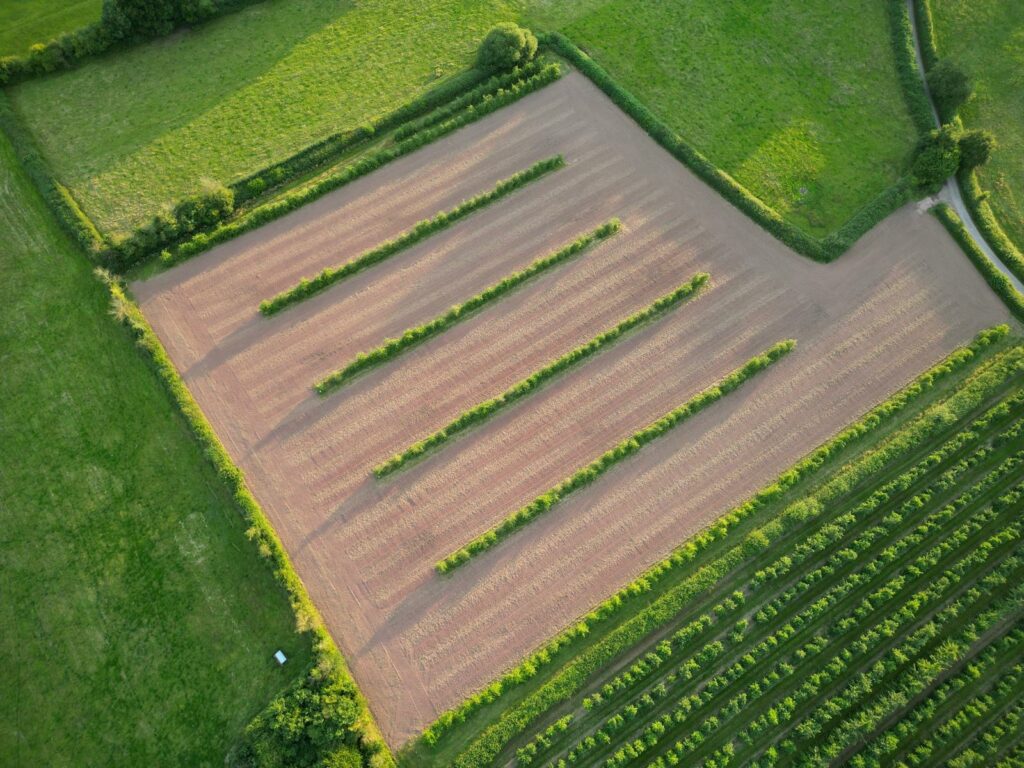
Alley Cropping from above I hate to keep coming back to it but the rain caused issues in the spring. Lambing was seriously hard work and it was only by mid-April we were able to turn all of the cattle out. This is a month later than we would aim for. The sun did eventually come out and the grass grew, and fast. We had a huge amount ahead of our livestock throughout the summer. The fact there was never any period of drought helps. However, the main reason for the very satisfactory growth, I am sure is our management. We’ve really cracked the art of rotational grazing and the benefits for the soil as well as the livestock are so clear to see. I’ve given up moving sheep every day when they’re grazing grass, cover crops though are a different matter. I don’t think they particularly enjoy being constantly on the move and it takes far too much of my time. I’ve found that twice weekly moves is the sweet spot. Cattle I move every 48 hours when possible.
This year we took a commercial cider orchard that we had previously rented out back in hand as the contract for the apples which were grown in it had come to an end. It’s common place in this scenario to pull all of the trees out and revert the field back to arable cropping. Instead of this we opted to leave around a quarter of the trees in place. By leaving every fifth row of trees untouched we’ve ended up with perfectly spaced 24 metre alleys. I was nervous that the sprayer wouldn’t be able to fit down the rows properly, but as it turns out it fits perfectly so we can now use the field as part of our wider rotation of growing cereal crops as well as grazing livestock. I’m looking forward to the day when there’s a group of Hereford cattle contently grazing a diverse herbal ley amongst rows of apple trees. It doesn’t get much more Herefordshire than that!
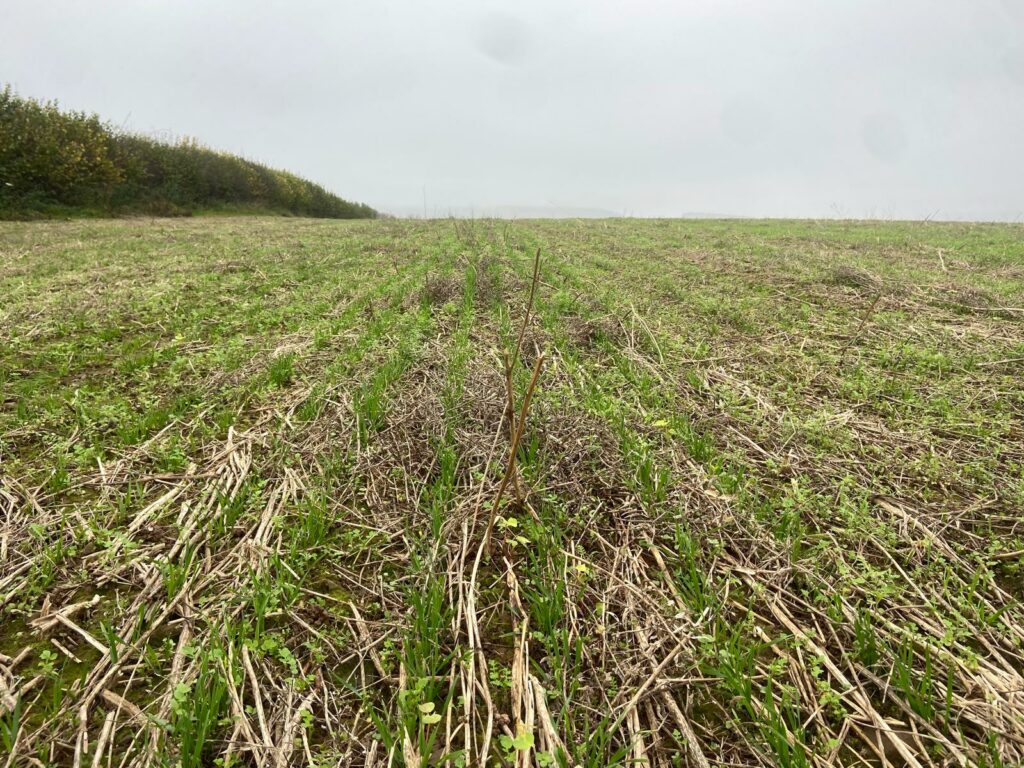
Direct drilled wheat 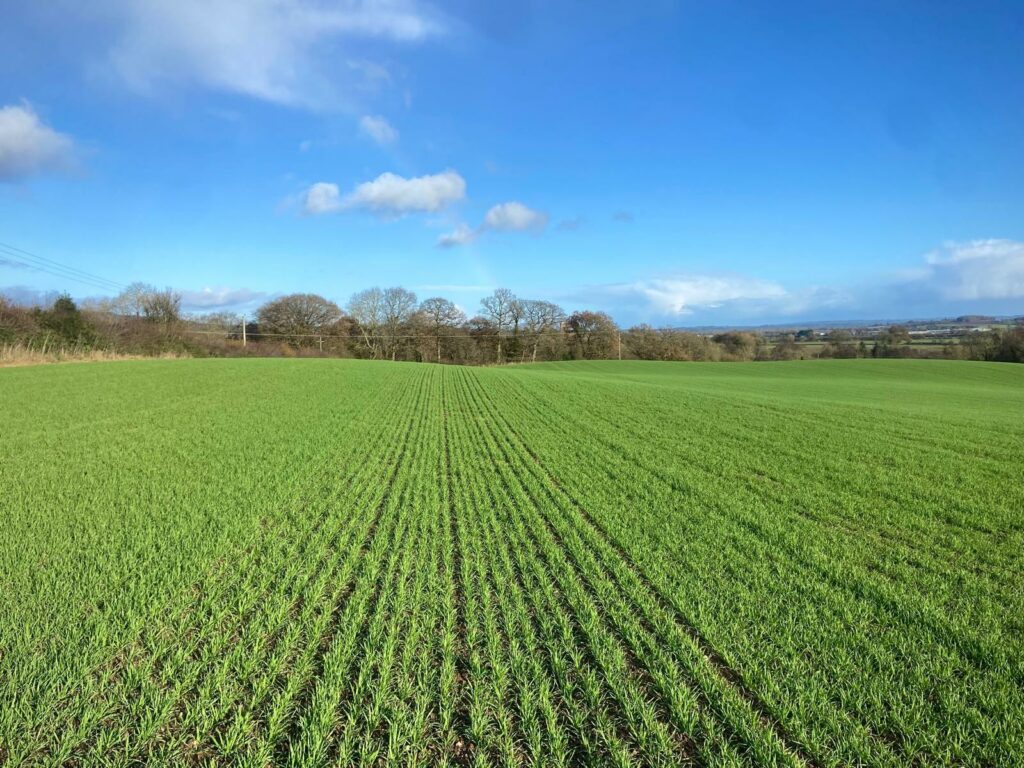
Oats Farm Bio – Billy Lewis farms 140ha in North Herefordshire in partnership with his parents. They keep Hereford cattle, sheep and grow combinable crops. He also contract farms an additional 110ha.


-

Two RAGT wheats gain full UK approval on AHDB’s 2025/26 Recommended List
Breadmaking wheat RGT Goldfinch and soft wheat RGT Hexton made the list after a very strong performance in trials and on farm.
RGT Goldfinch
RGT Goldfinch, the first high quality breadmaking wheat that is resistant to barley yellow dwarf virus and orange wheat blossom midge, has gained full UK approval on AHDB’s 2025/26 Recommended List.
The Group 2 variety is the latest wheat to emerge from RAGT’s Genserus breeding programme, which provides season-long protection against BYDV.
“Using genetics rather than insecticide to prevent BYDV infection greatly simplifies crop management,” says RAGT’s arable technical manager Andrew Creasy.
“It removes the need to monitor and control aphid vectors for less than the cost of buying and applying a single pyrethroid spray, which is good news economically and environmentally.”
Additional resistance to orange wheat blossom midge means RGT Goldfinch growers can apply with confidence for the £45/ha payment under SFI for growing an arable crop without insecticide.
“The variety has good protein content and an excellent and resilient Hagberg score, which, along with encouraging results in provisional milling and baking tests, underlines its potential as a breadmaking wheat,” says Andrew.
RGT Goldfinch has an outstanding foliar disease-resistance profile, better than any other Group 1 or 2 on the Recommended List. It scores 8 for mildew resistance, 9 for both yellow and brown rust resistance and 7 for Septoria tritici resistance.
It is best suited to well-bodied land and can be sown from early September, ideal for a BYDV-resistant variety, to the end of November. It produced very high yields under BYDV pressure in RAGT trials and in commercial situations last season.
“Overall, RGT Goldfinch is a robust wheat that will withstand disease and pest pressure better than most,” says Andrew. “It can be relied upon to deliver high quality grain.”


Key Strengths:
- Very strong disease profile
- Clean, consistent, and sustainable
- The UK’s first quality wheat resistant to BYDV and OWBM
RGT Hexton
RGT Hexton is a barn-filling Group 4 soft wheat with a good disease resistance package, making it a strong contender on farm next autumn as growers look to replace older varieties coming under increasing pressure.
This newly recommended variety is the highest yielding Group 4 soft approved for distilling, with a UK yield of 105 and an exceptional 111 in the north.
“RGT Hexton’s output has been consistent wherever it is grown,” says RAGT’s arable technical manager Andrew Creasy. “It produces the goods as a first or second wheat on light or heavy land and can be sown from the last week of September onwards.
“Growers don’t have to worry about pushing harvest back too much, as it is a medium-maturing type with short stiff straw and a decent specific weight, providing useful insurance if harvest is delayed.”
RGT Hexton has good resistance against Septoria tritici and yellow rust (both scored at 7), with a 6 for mildew and 5 for brown rust.
It is also resistant to orange wheat blossom midge, a prerequisite for the increasing number of growers turning away from insecticides.
“We think RGT Hexton will have widespread appeal across the UK,” says Andrew. “The variety has no Achilles heel, and the combination of an exceptional yield and suitability for distilling make it even more attractive for growers in the north.”


Key strengths
- Consistent across soil types and rotational position
- Very high yields across UK, exceptional in north
- Stiff strawed, good specific weight
- First or second wheat
- Wide sowing window


-
Planning for silage success 2025 – using AgTech to fine tune decision making.
Improving quality and producing the right quantity for the animal numbers on farm takes planning and it starts with the soil, test so that you know what you already have on farm in the soil, in the slurry/FYM means than when the conditions are right the correct amount of nutrients can be applied to the grass. Digging a hole to assess compaction coming into Spring and addressing it at the right depth and timing can improve yields by up to 20% and soil health improvements creating resilience through the season, alongside working towards eliminating the causes.
2024 saw low protein levels in grass and silage, low levels of crop nutrition, following extremely high levels of rainfall the season started off with low soil nitrogen, this compounded by the difficulty in applying fertiliser and slurry due to wet ground meant that the season was late starting, although the grass was still growing generally it was poorer quality. To mitigate this having a plan to get some fertiliser and/or slurry out early if it is dry will encourage early growth, fresh grass testing can give a good indication of where the nutrition is alongside walking the fields in February. Having your Nutrient Plan ready to go and deciding on cutting date at this point will mean that you are setting your goals and then when the soil is warm enough to apply nitrogen you can adjust the amount to ensure you are nitrate free by the planned 1st cut date. If using contractors get them booked early as early as possible to take advantage of fast-growing grass in the Spring, getting two cuts in before the end of May will increase the quality of the cuts and whether you are planning 3, 4 or 5 cuts whatever the season brings the energy and protein is banked in the clamp for winter. Multi cut does reap rewards when it comes to increasing quality and quantity of silage and gives more chances to get it right, focussing on ensuring top quality grass silage also has financial benefits. The numbers will be individual to each farm but in every case increasing ME/kg of Dry Matter will improve the bottom line, each mouthful eaten has increased energy density meaning more return on investment from home grown forage, focus on yield of energy per hectare, if the numbers are not where you want them implement change to improve it, whether that’s improving the grass leys to new varieties, preserving the energy in the clamp using a quality silage additive, or changing the maize variety to early harvest early with higher starch.

Using technology to help with decision making at each step of the process backs up application of fertiliser, for example Cordulus weather stations have soil temperature readings so knowing if the timing is right for the first application of Nitrogen and ensuring that the forecast is accurate to your geography is not only better for the crop but also for environmental considerations and reducing waste of valuable resources. The use of accurate data enables decision making on a daily basis to get the most of on-off grazing on the shoulders of the season, maximising every opportunity to graze grass is another way to reduce costs and optimise the resources already available on farm, if the winter is mild and the grass is continuing to grow there is a risk of too much cover in the fields which will reduce quality, on-off grazing will help avoid poaching fields improving the longevity of the sward. With grazed grass still the most cost-effective way to feed animals every quality graze is beneficial to the bottom line, AHDB research says that for a 100 cow suckler herd an extra day at grass is worth an extra day at grass is worth £125 per day, for dairy cows that return goes straight in the tank at reduced cost. Knowing what is in the field can be made easier by using Omega Crop grass prediction tool, this not only gives DM cover per acre but predicts 7 days in advance using grass growth modelling combined with weather so its accurate for your fields daily.

Using data to help decision making on farm gives incremental gains, matching forage quality to nutritional requirements working with and alongside the nutrition team to optimize home grown forage will see improved bottom line, animal health and sustainable crop production, monitor and measure your results after each cut to make any adjustments necessary to ensure results stay on track. With ongoing data collection this will help with reviewing the season and noting what works well on farm and the areas for improvement.
Farmer’s View

Adam and Georgina Roberts of Trye Farm, near Penzance Cornwall supply to Arla and have been using data from both Cordulus weather station and Omega Crop for the last two years, Georgina says ‘it’s just easier to make decisions and its one less thing to think about’ with a grazing based system of 200 cross-bred Holsteins, Norwegian Reds and Jerseys, they aim to graze 11 months of the year and aim for over 60% milk from forage. With a tight autumn block calving system over 222 Hectares it is essential that everything in the system is working optimally and combining the data from accurate weather forecasts which has always been a challenge for their farm previously together with the grazing data its much simpler to make the right decisions quickly. We can move onto the next task and be cow focused knowing they are making the best of resources.


